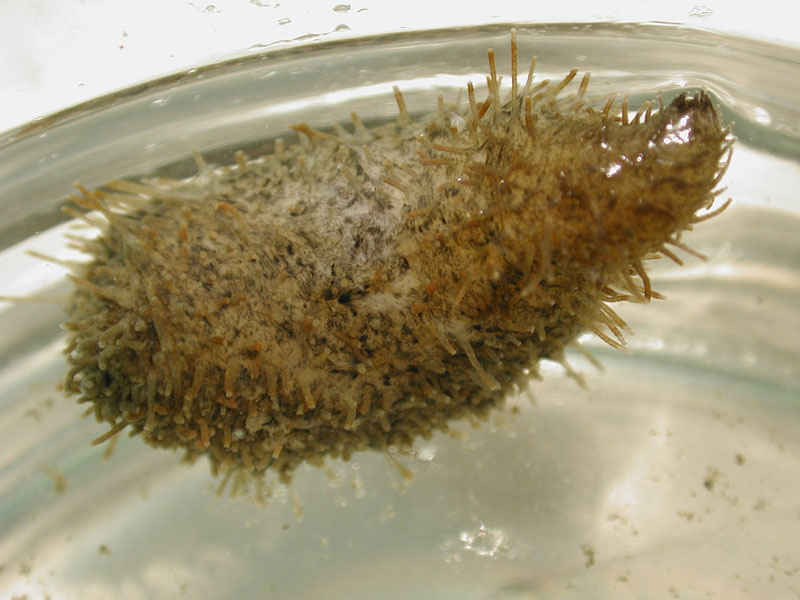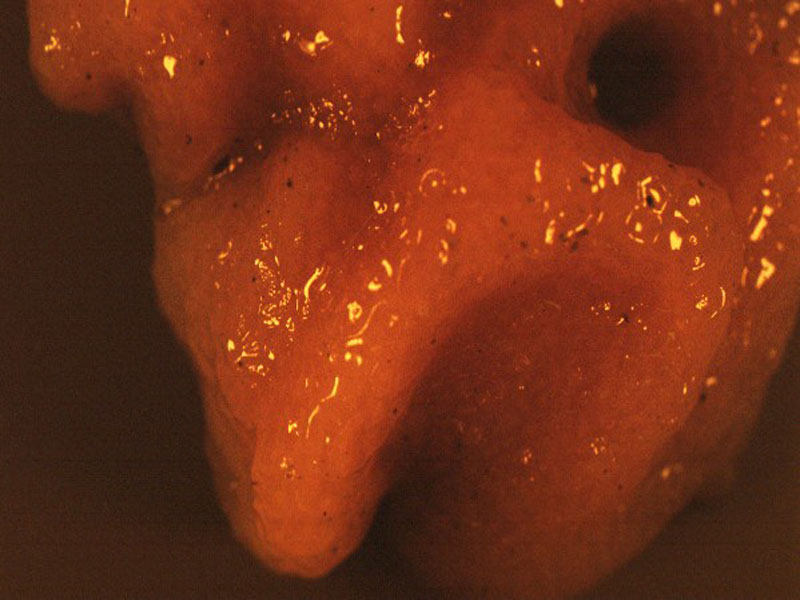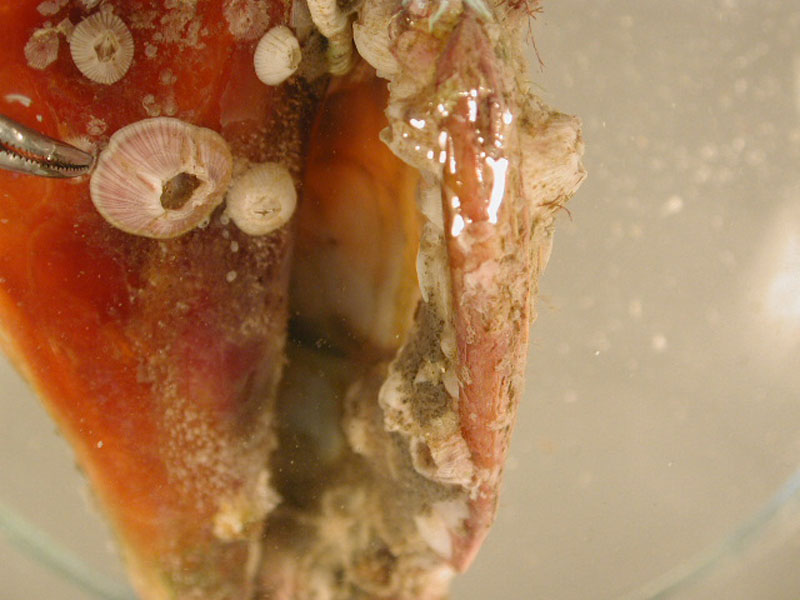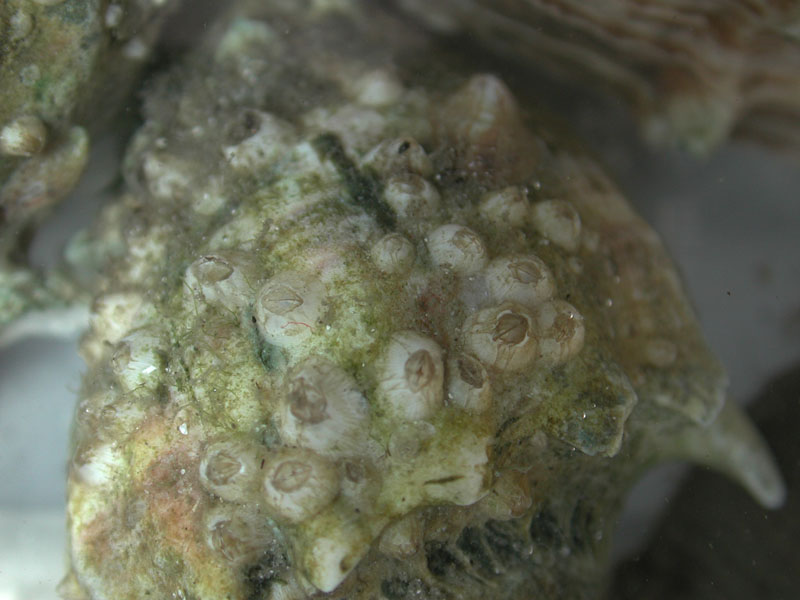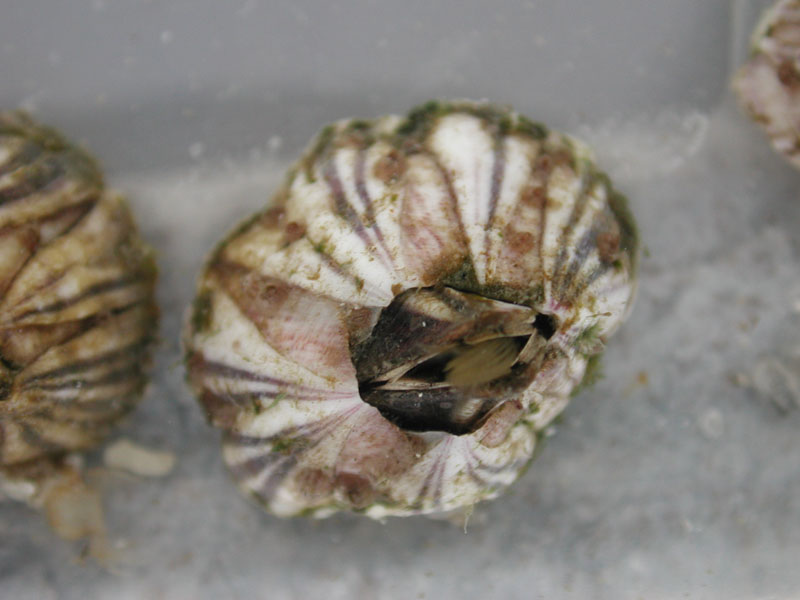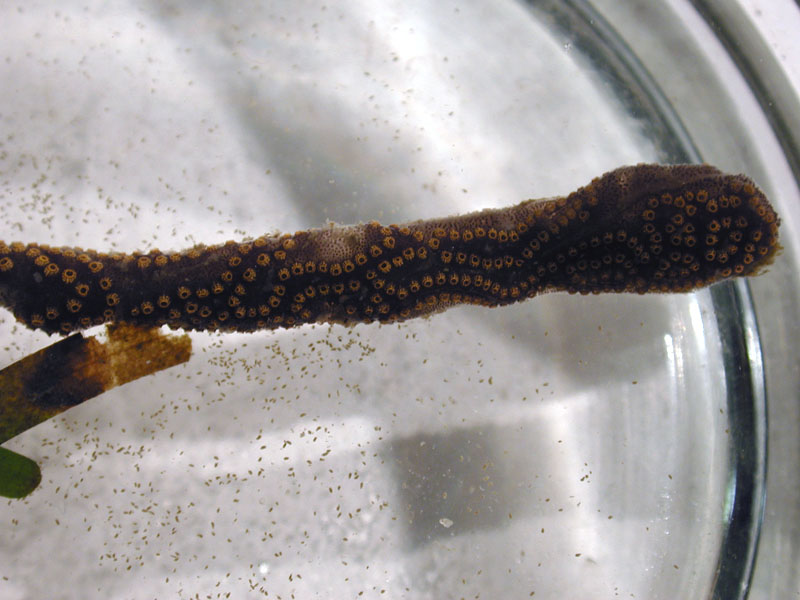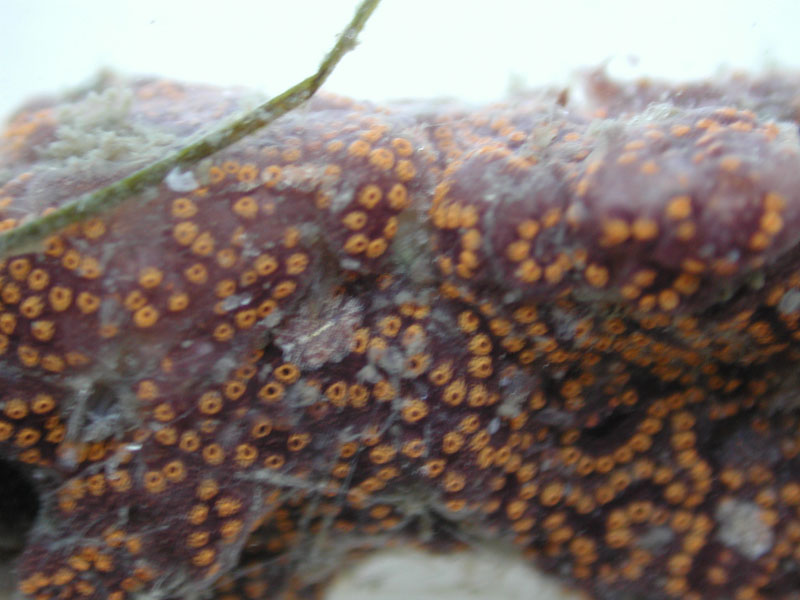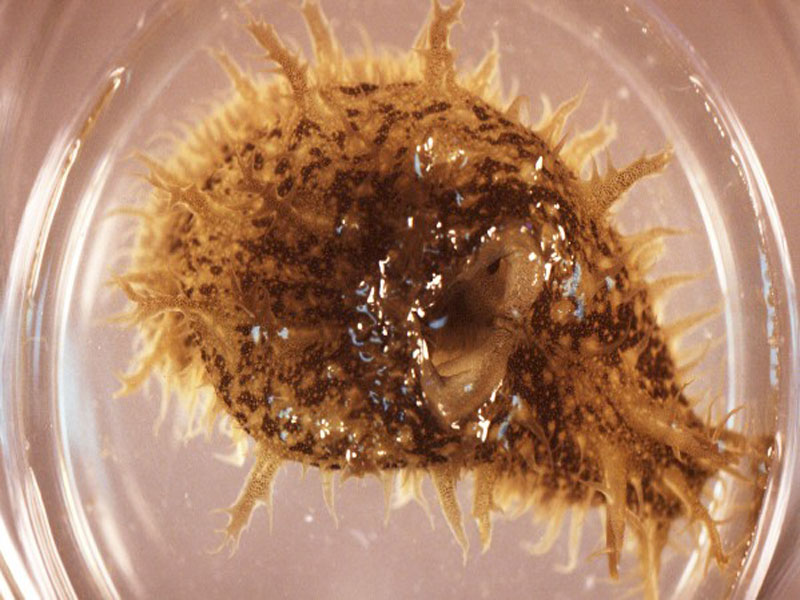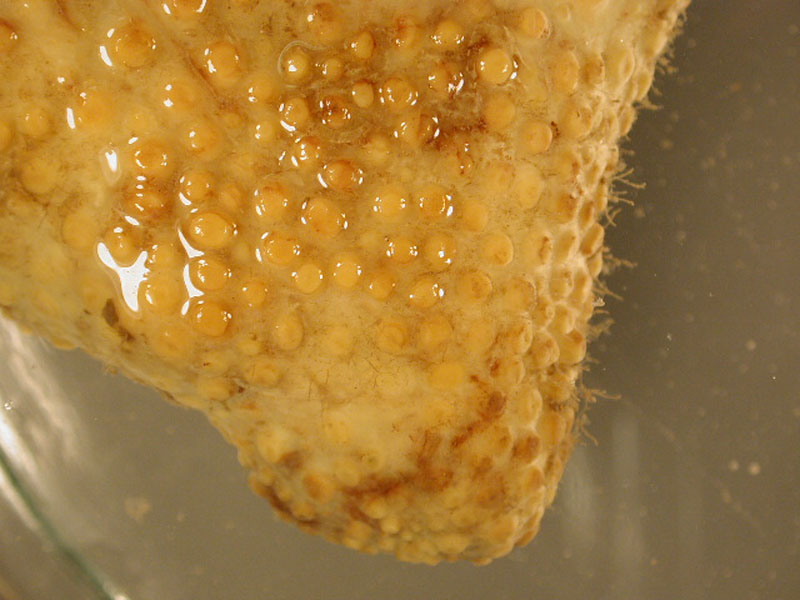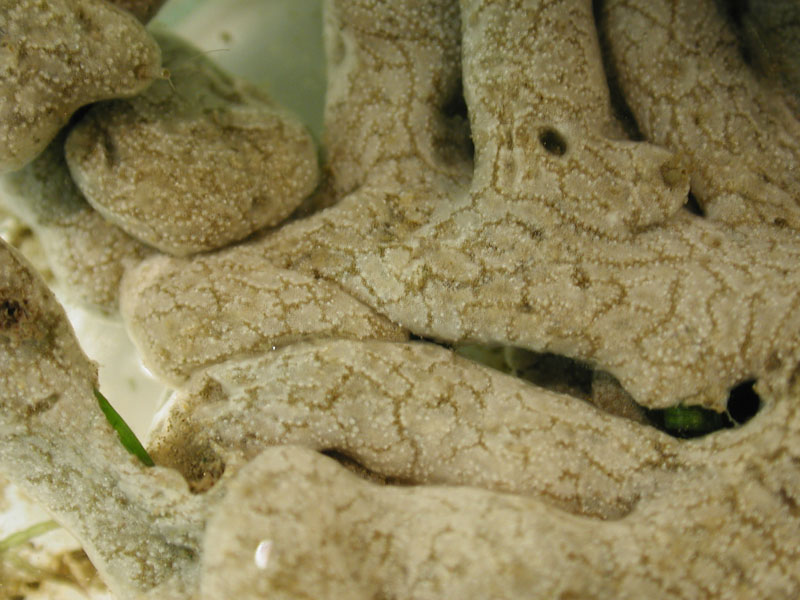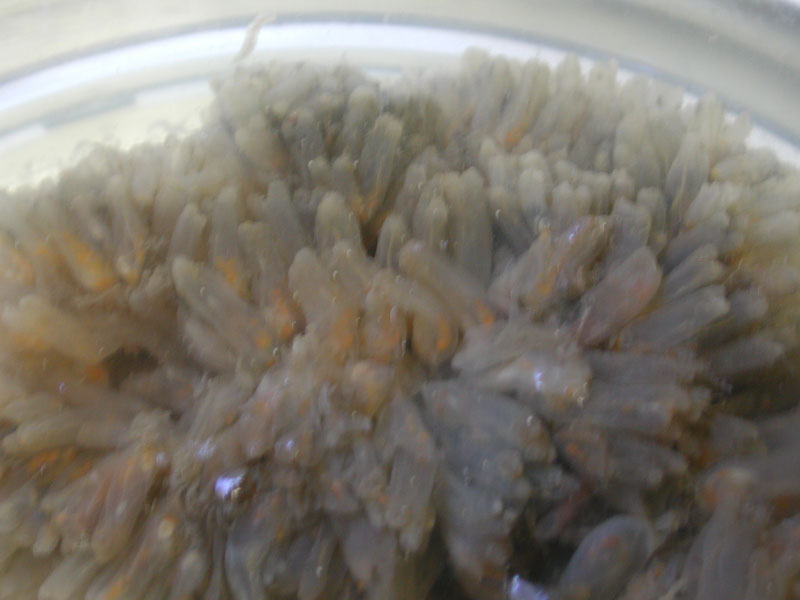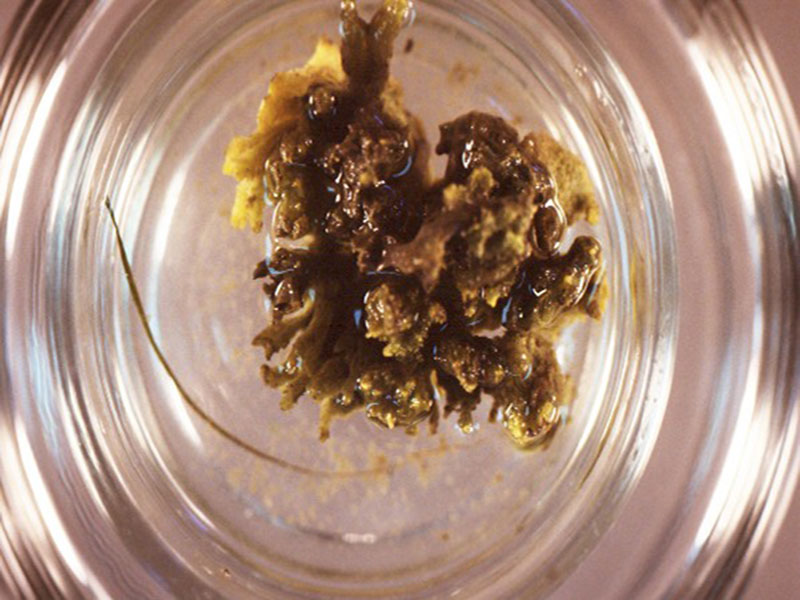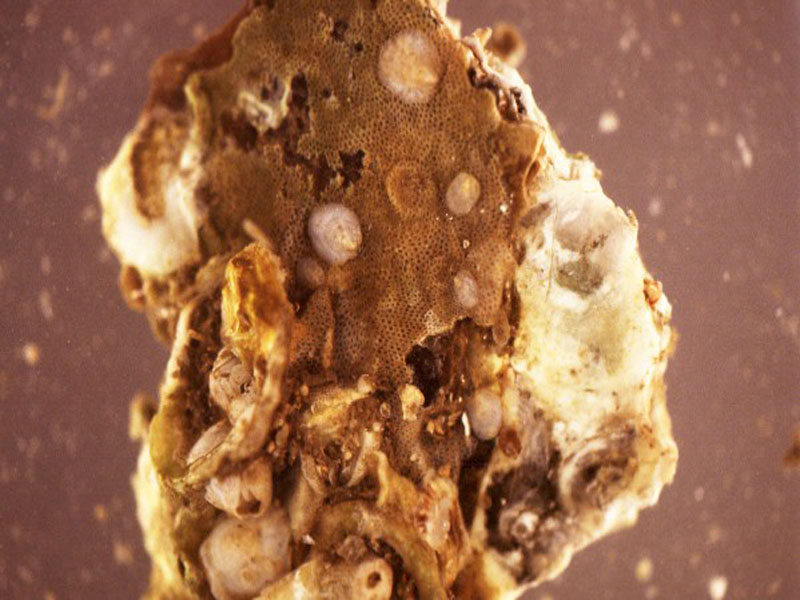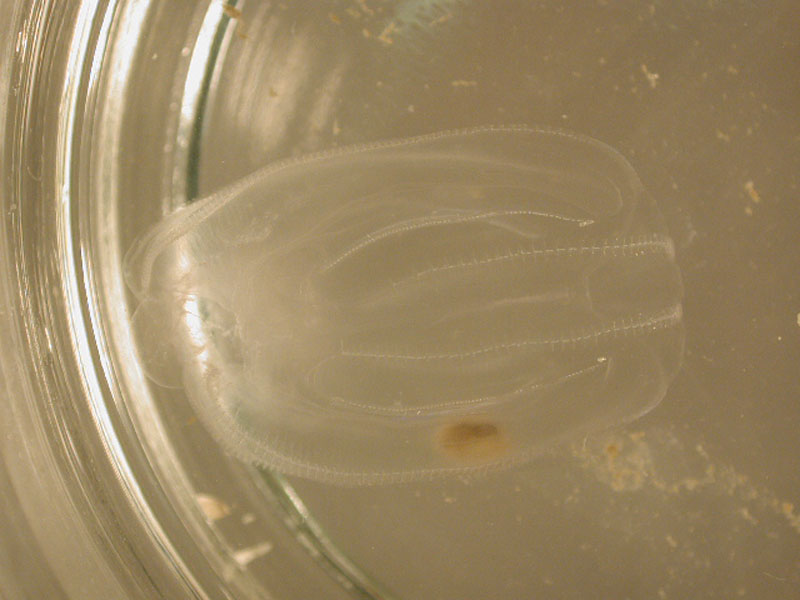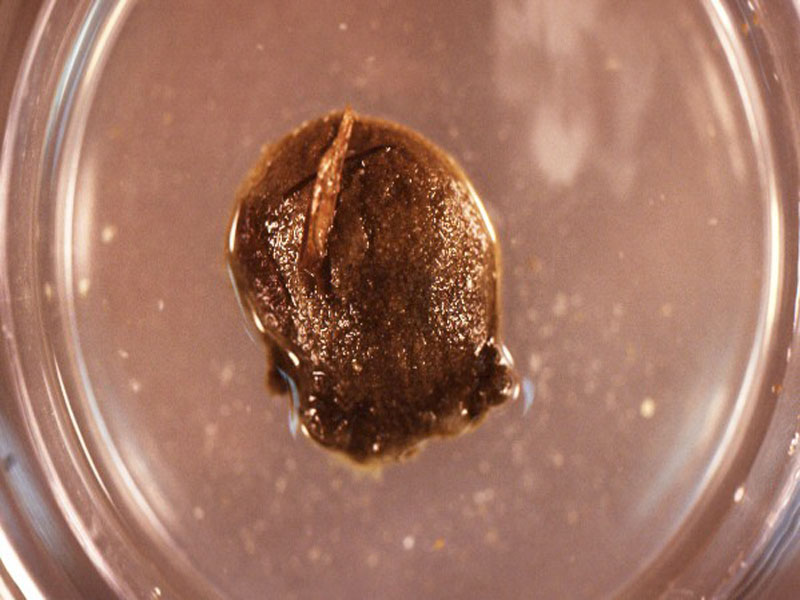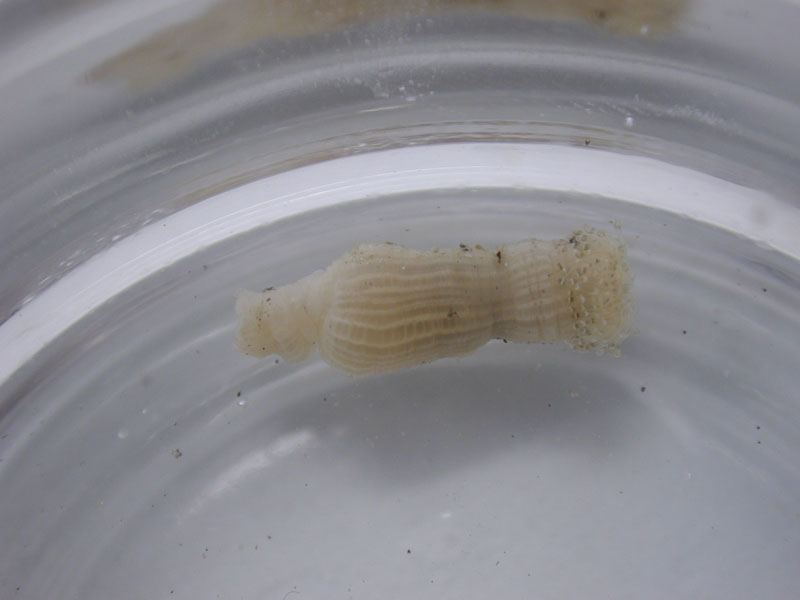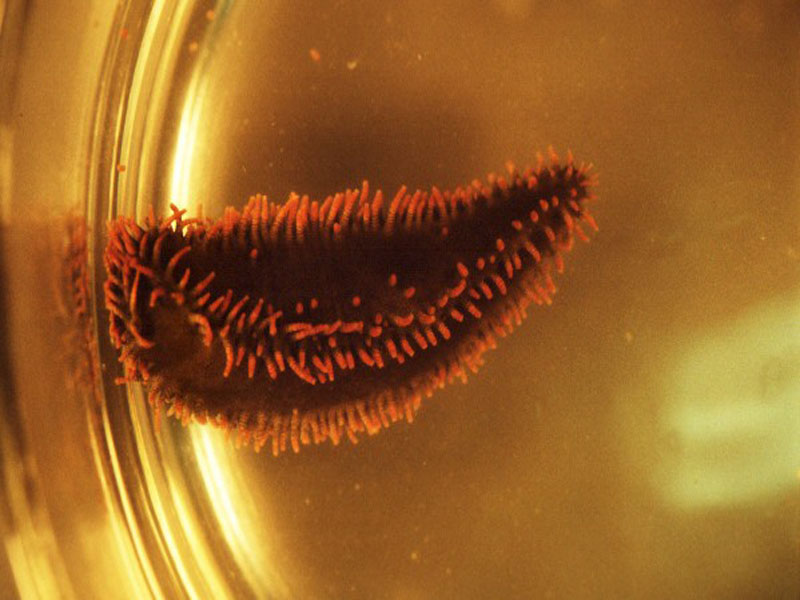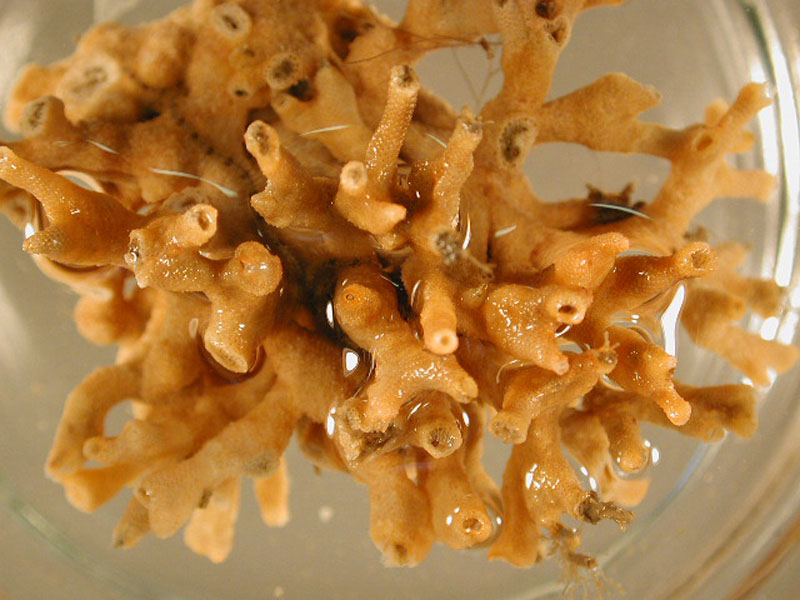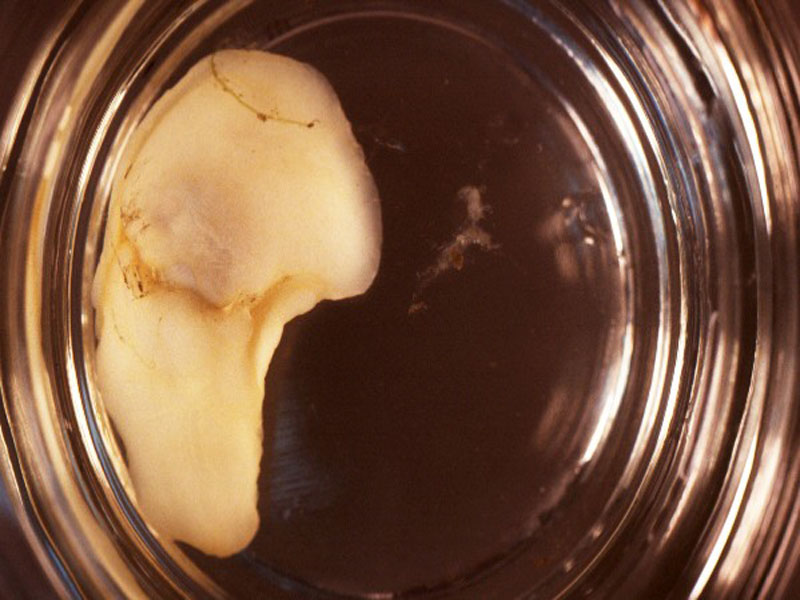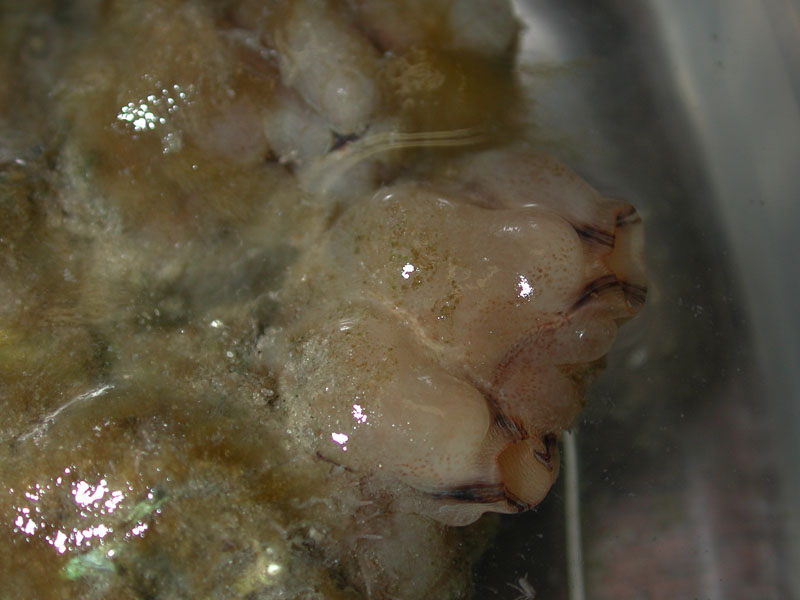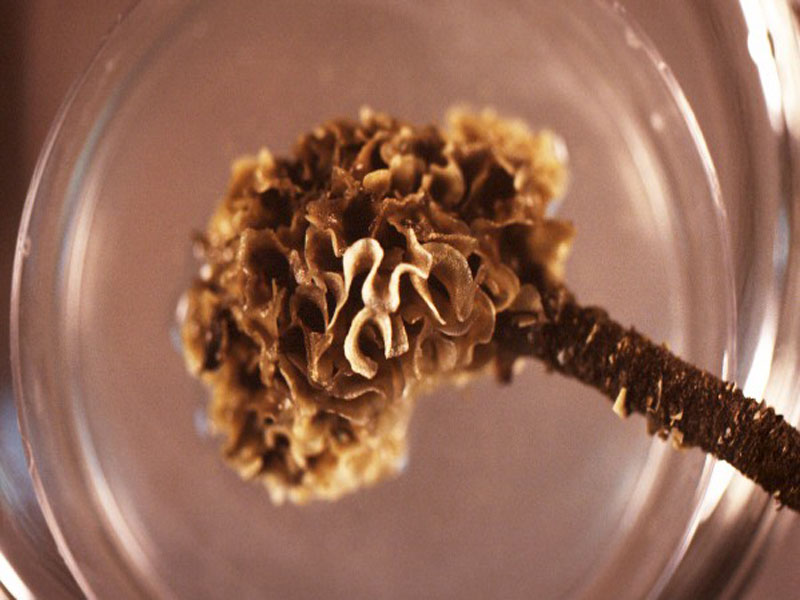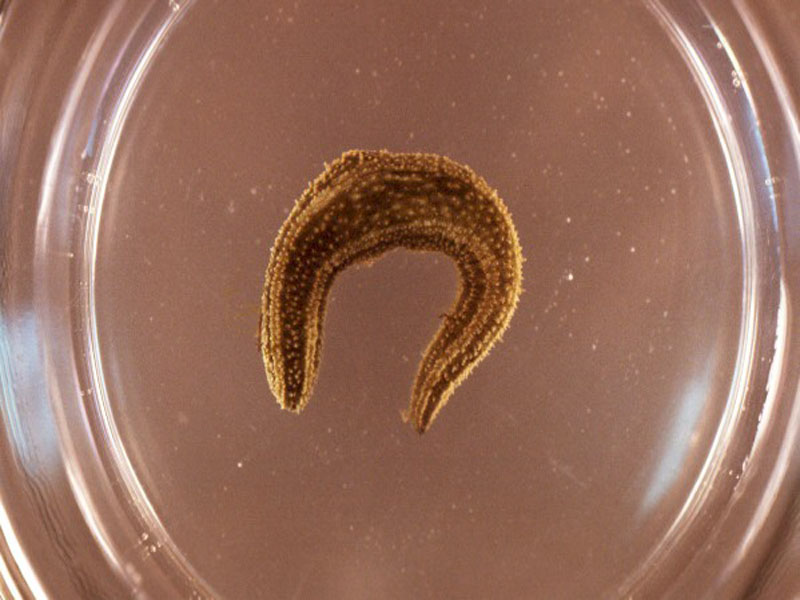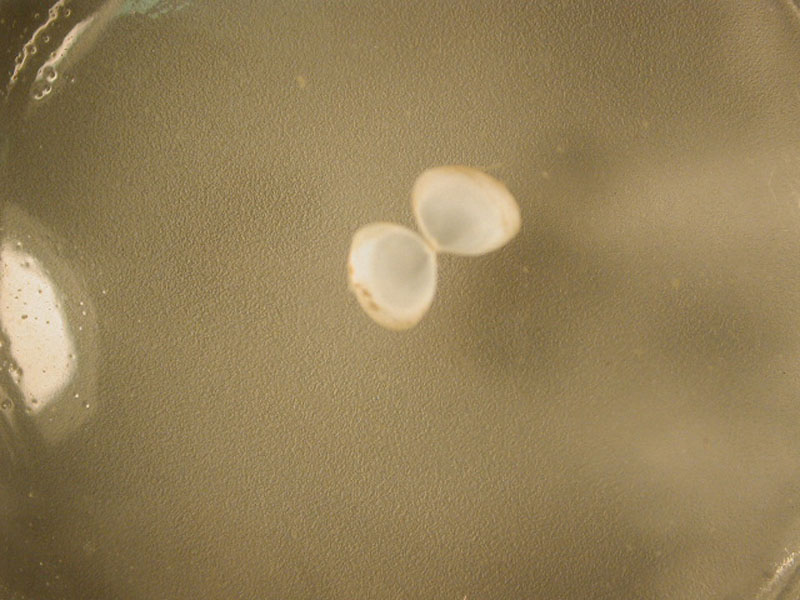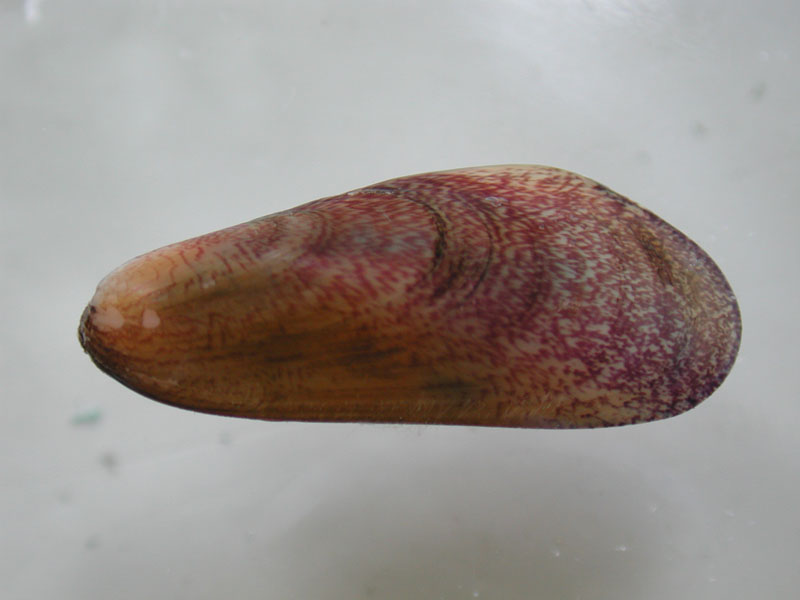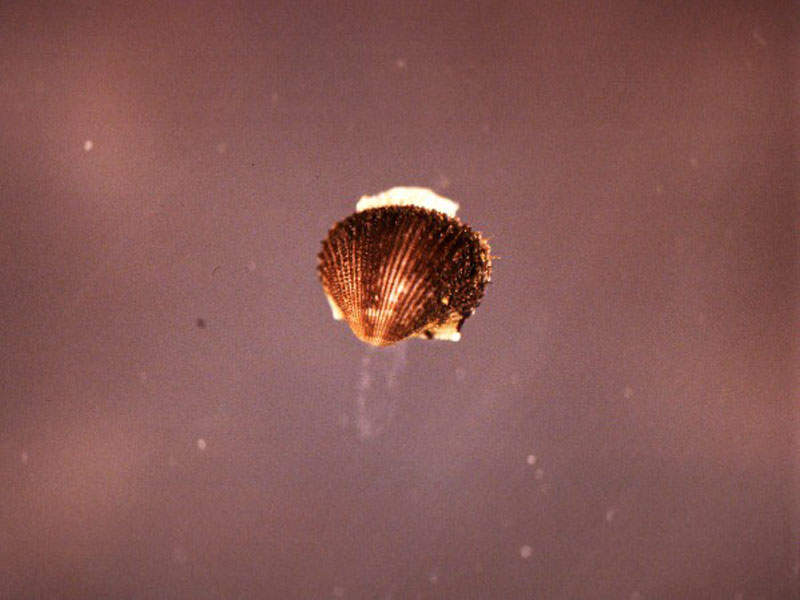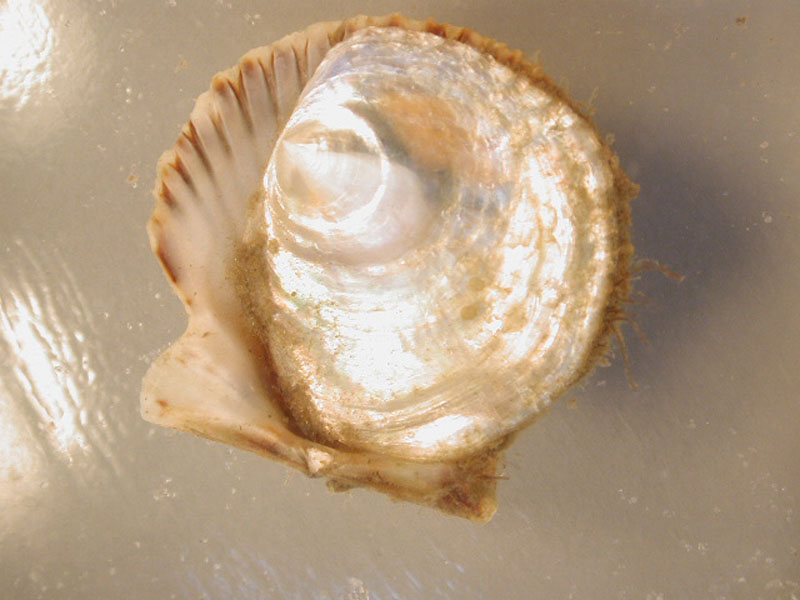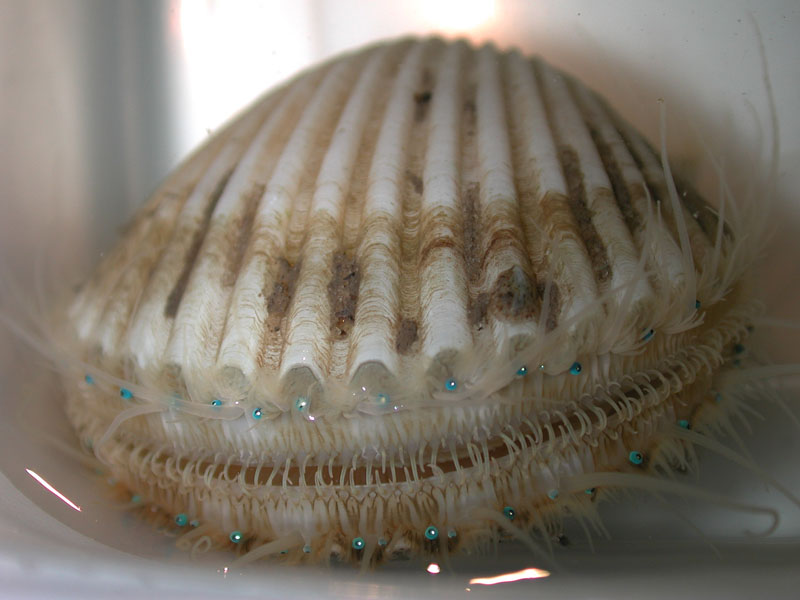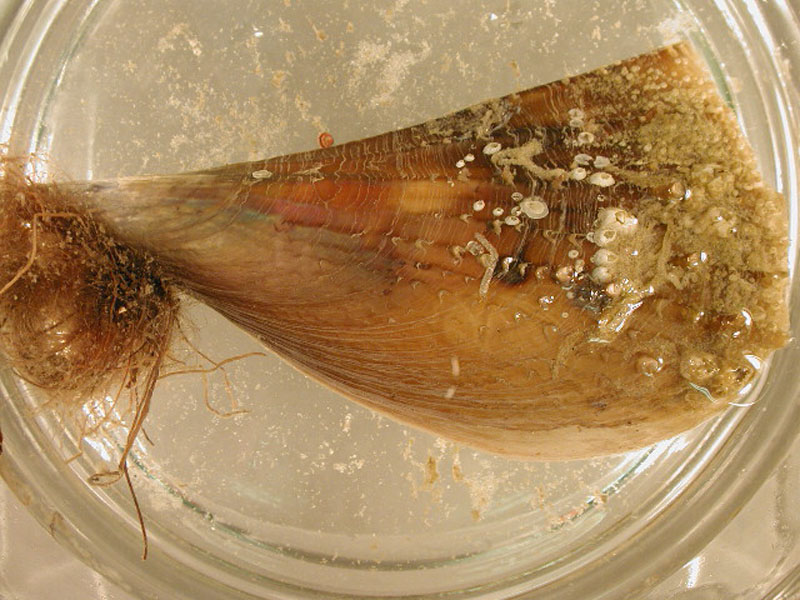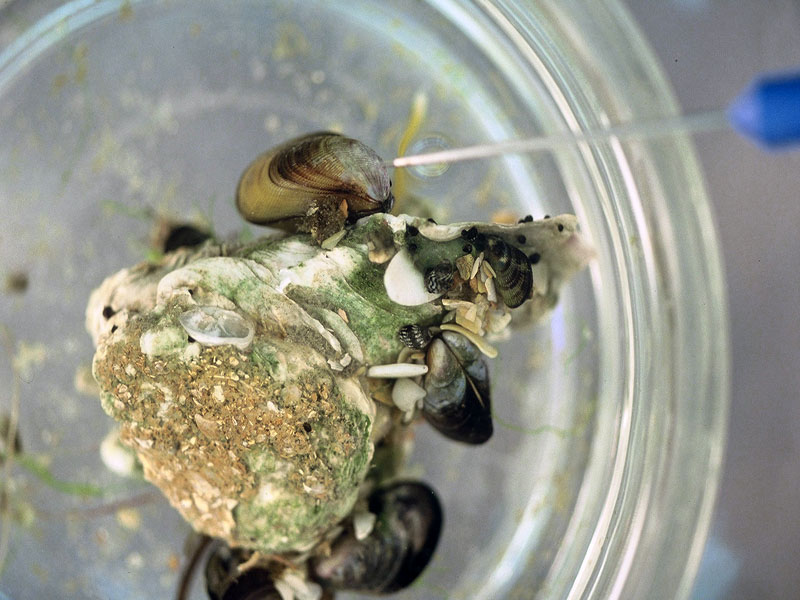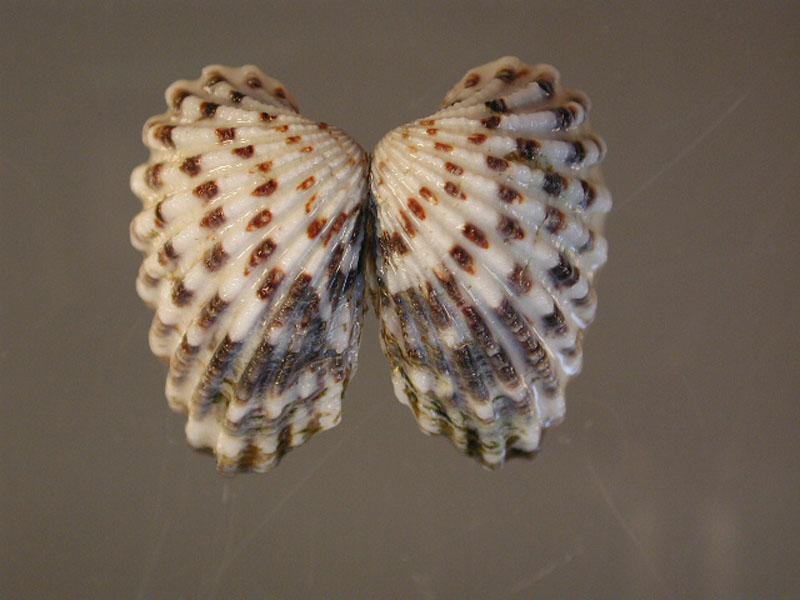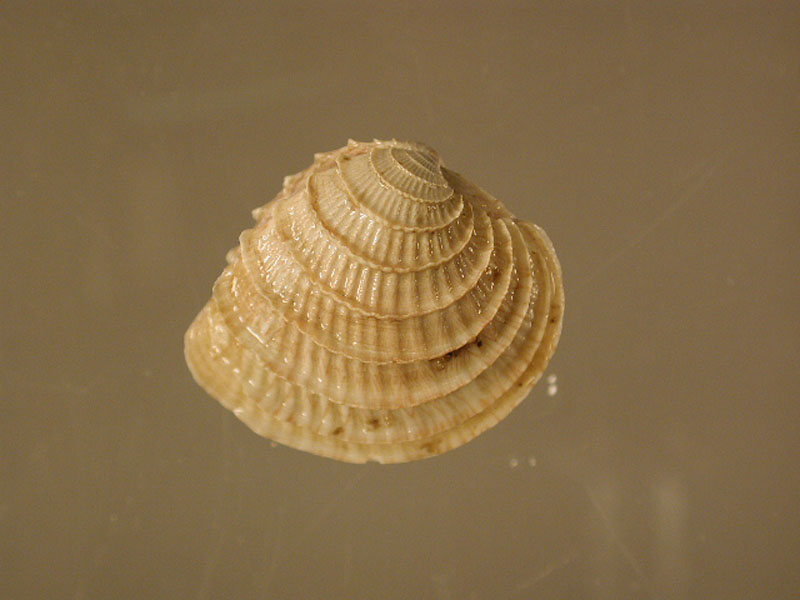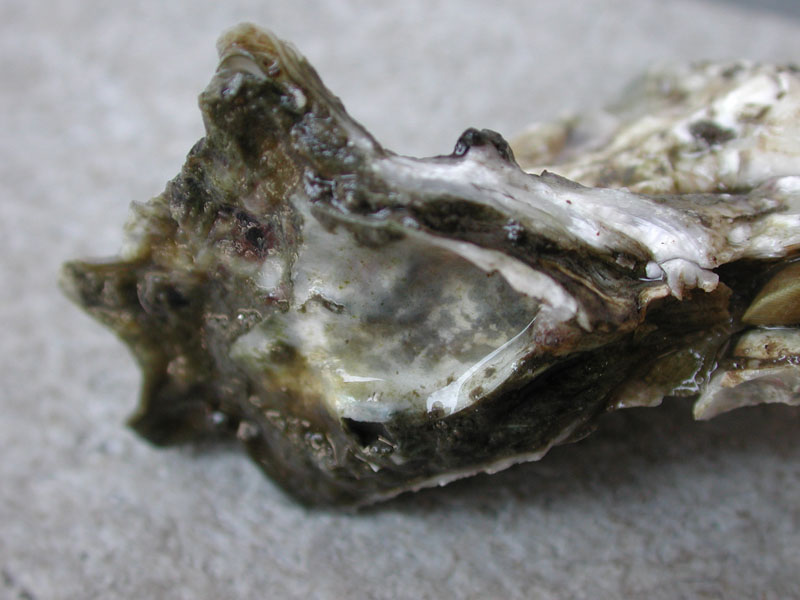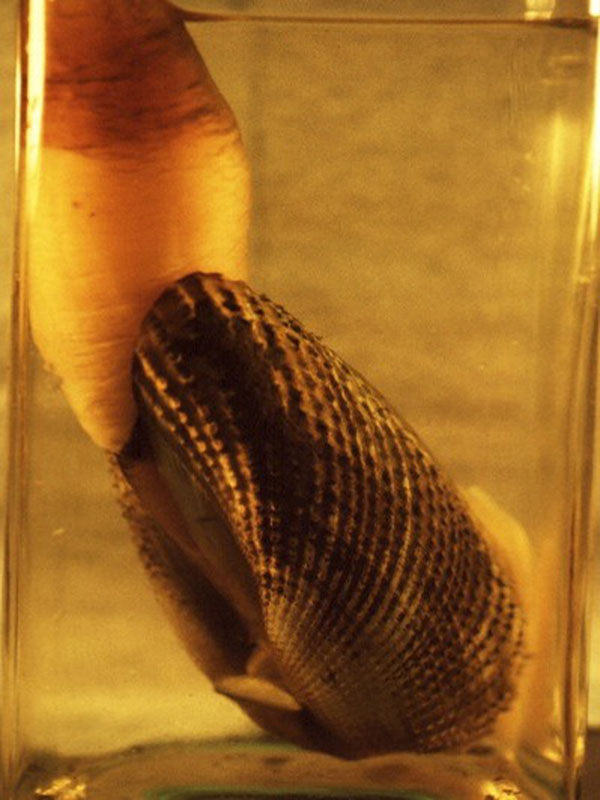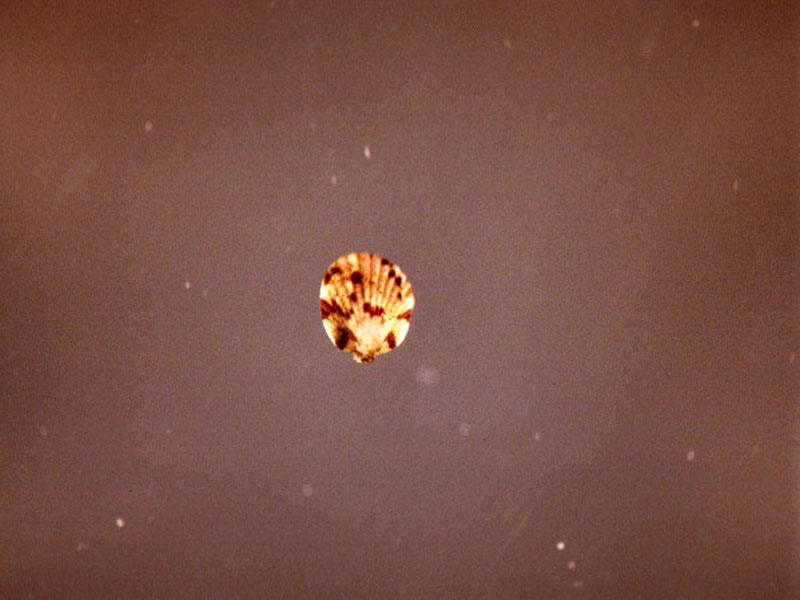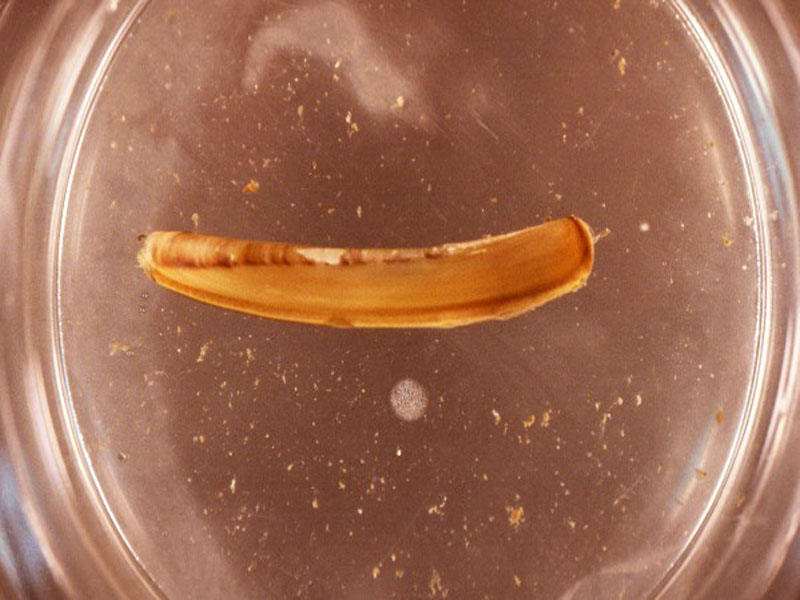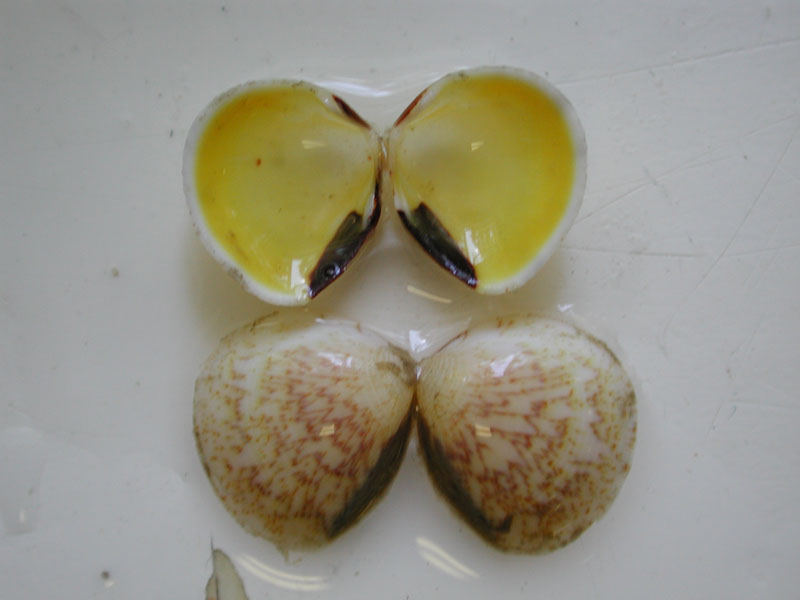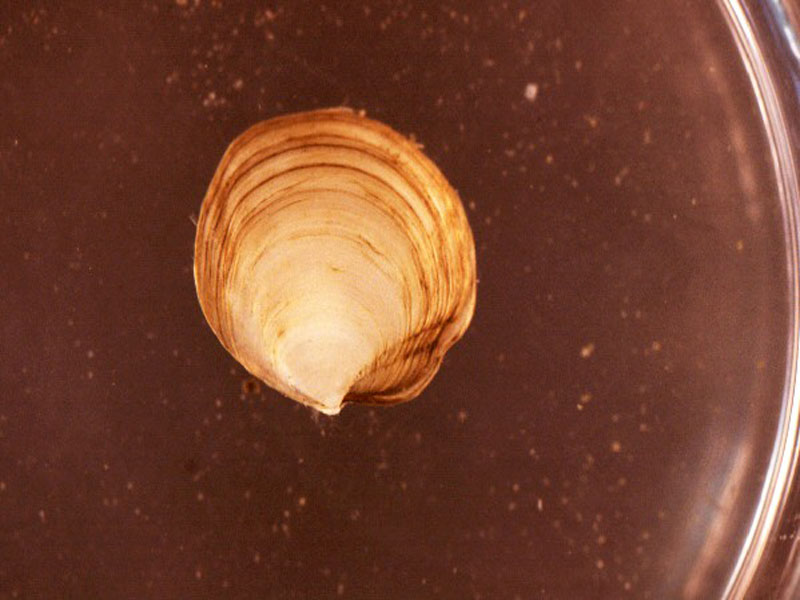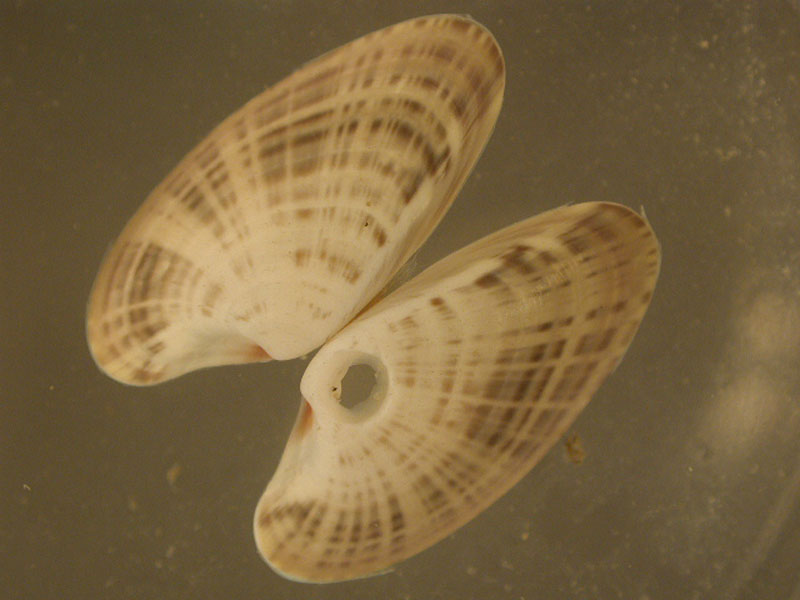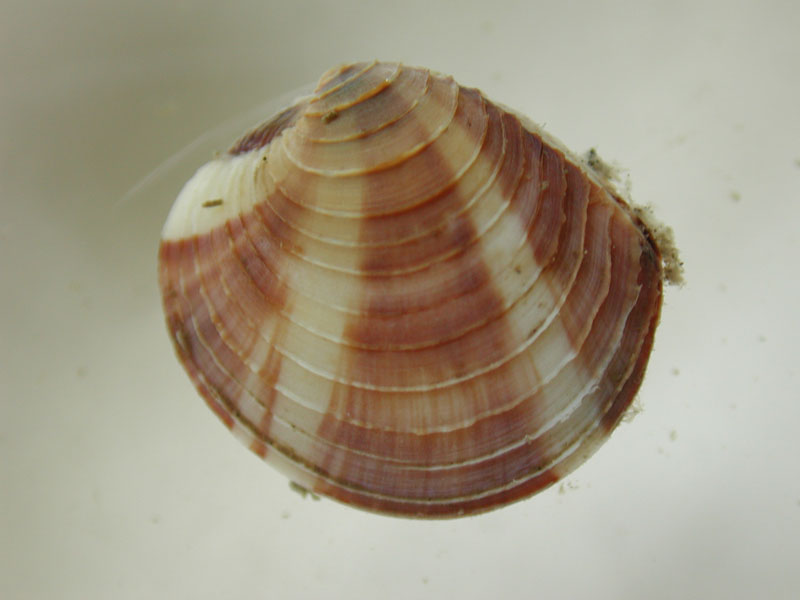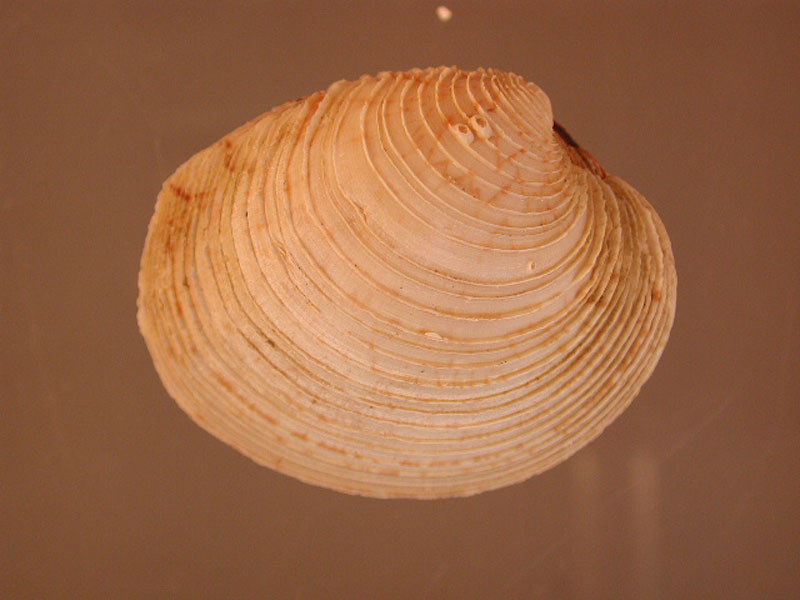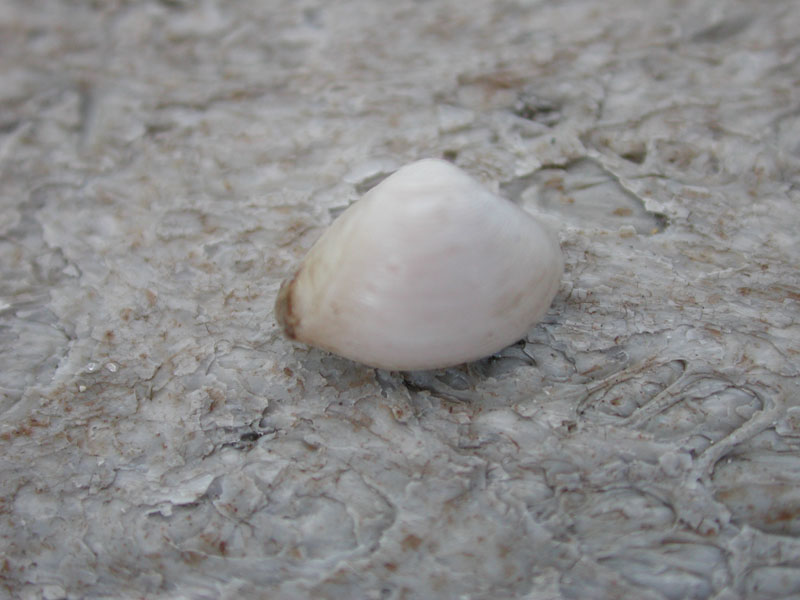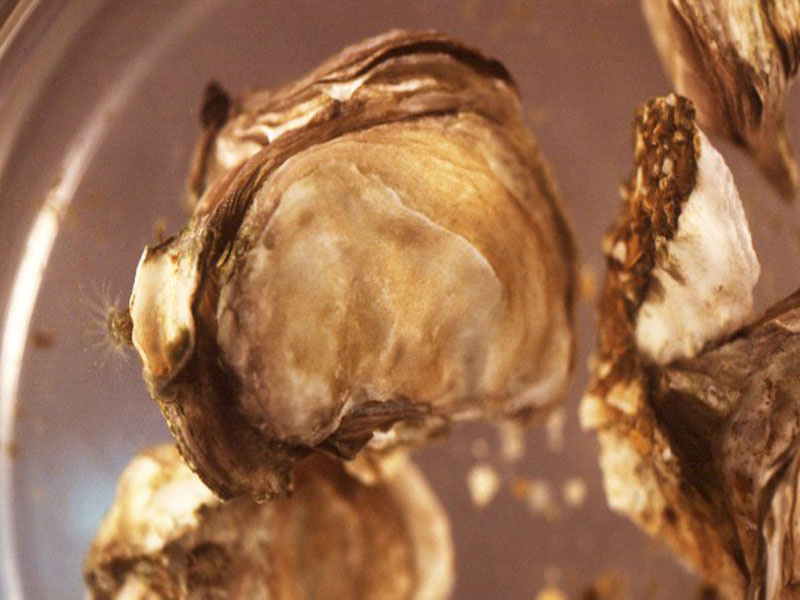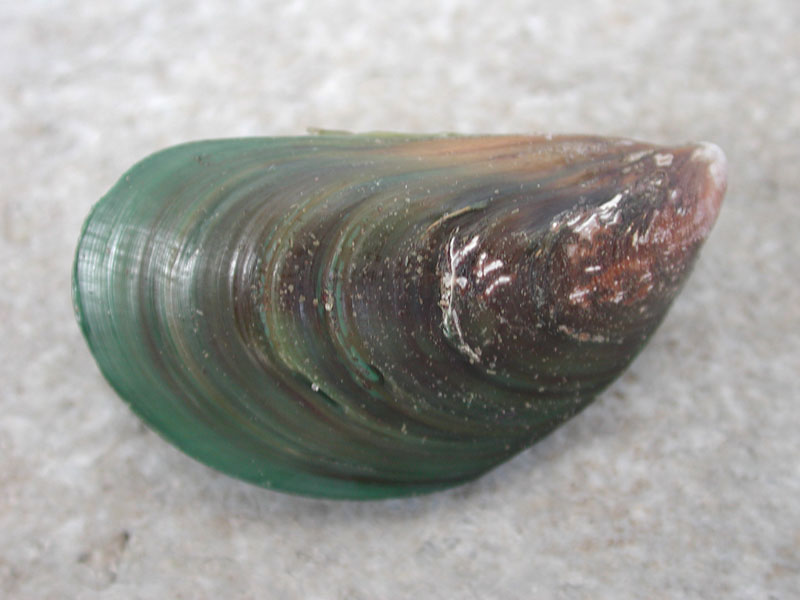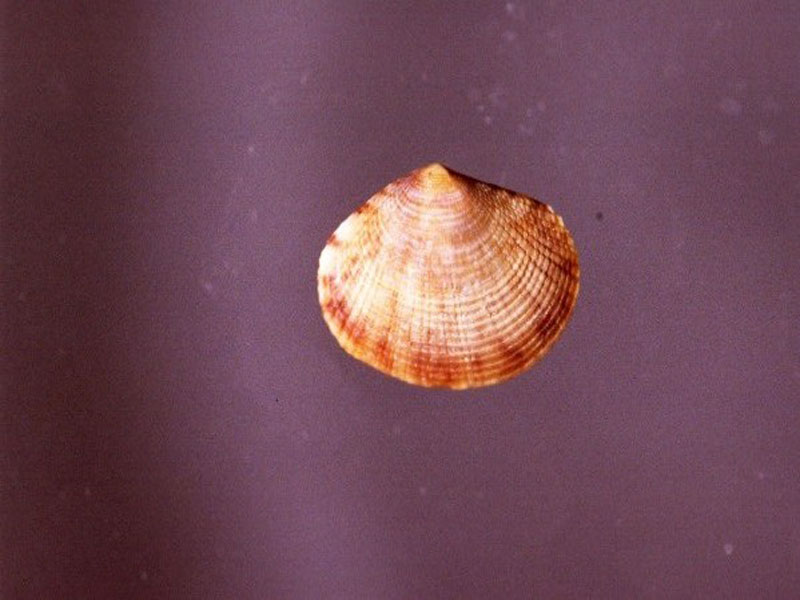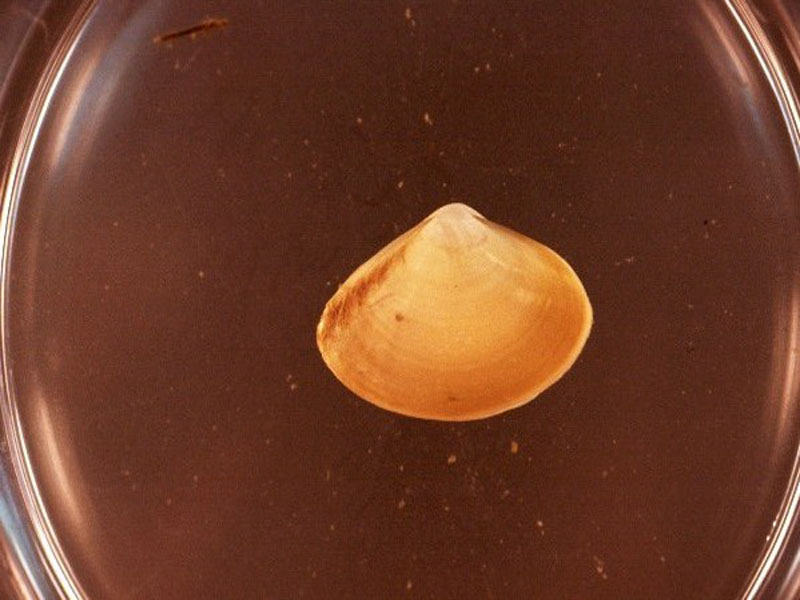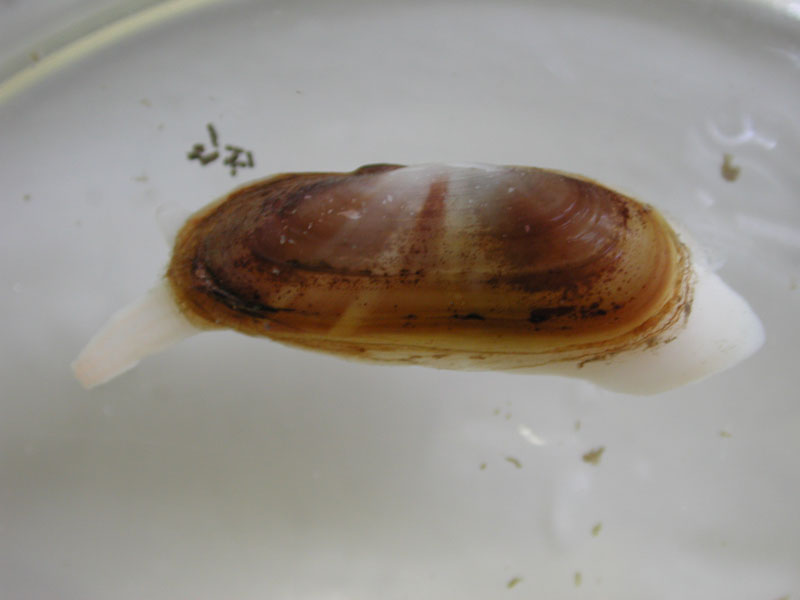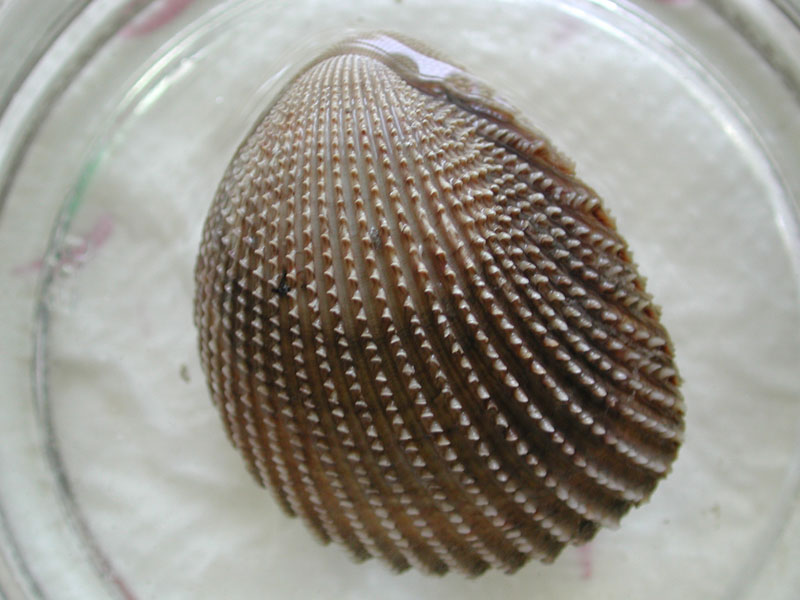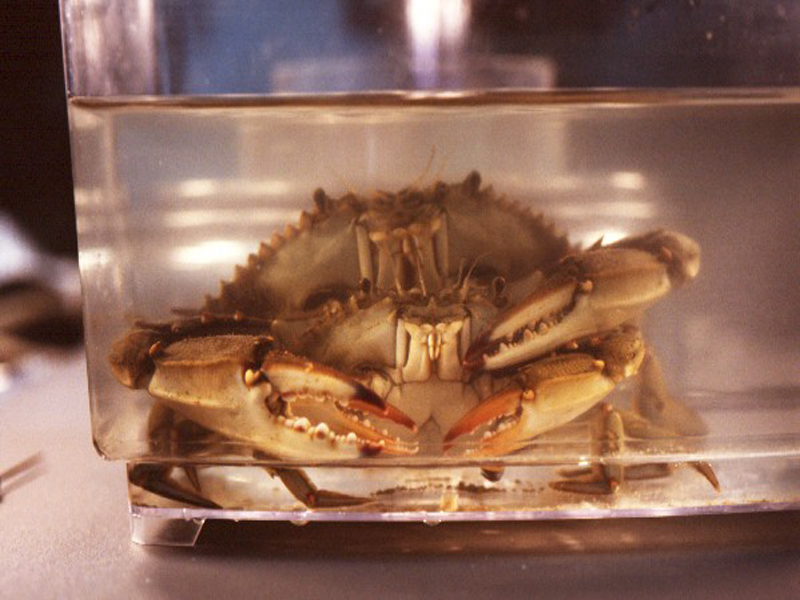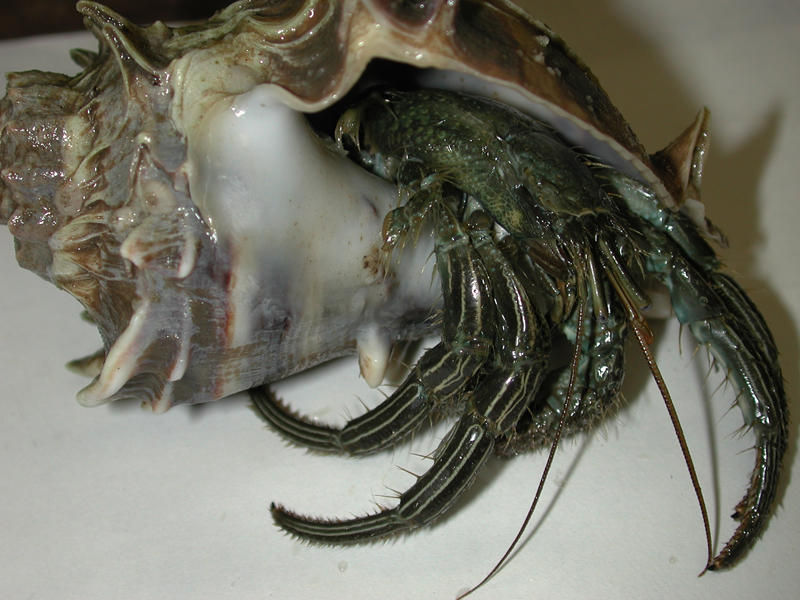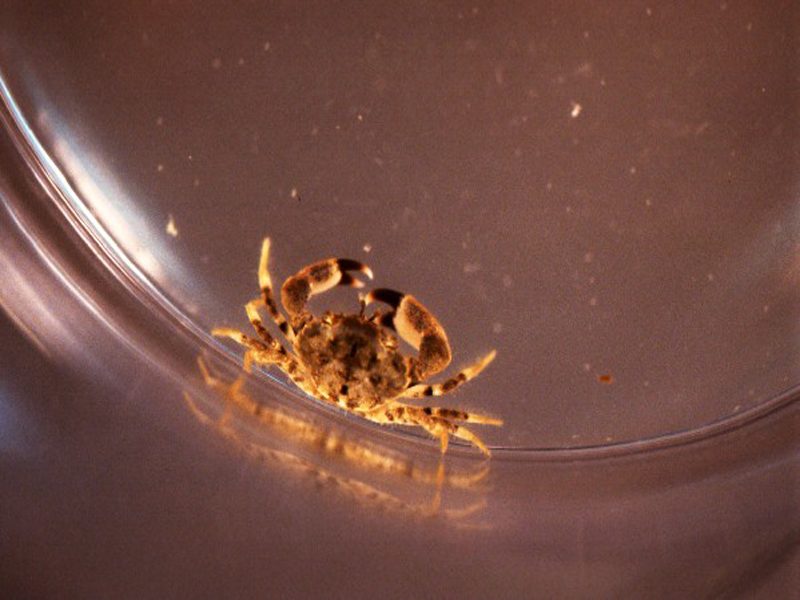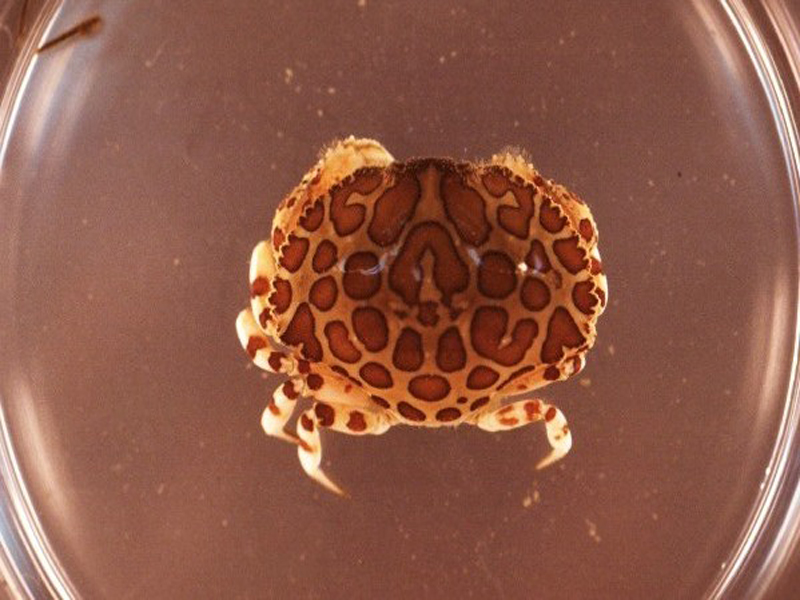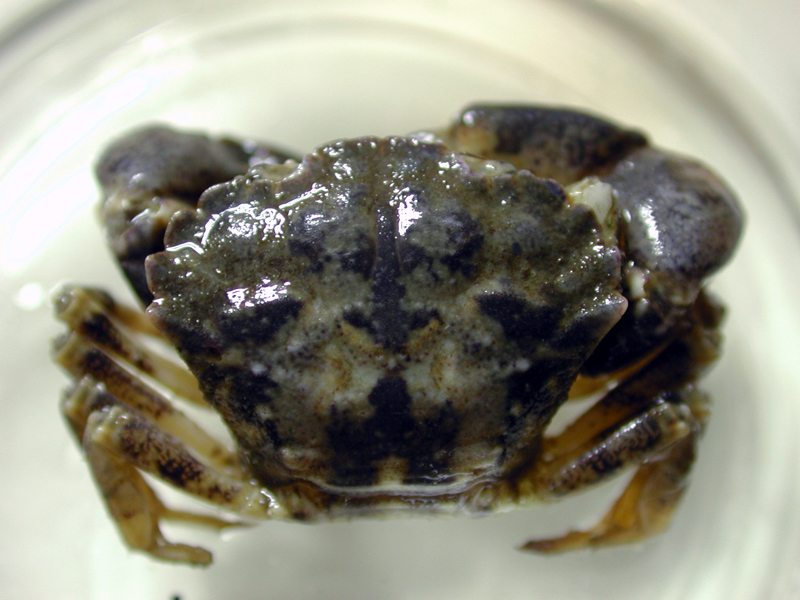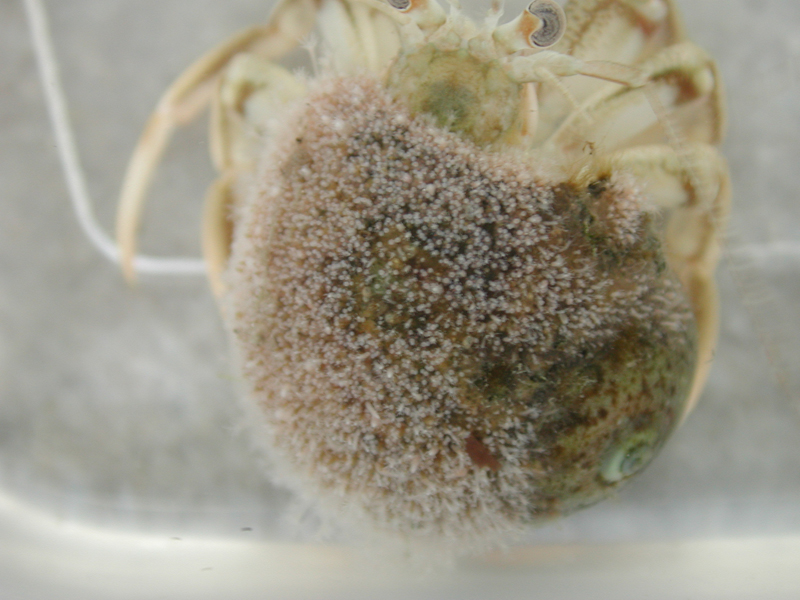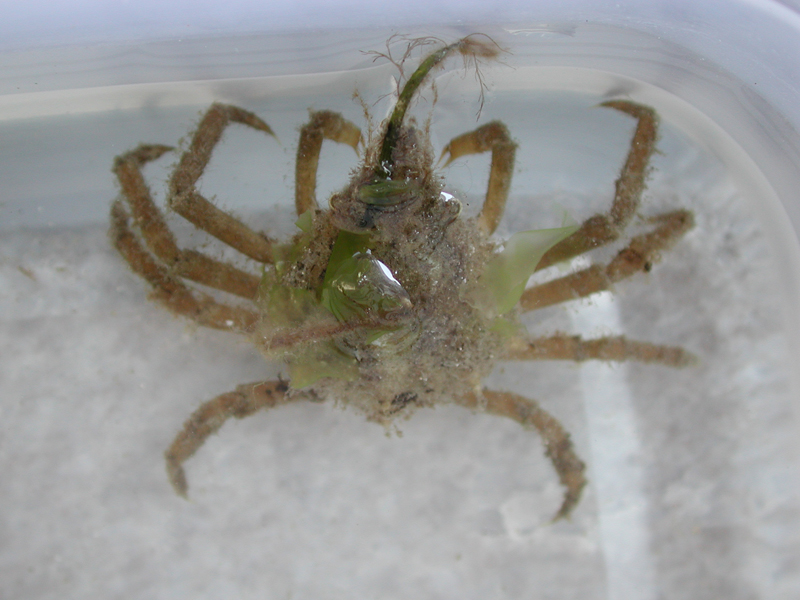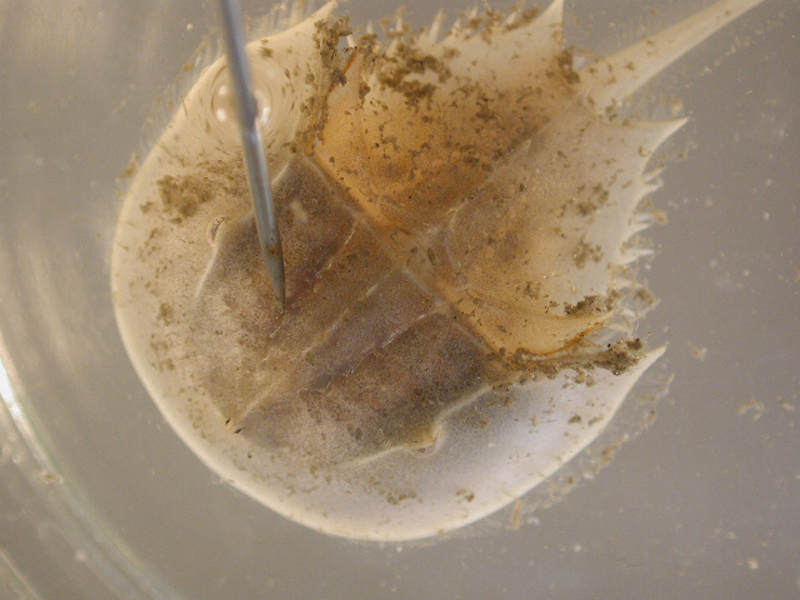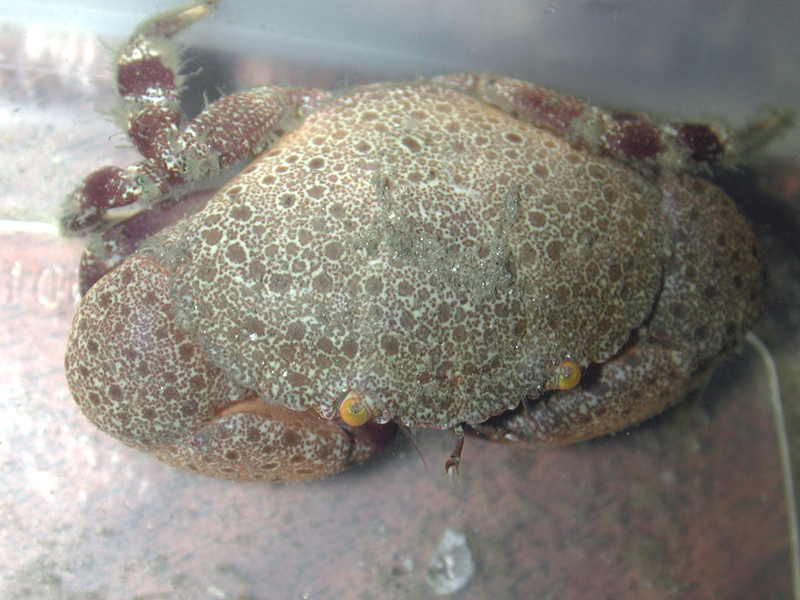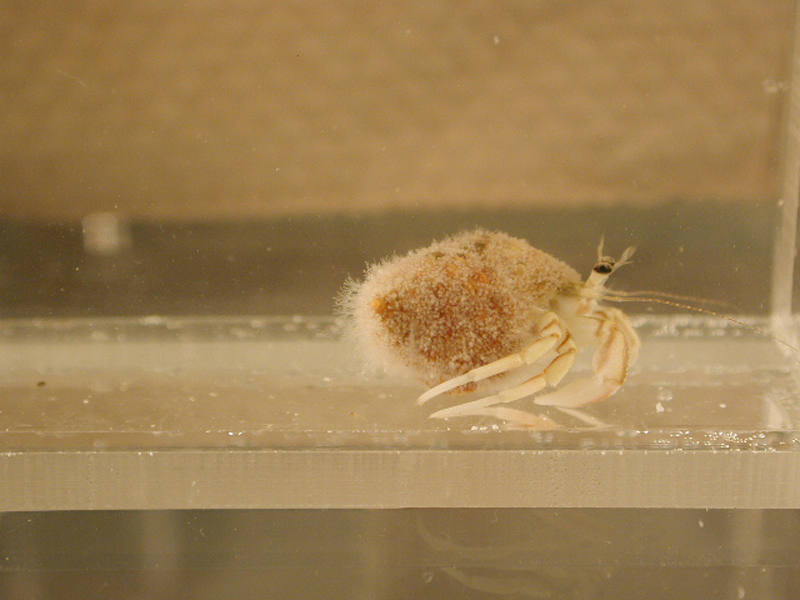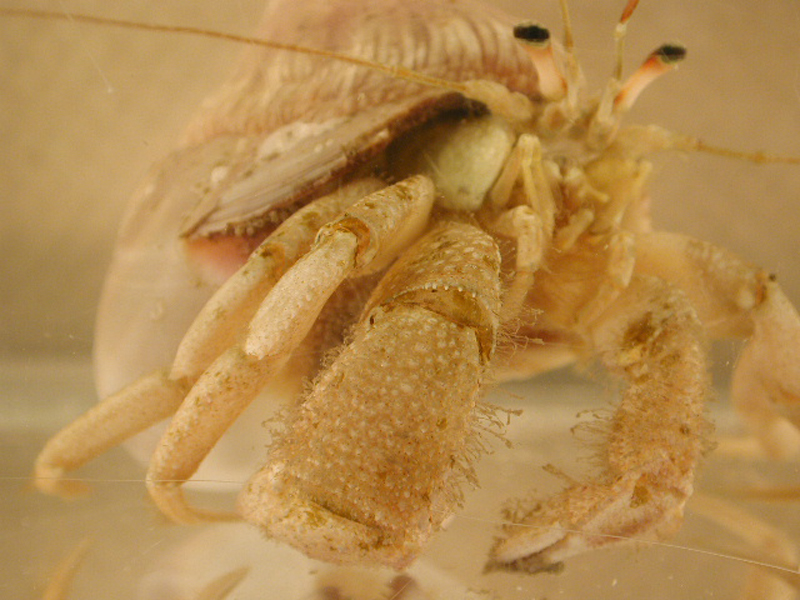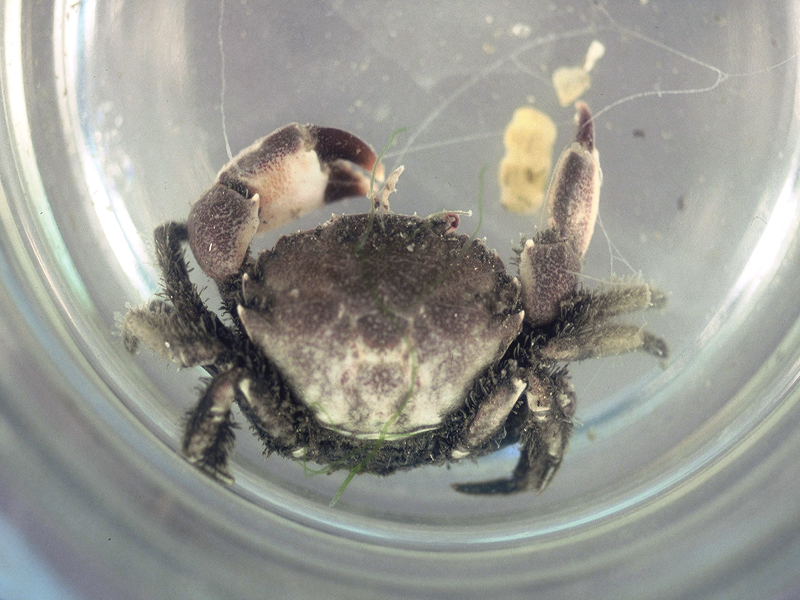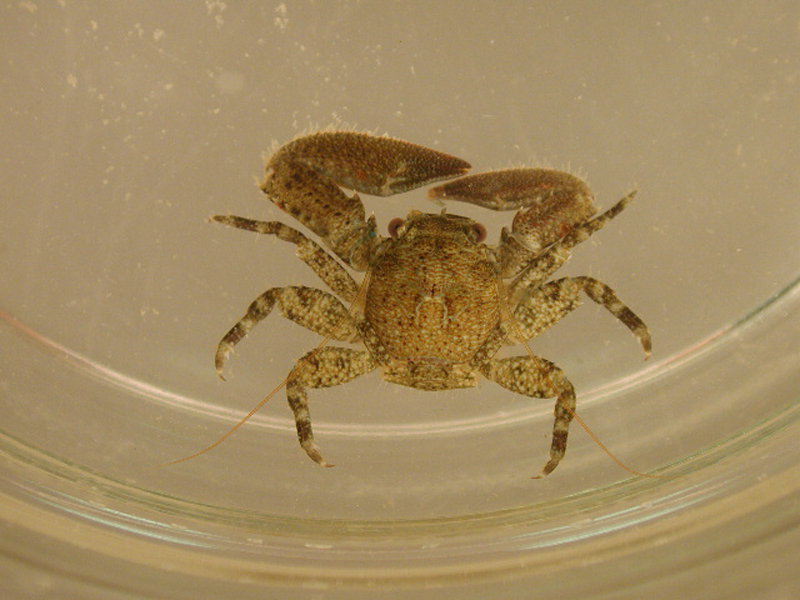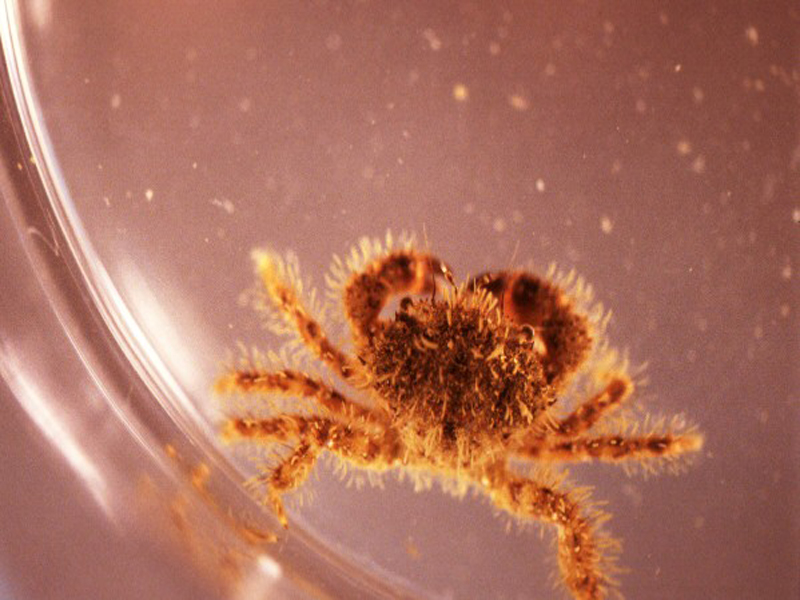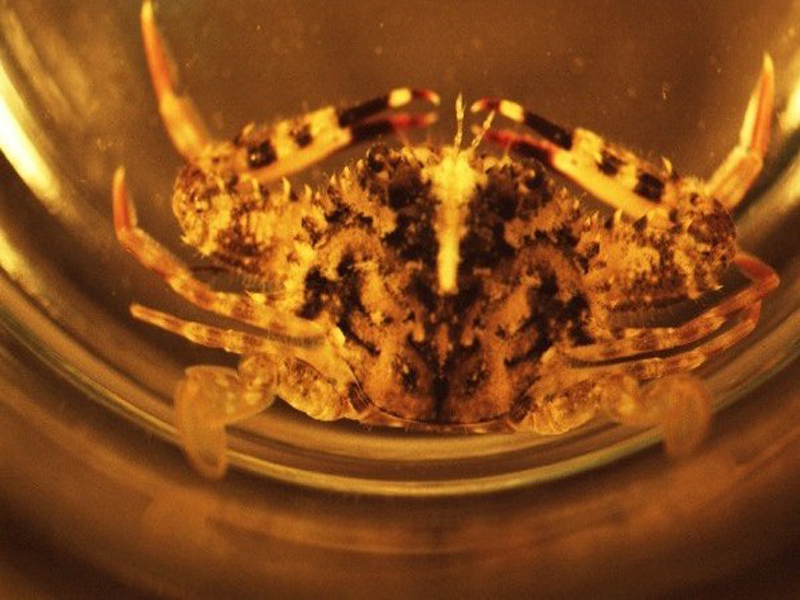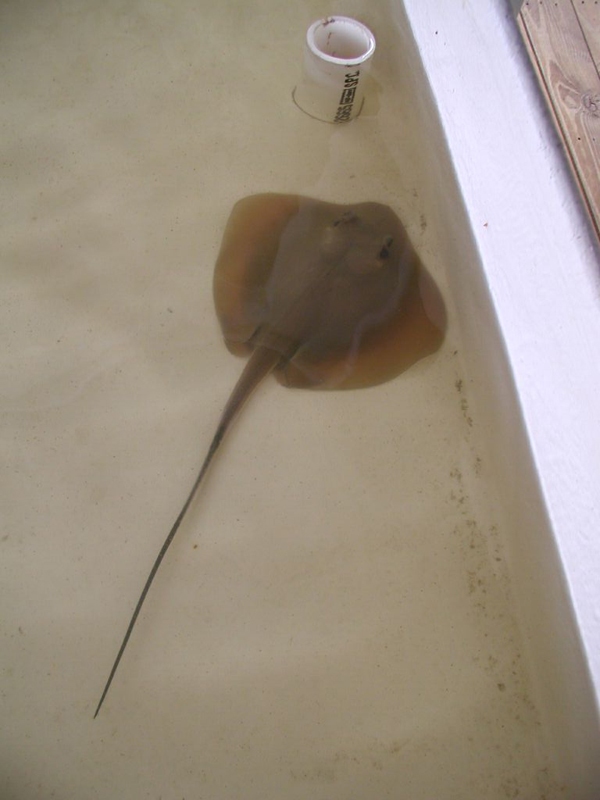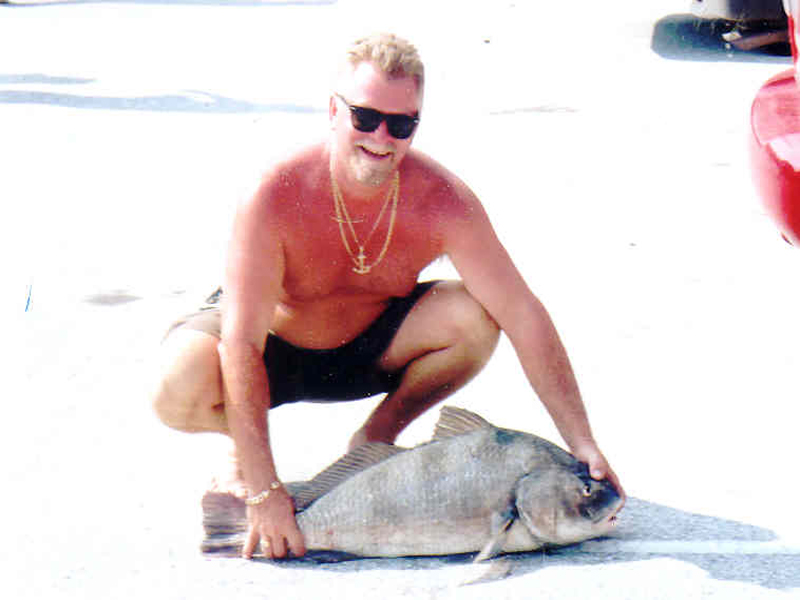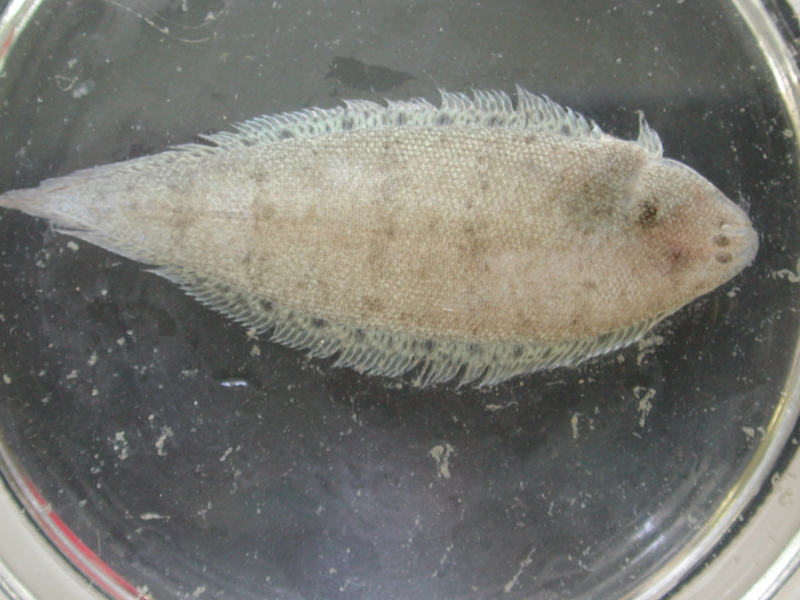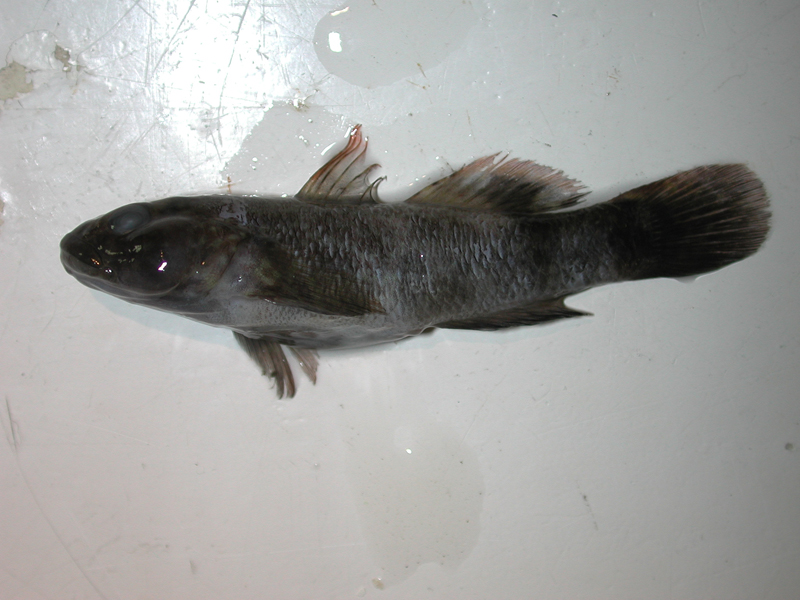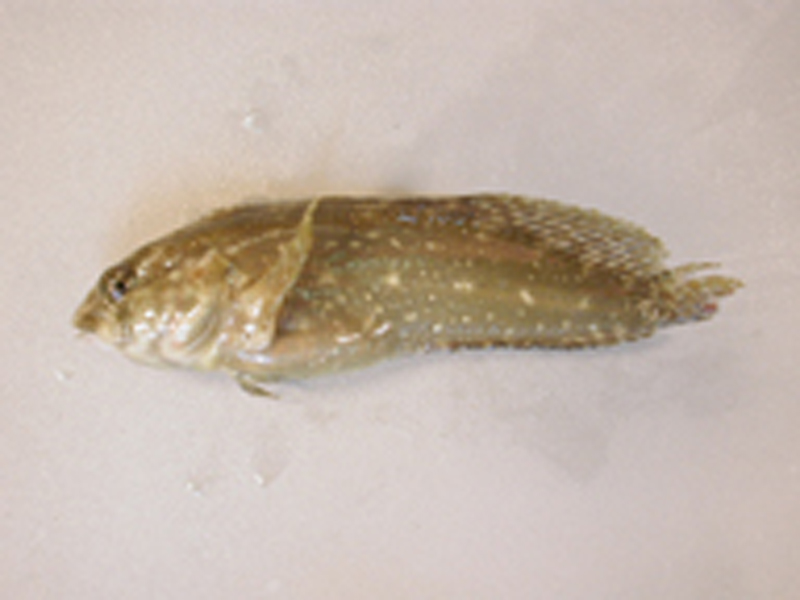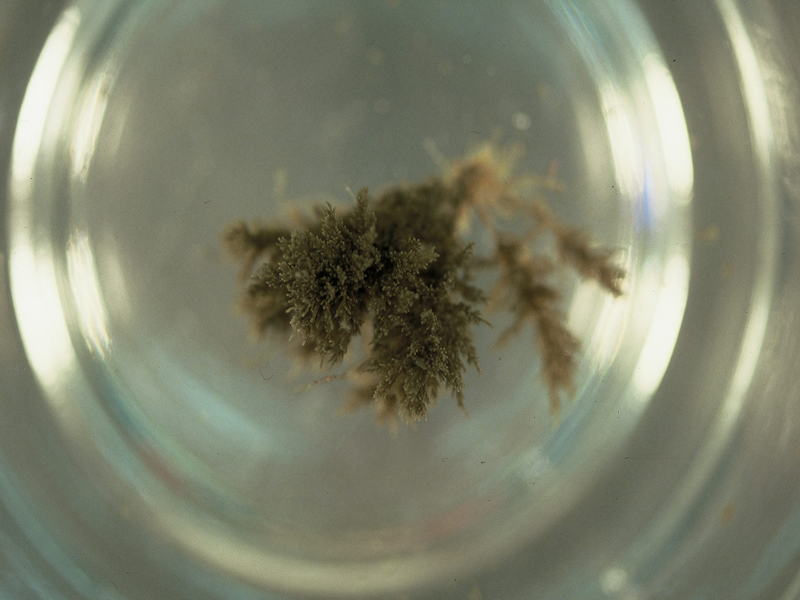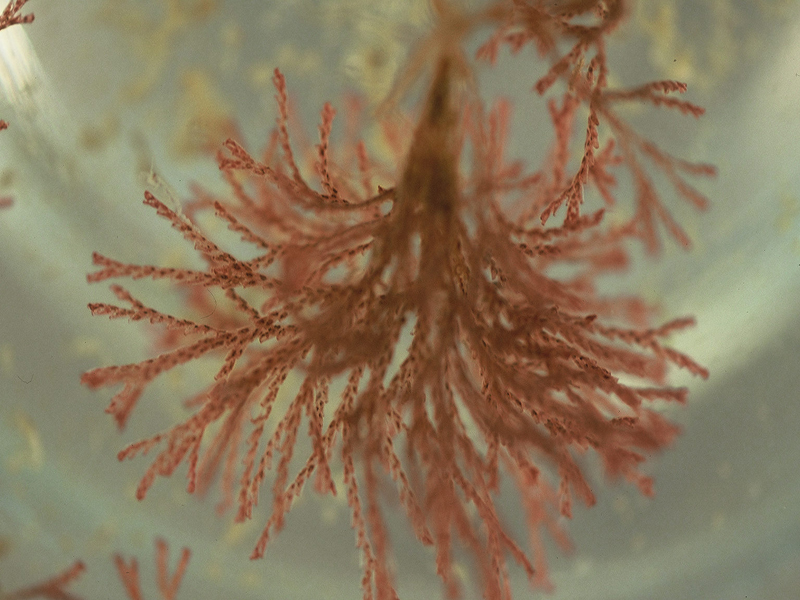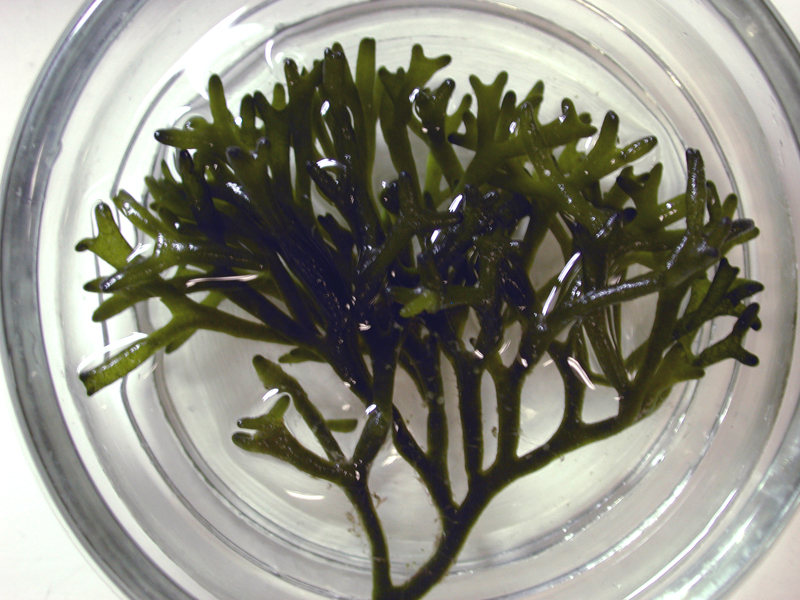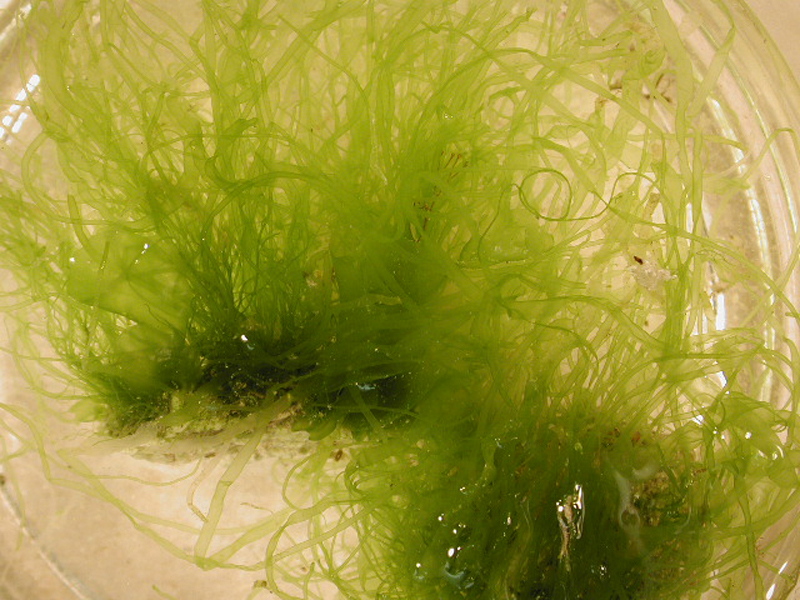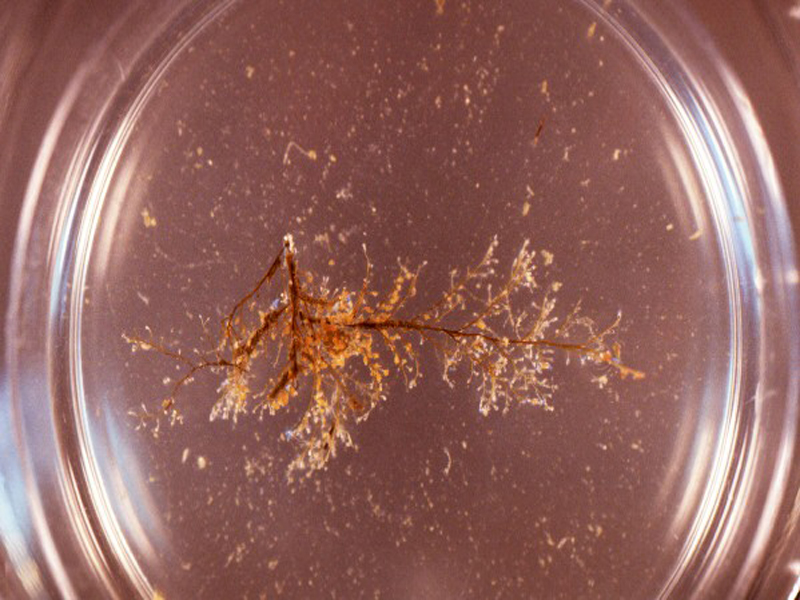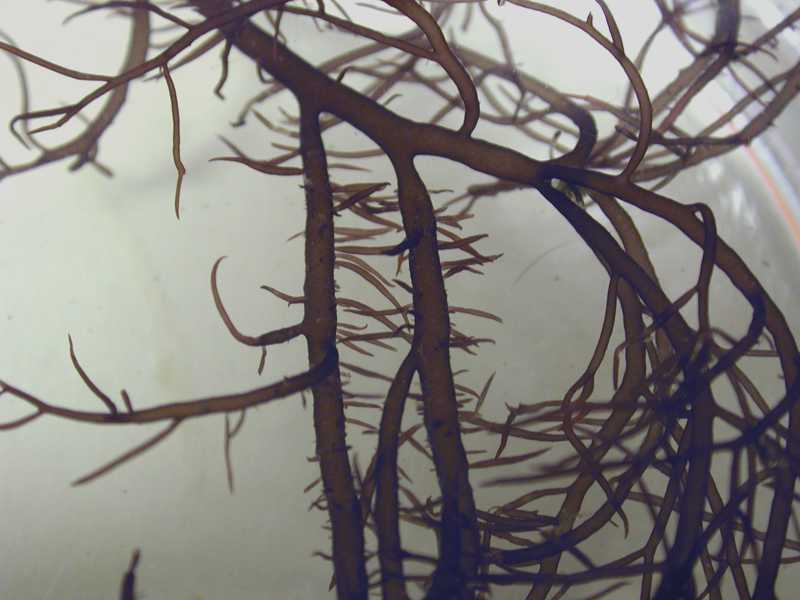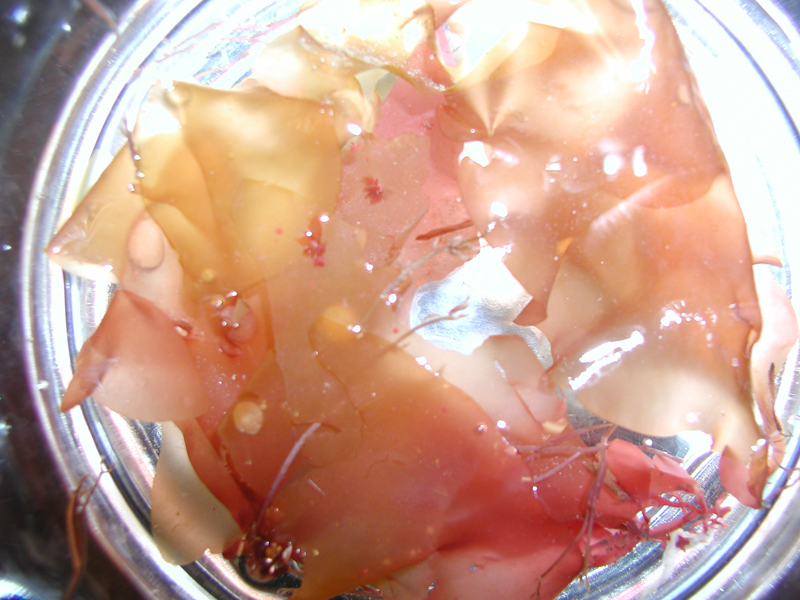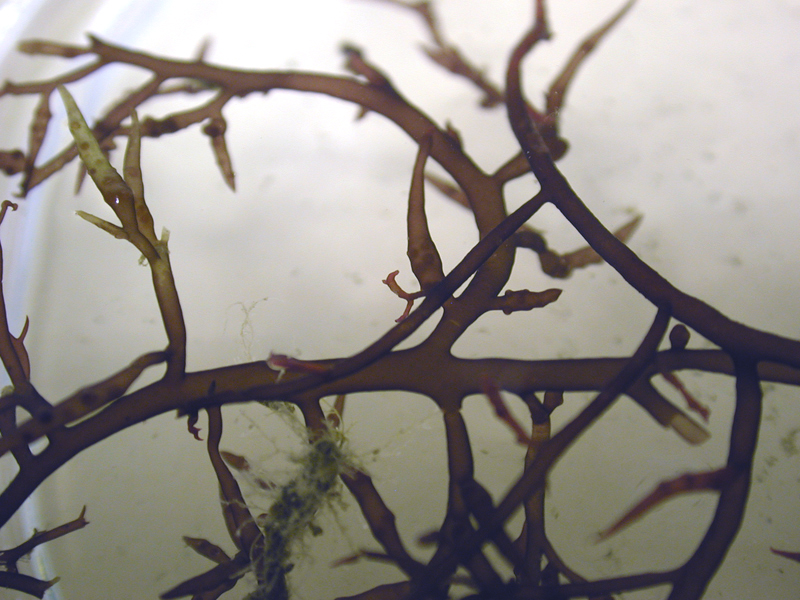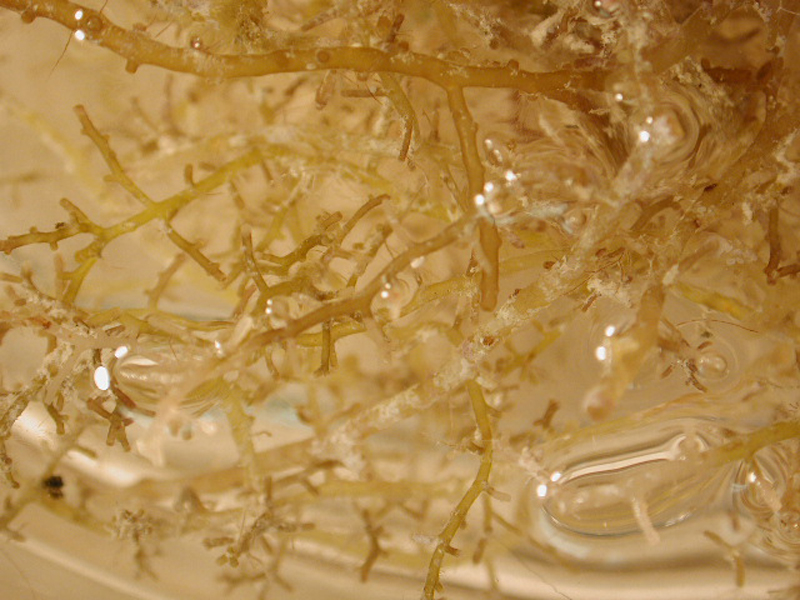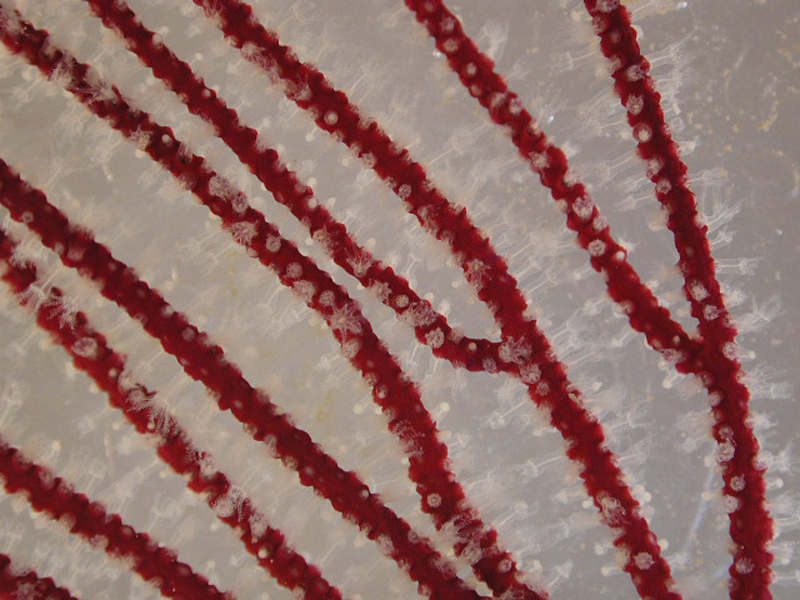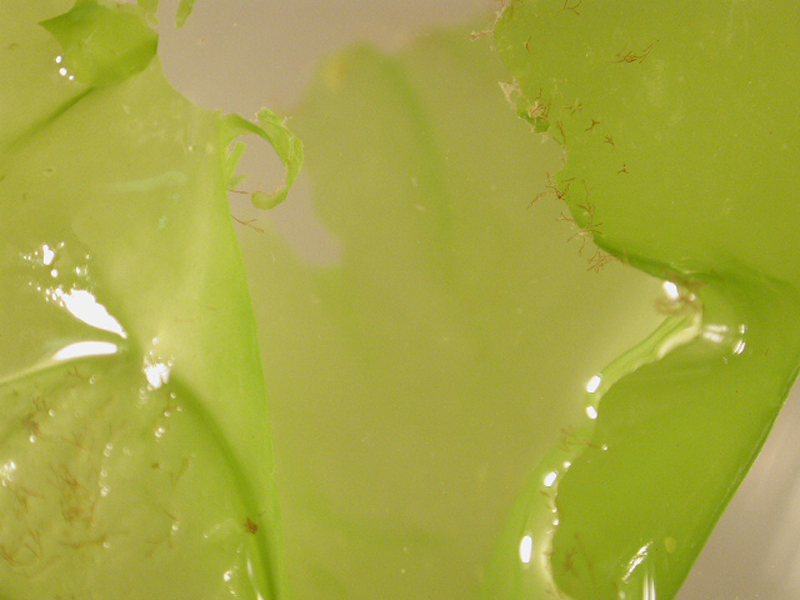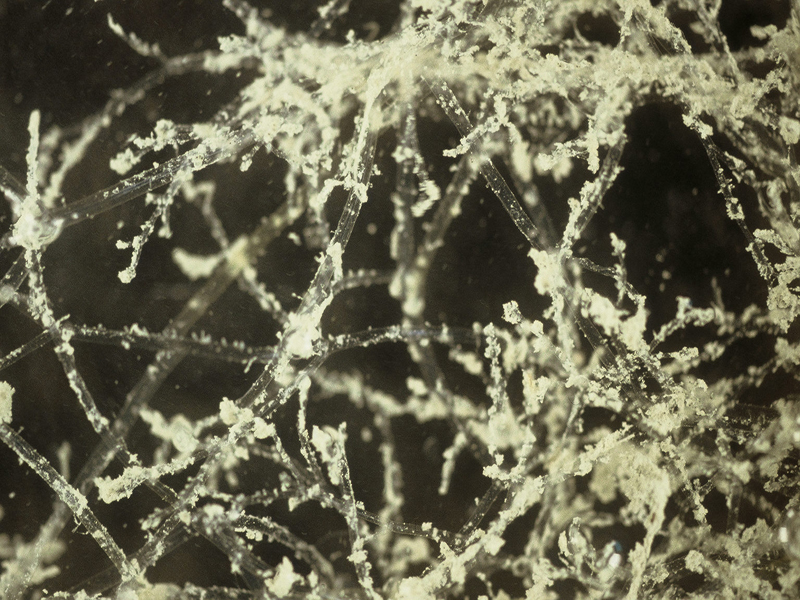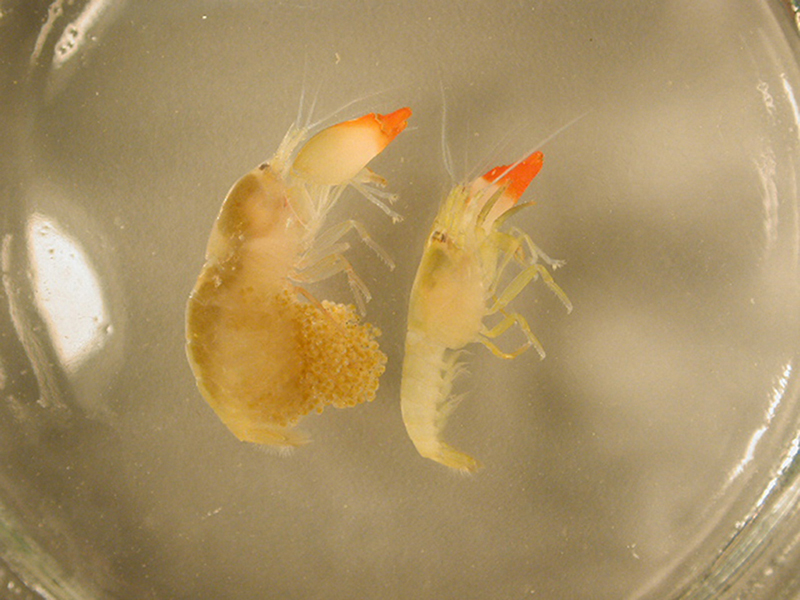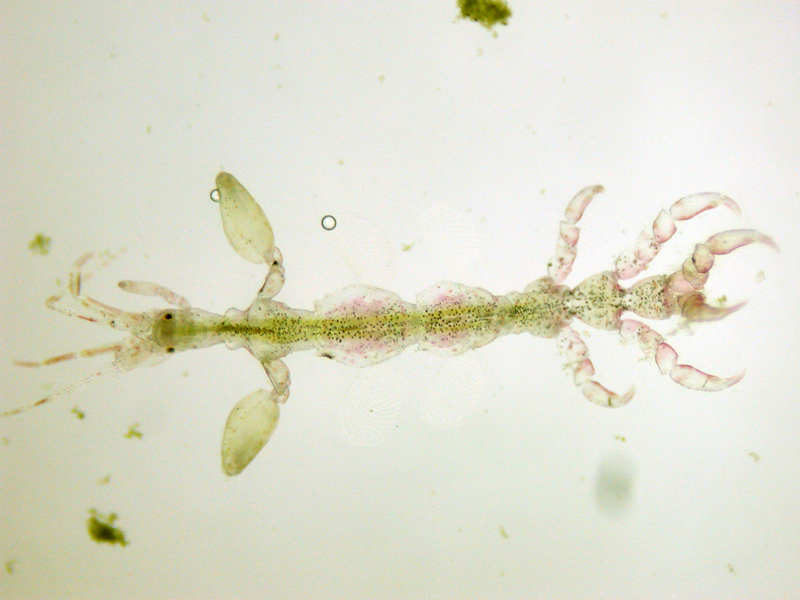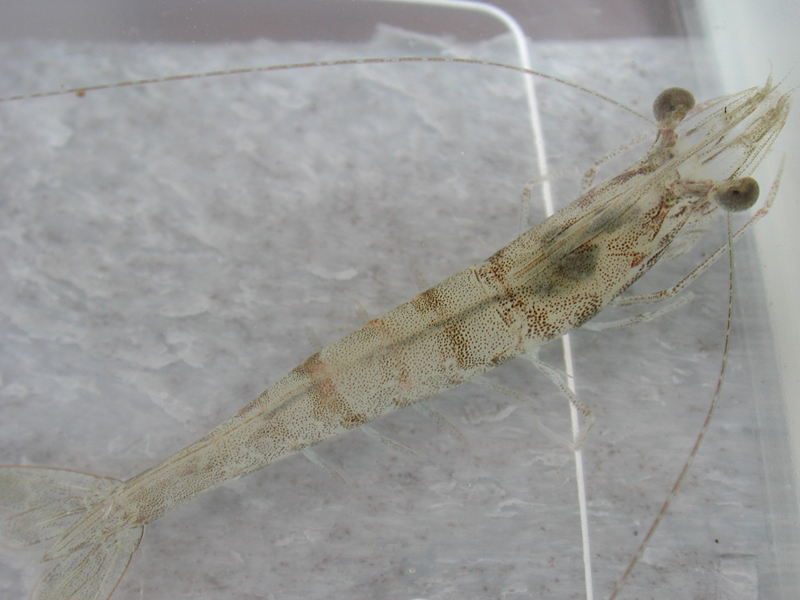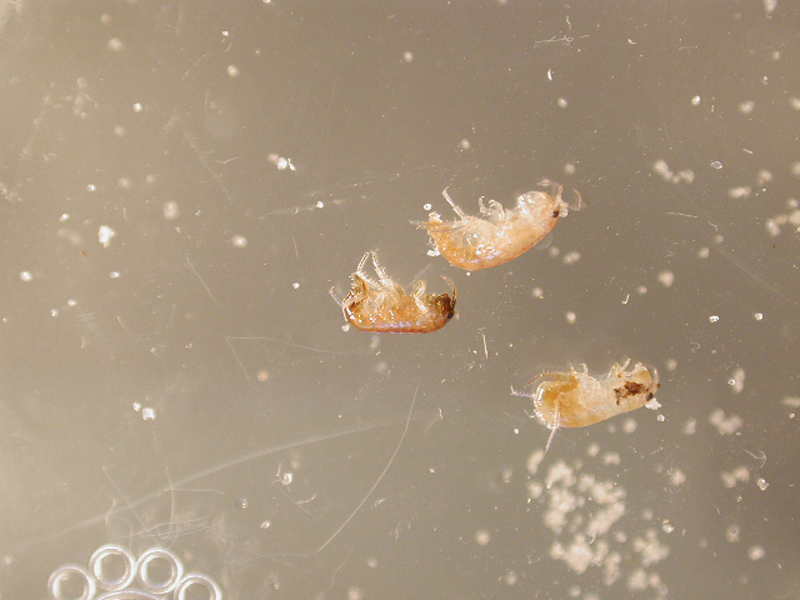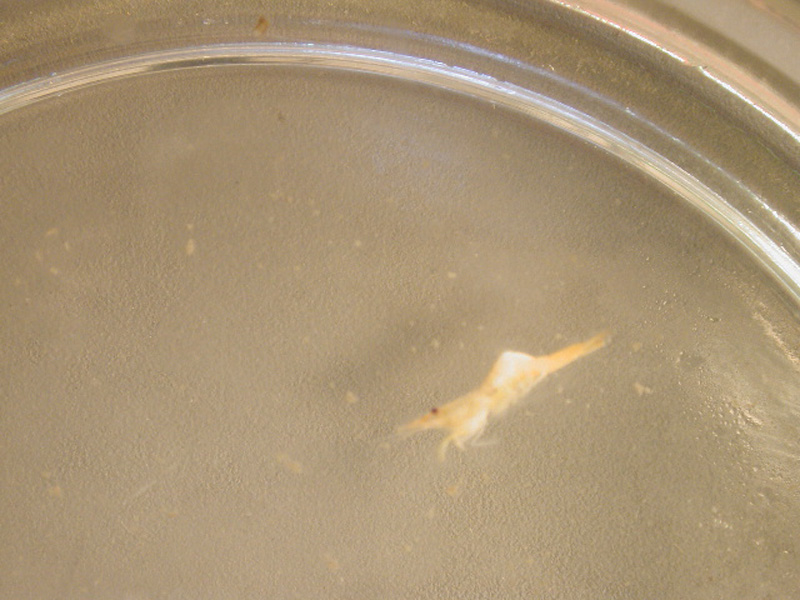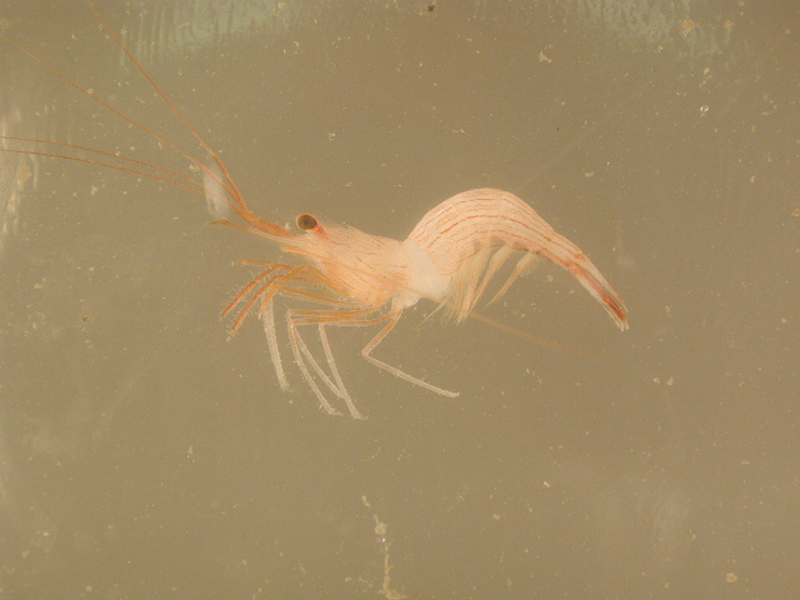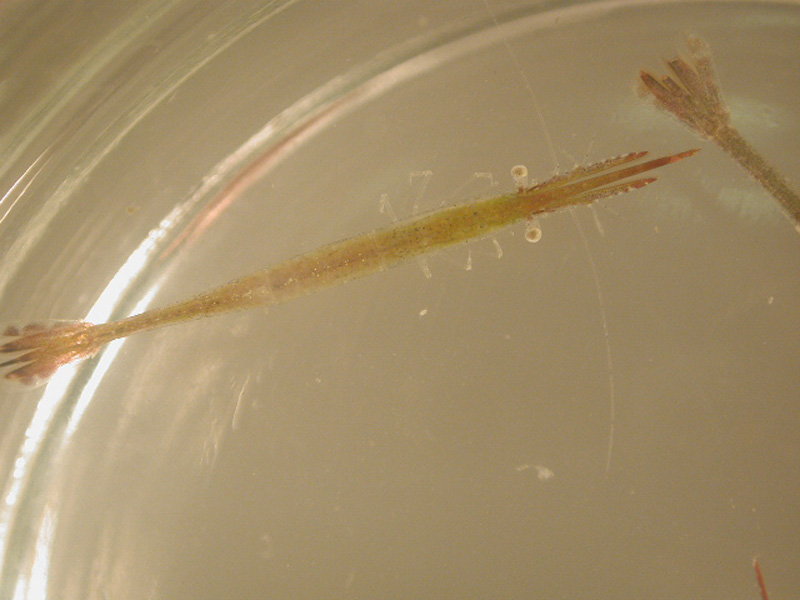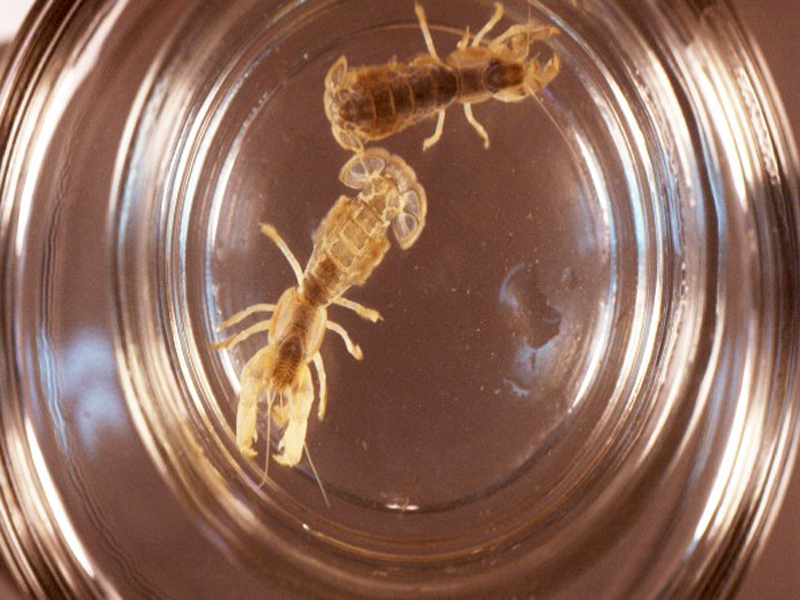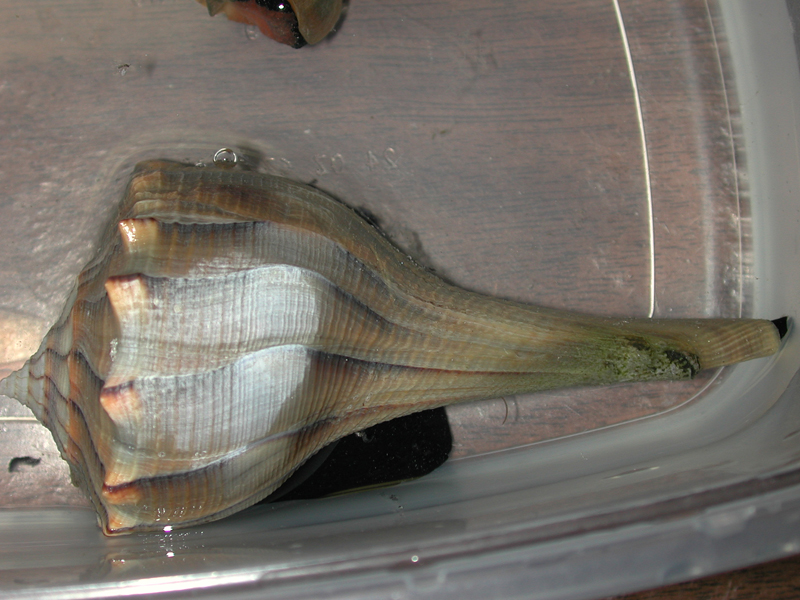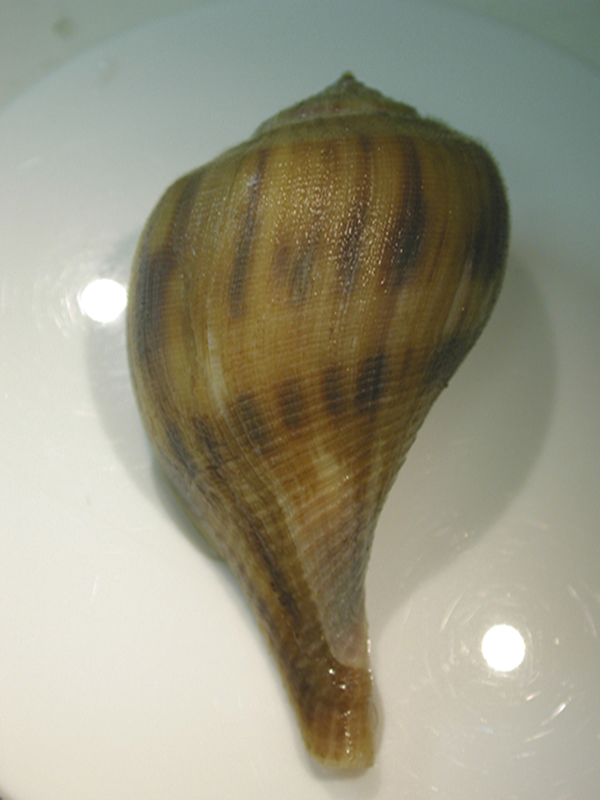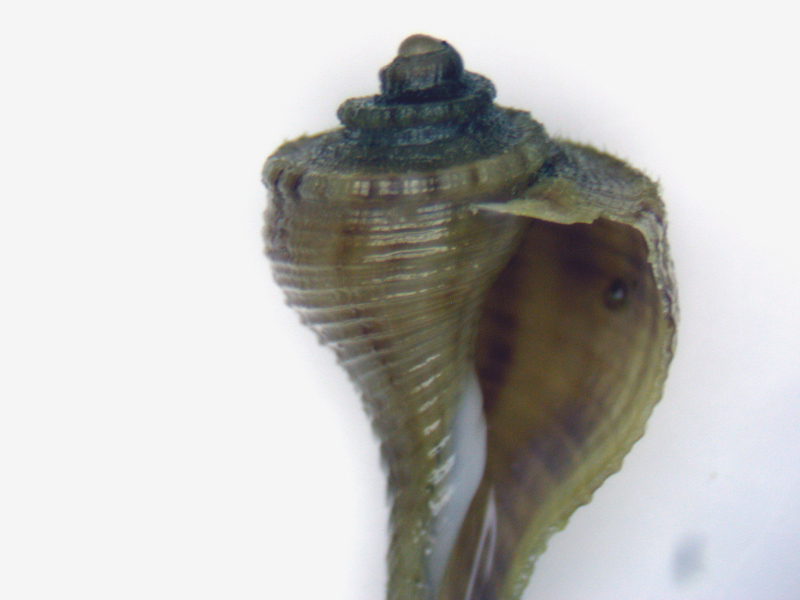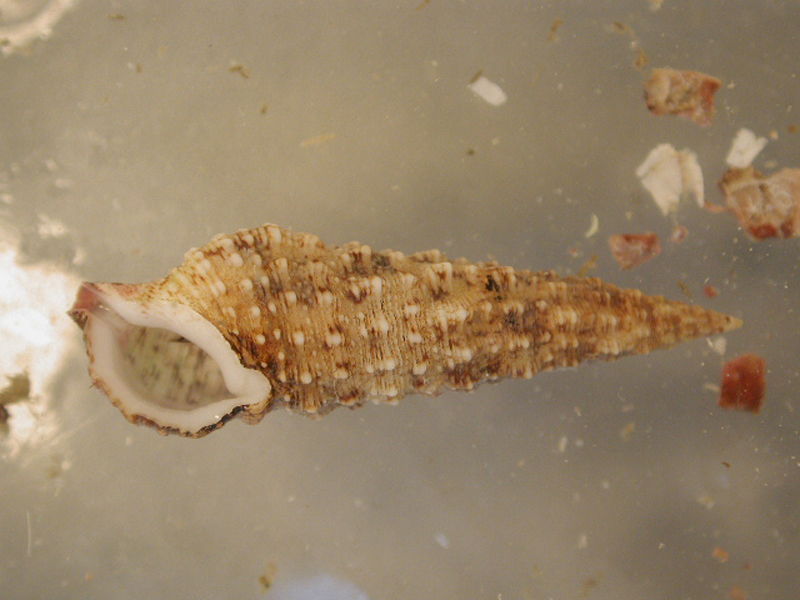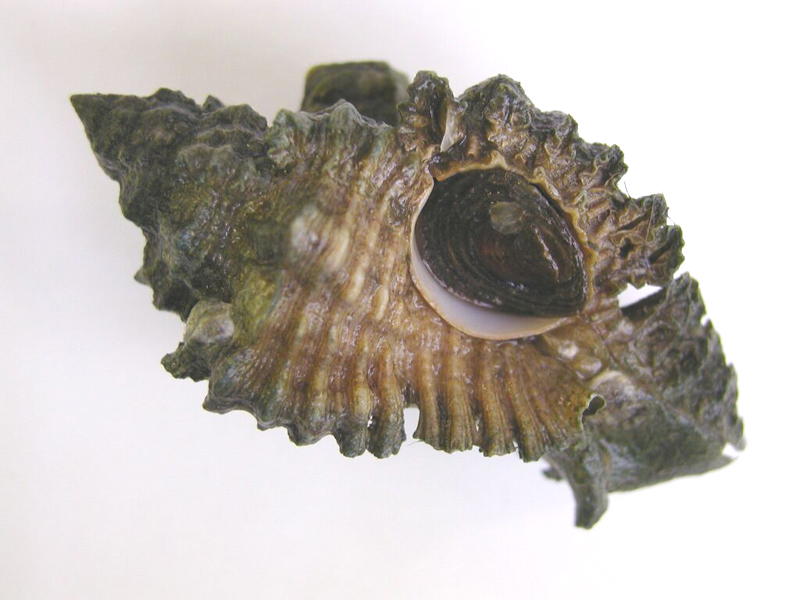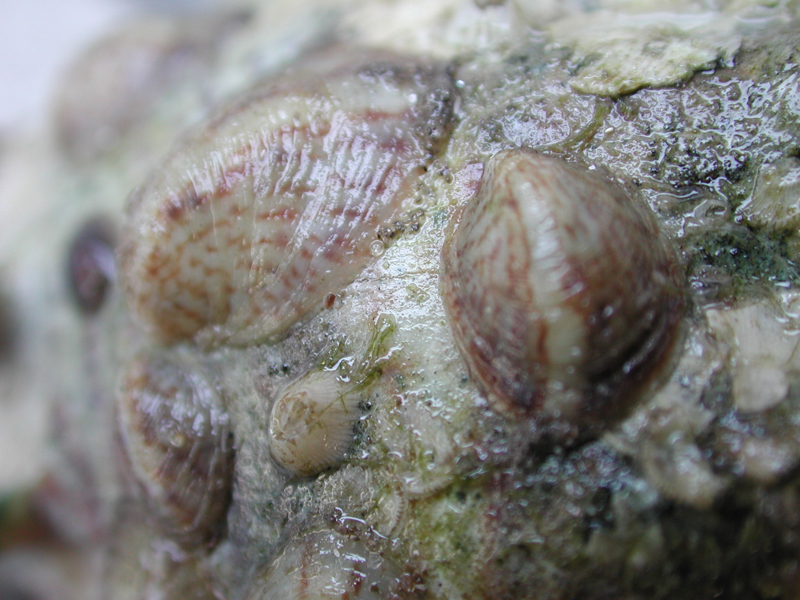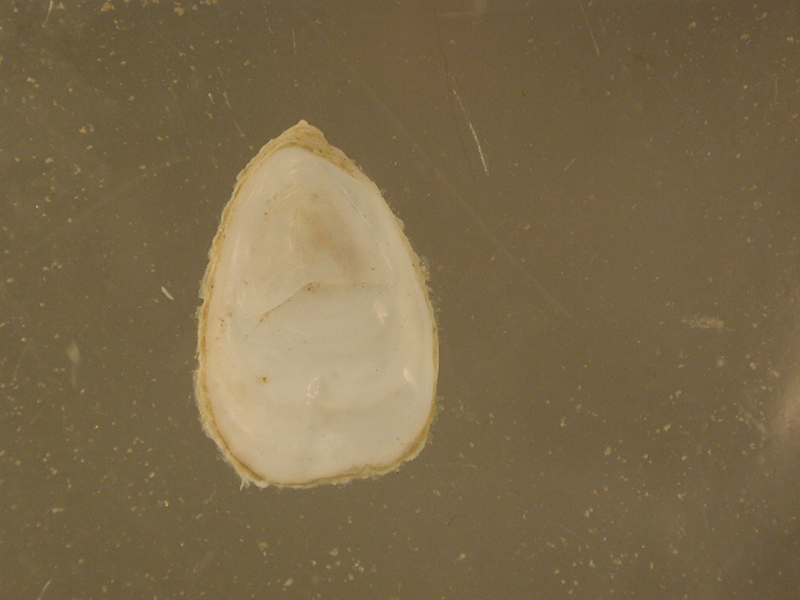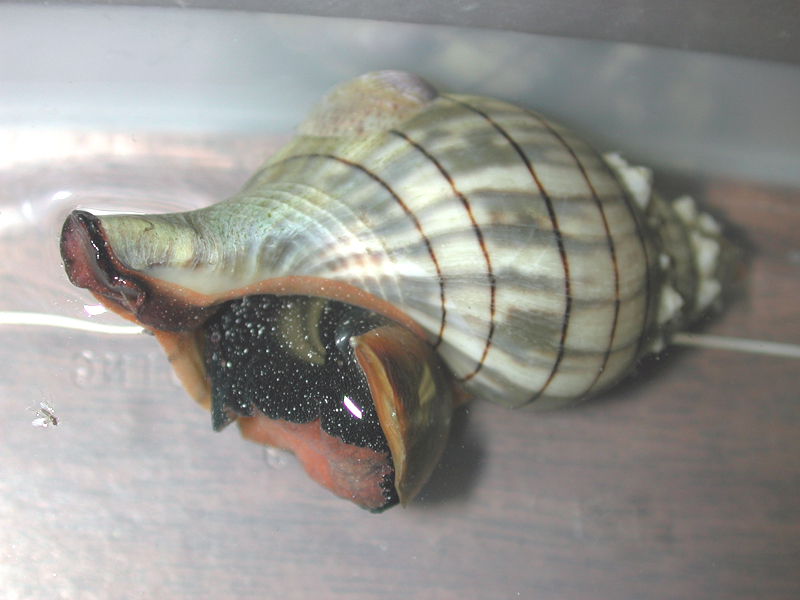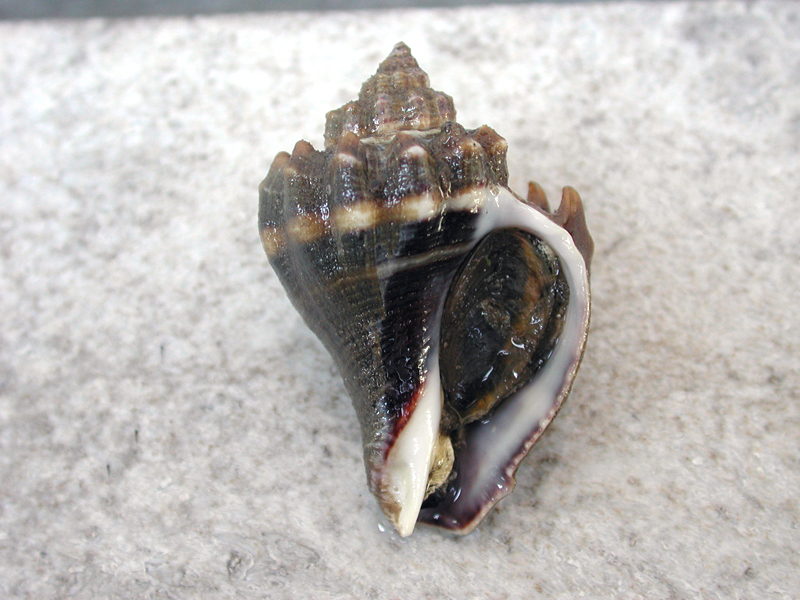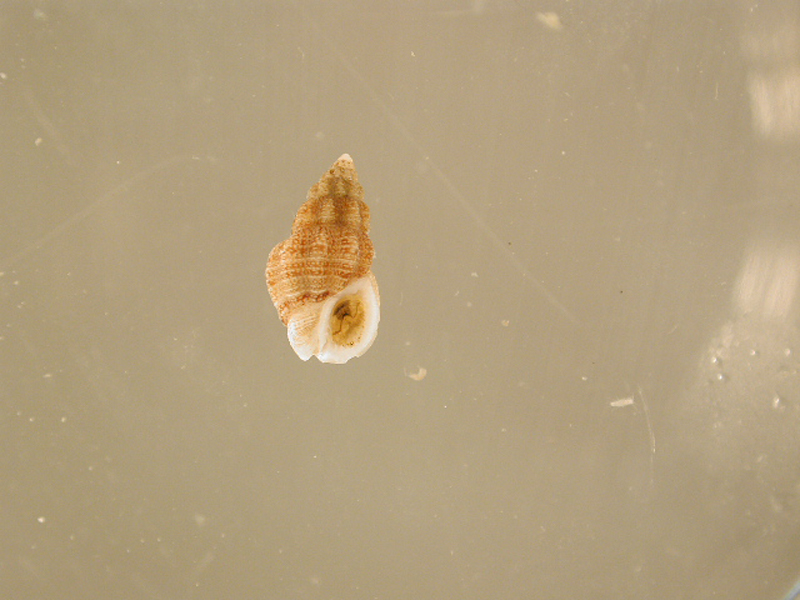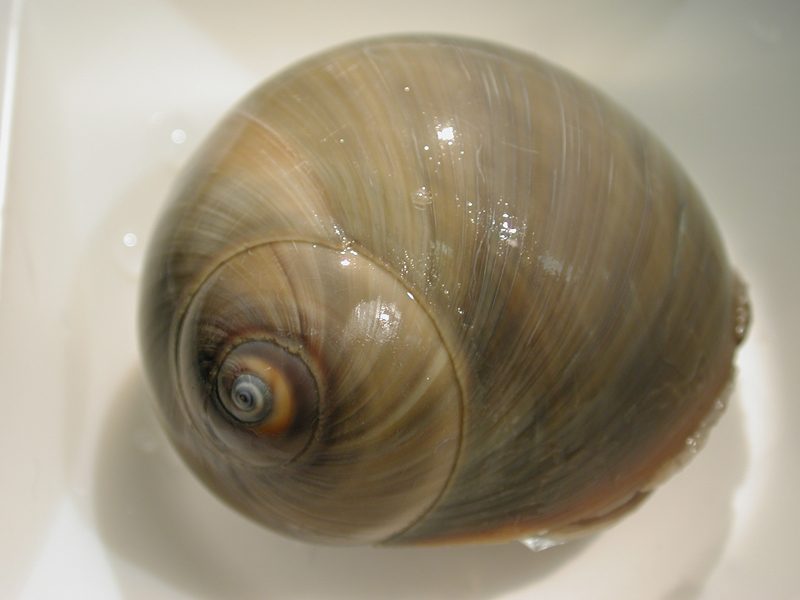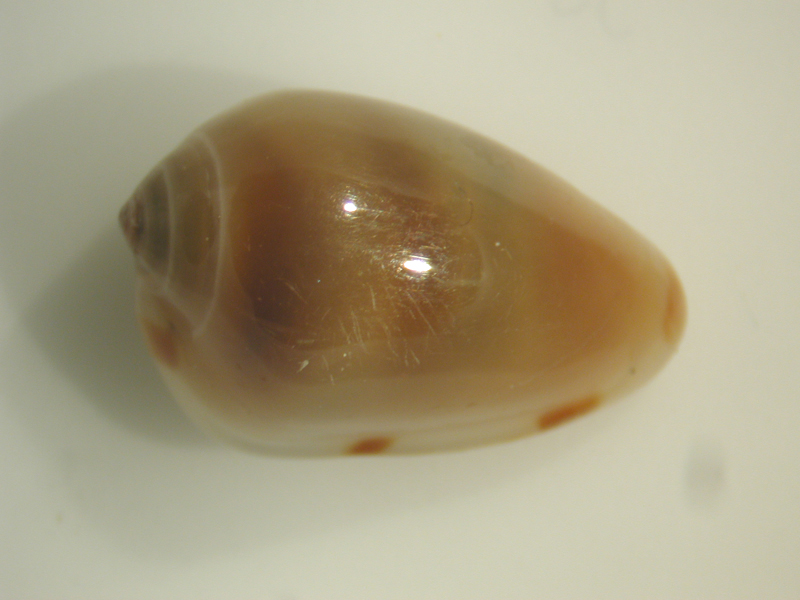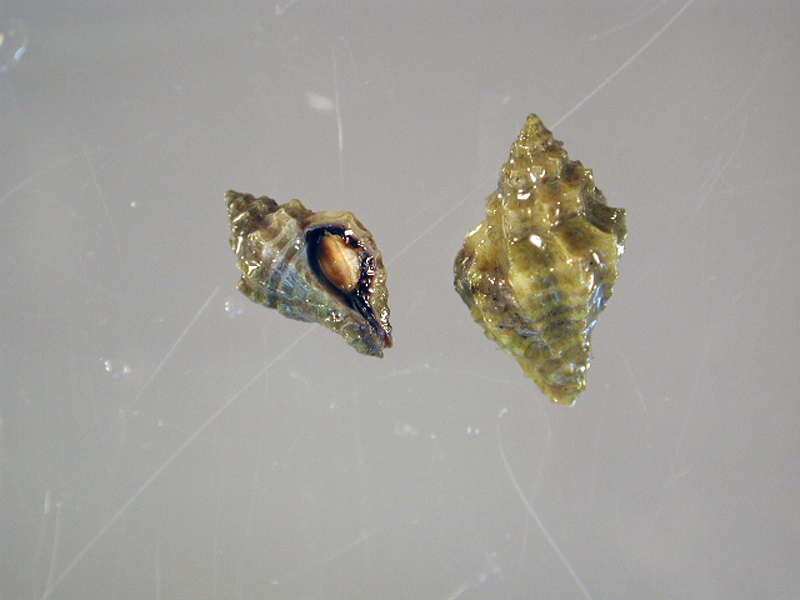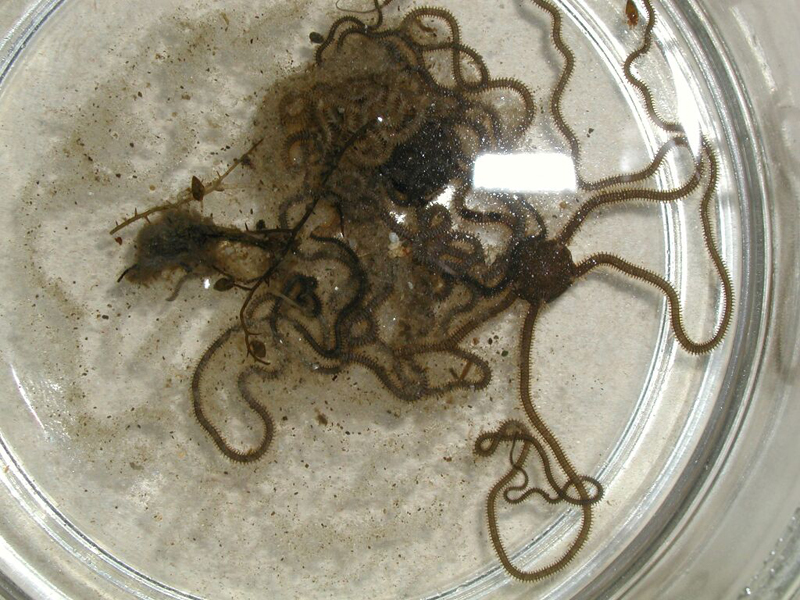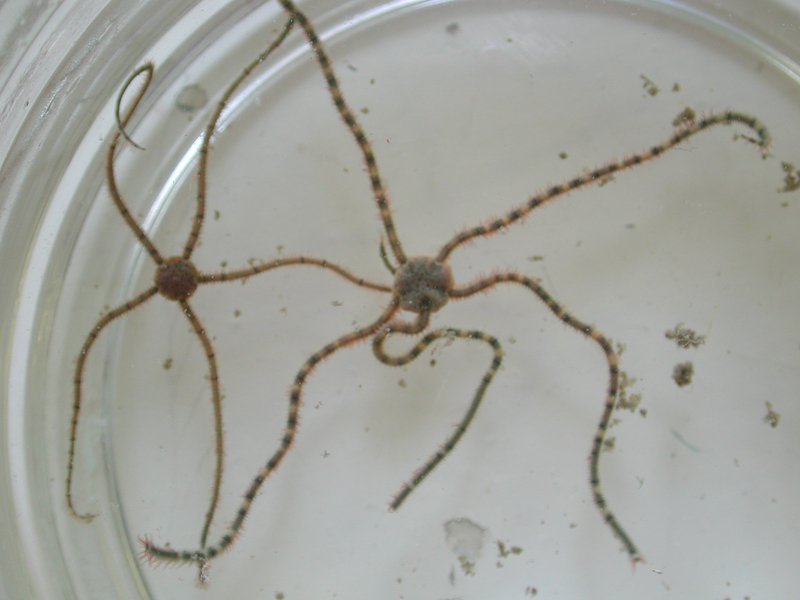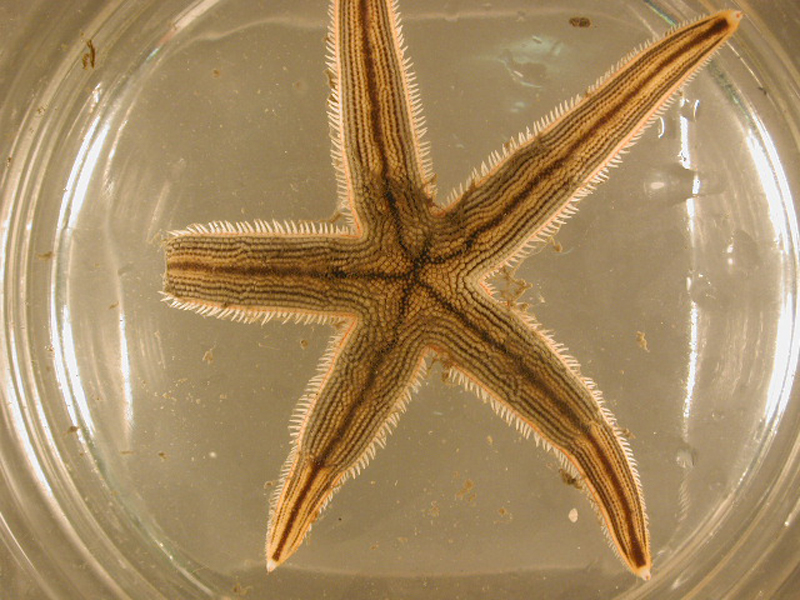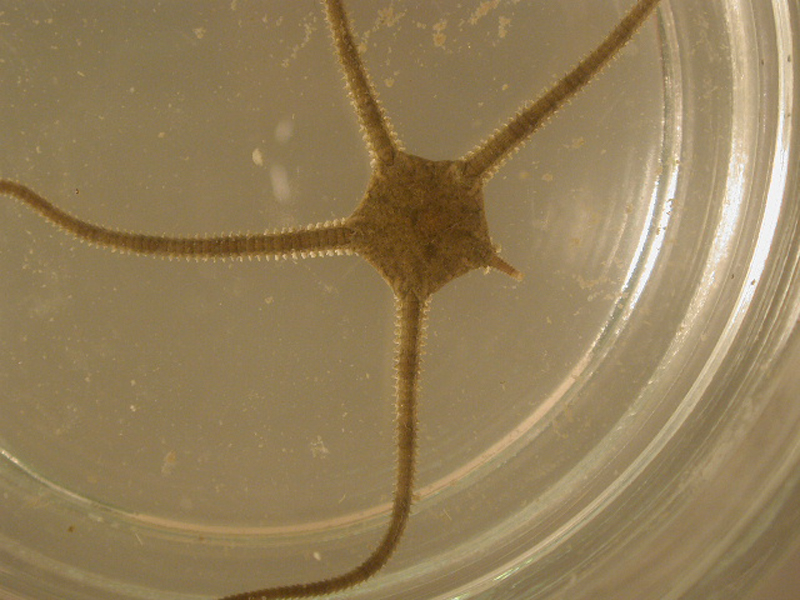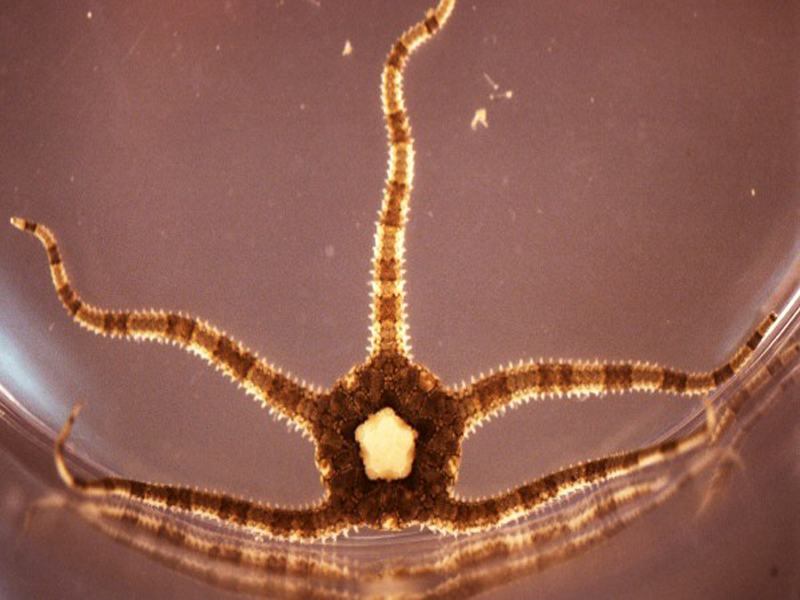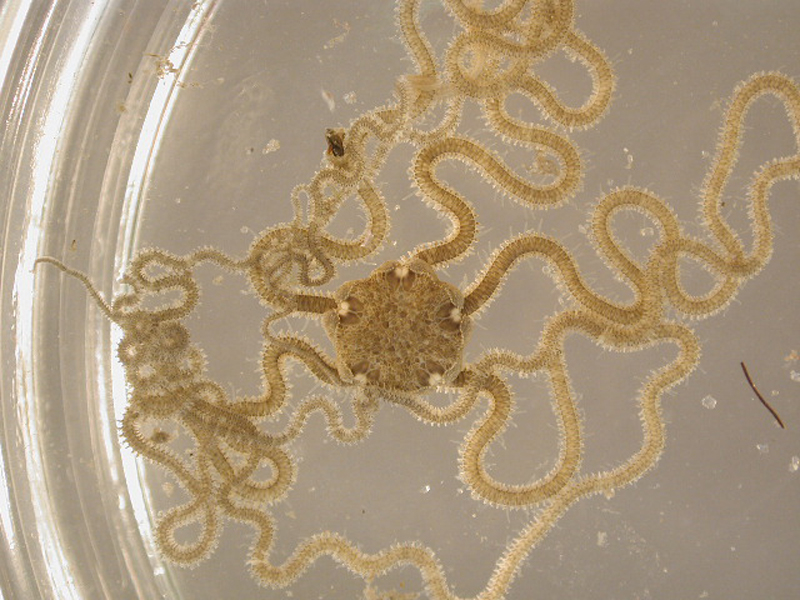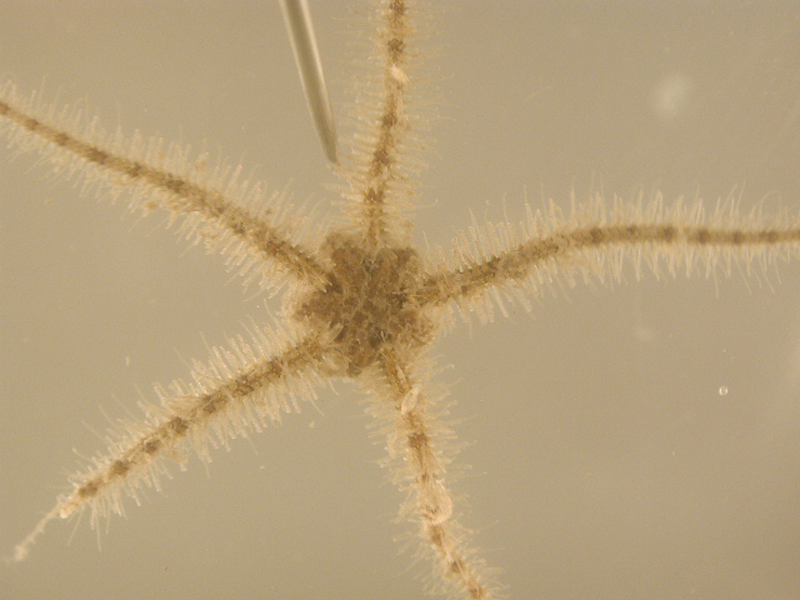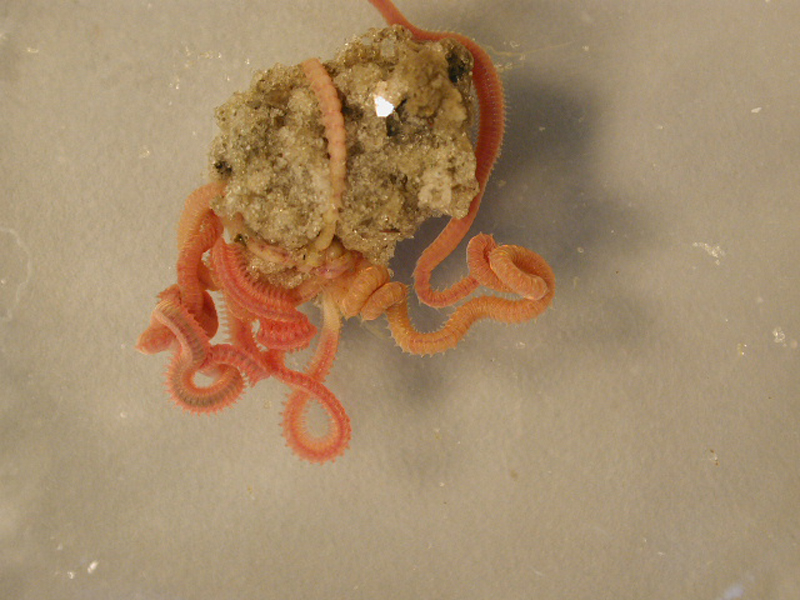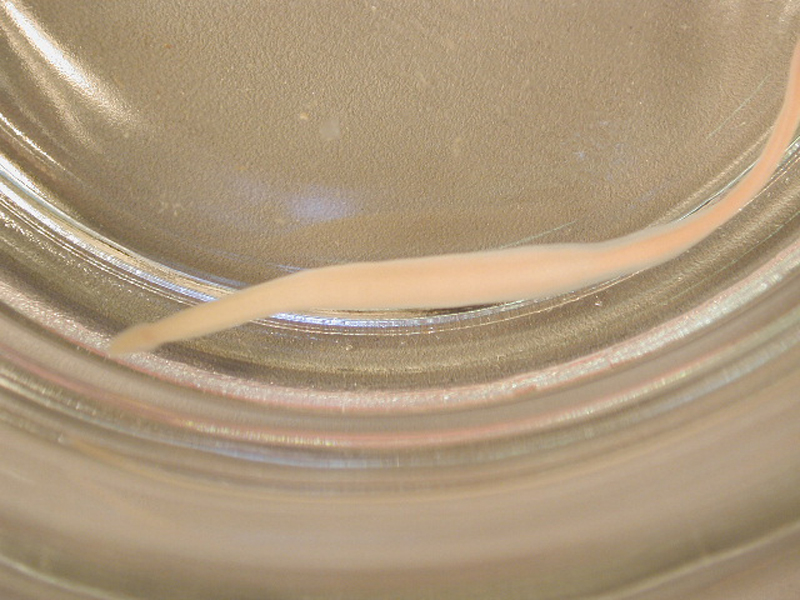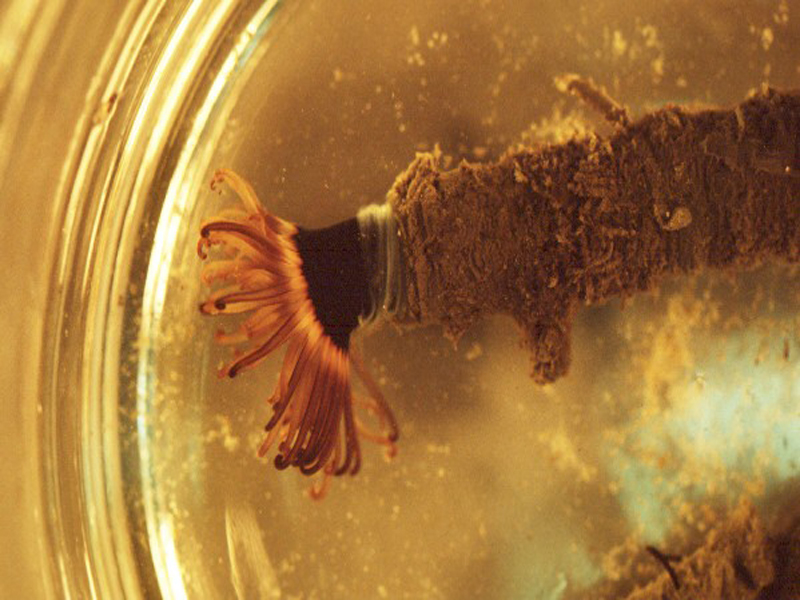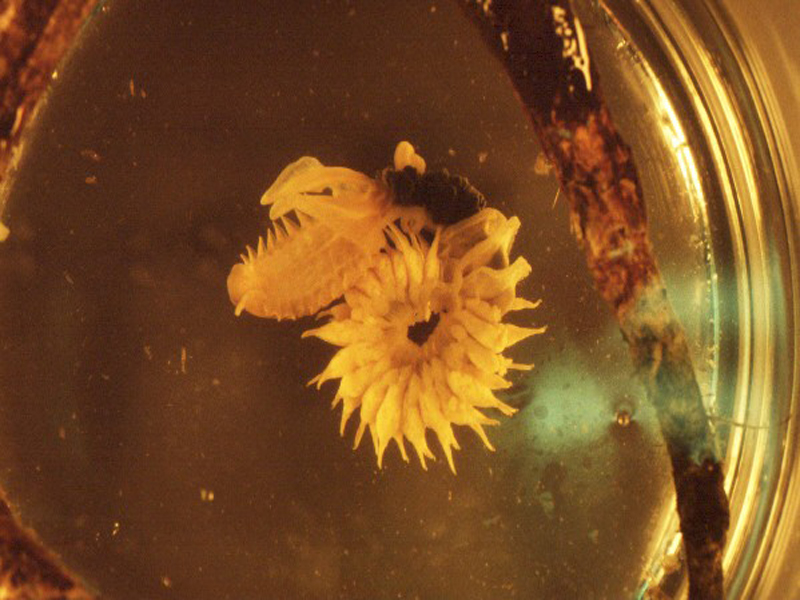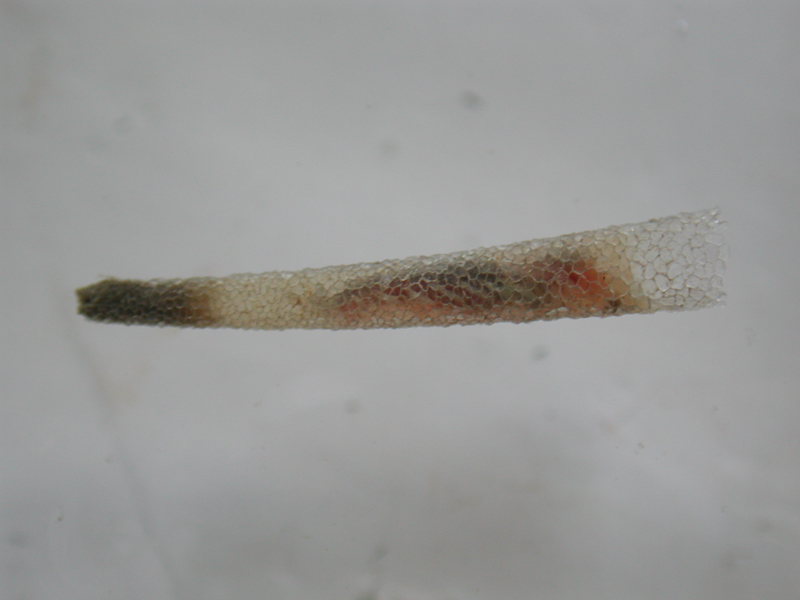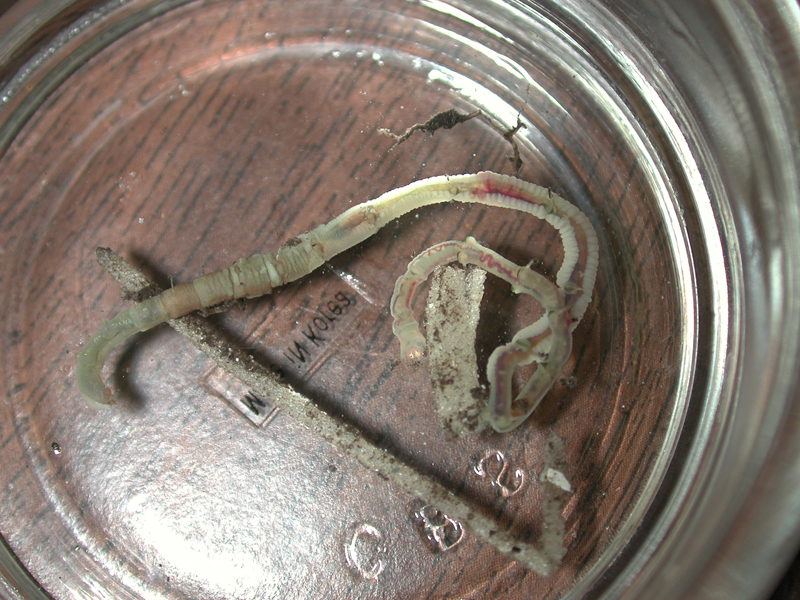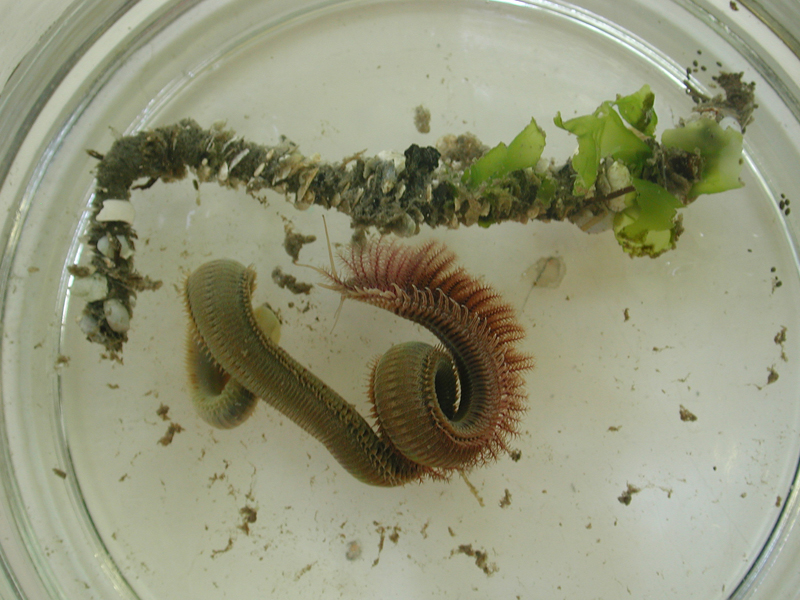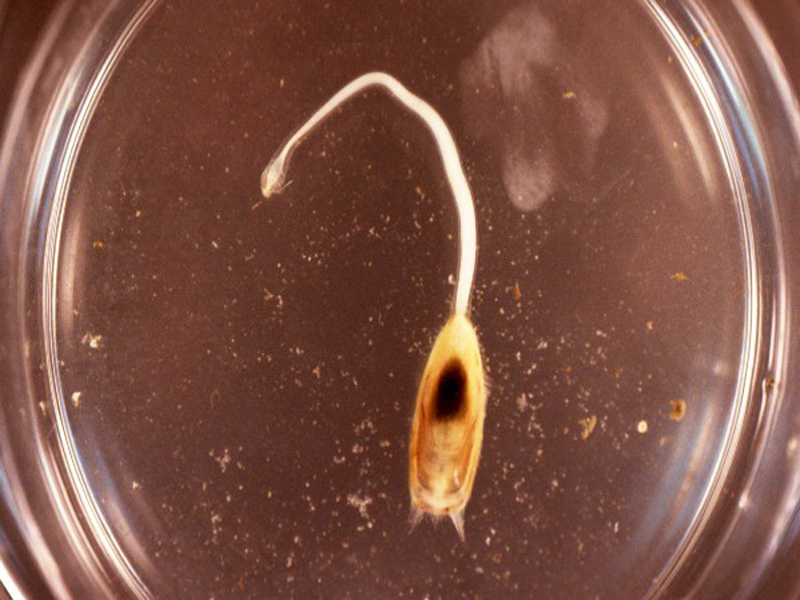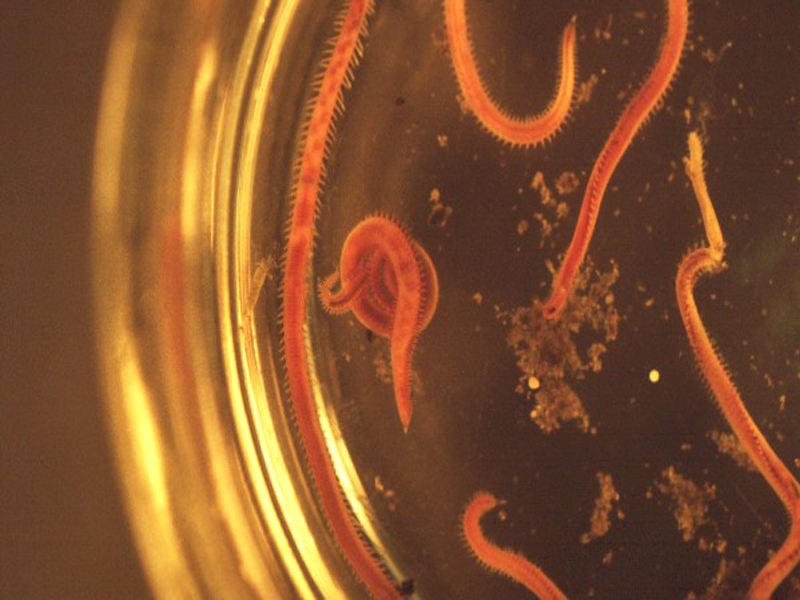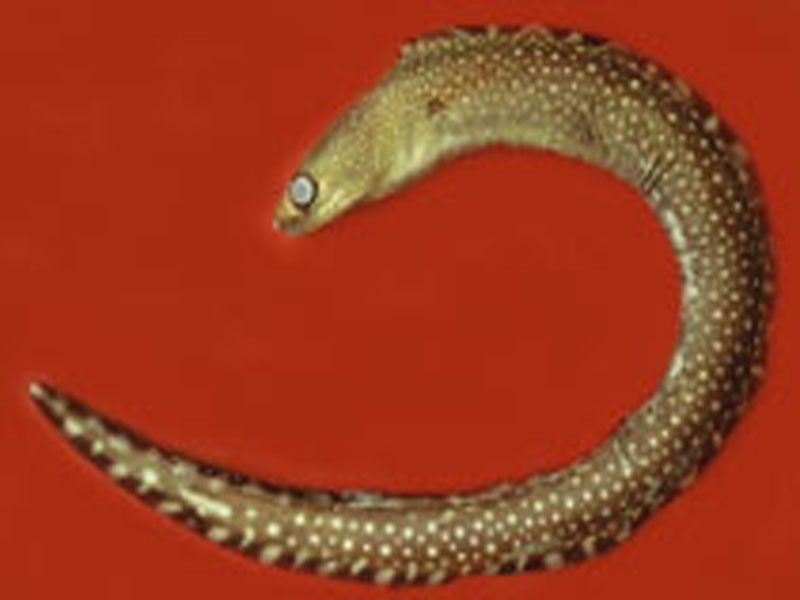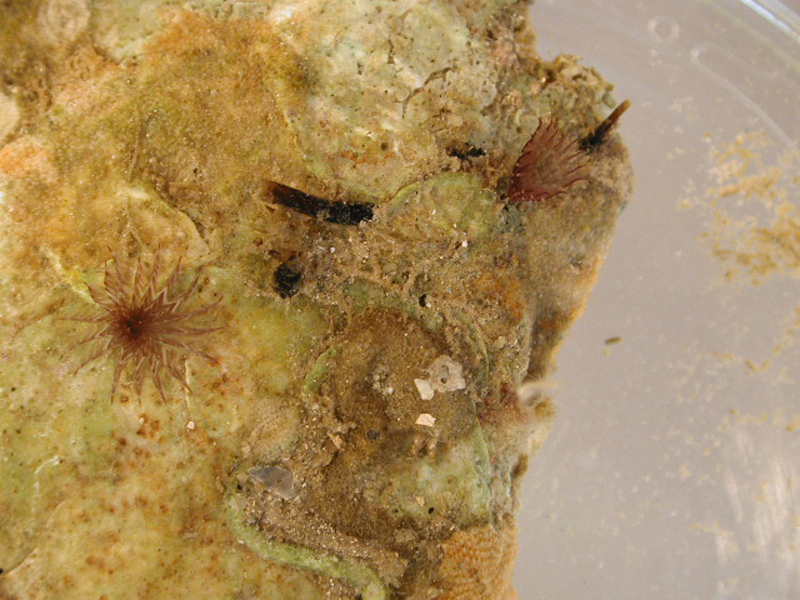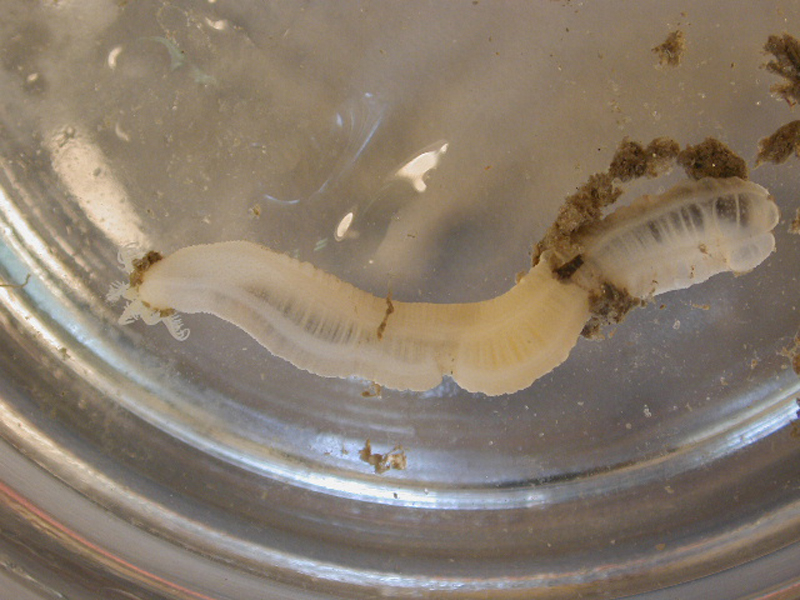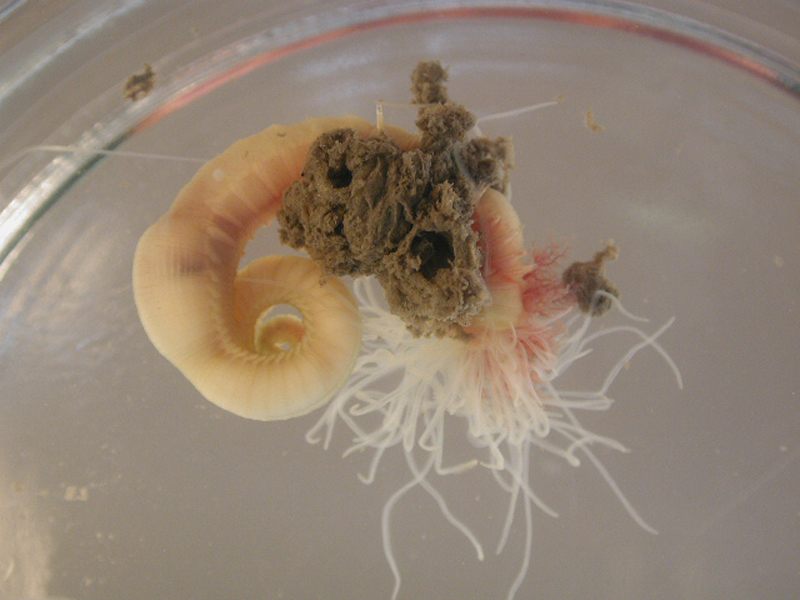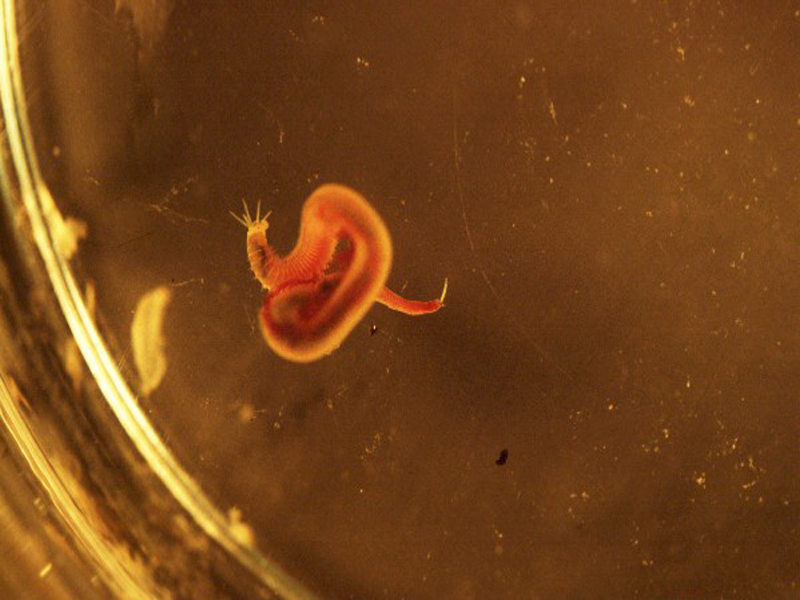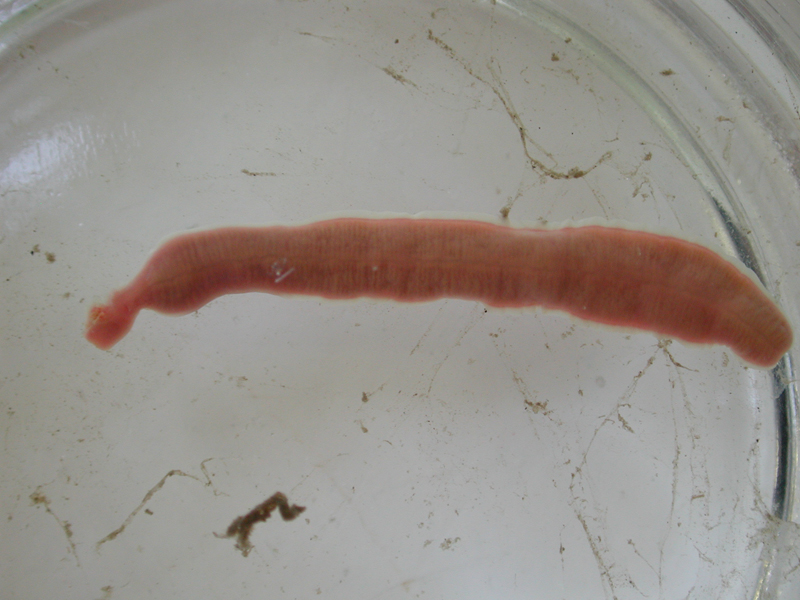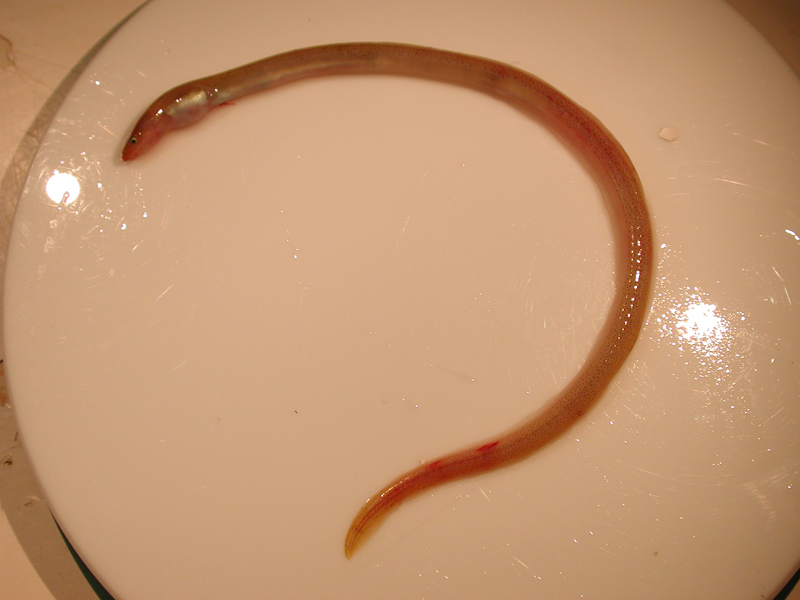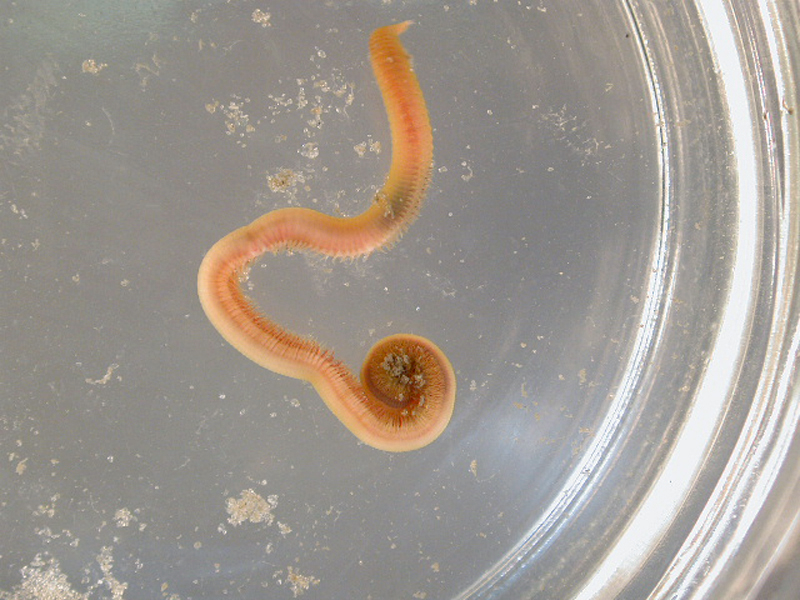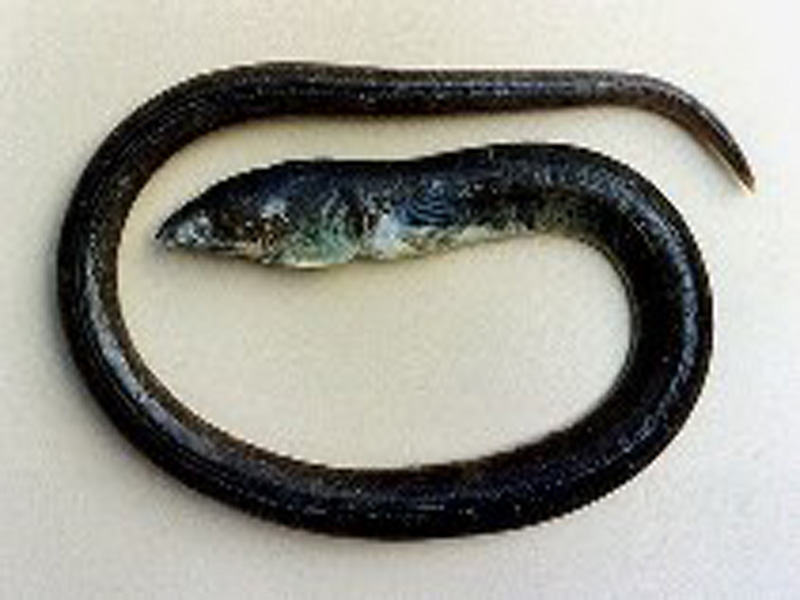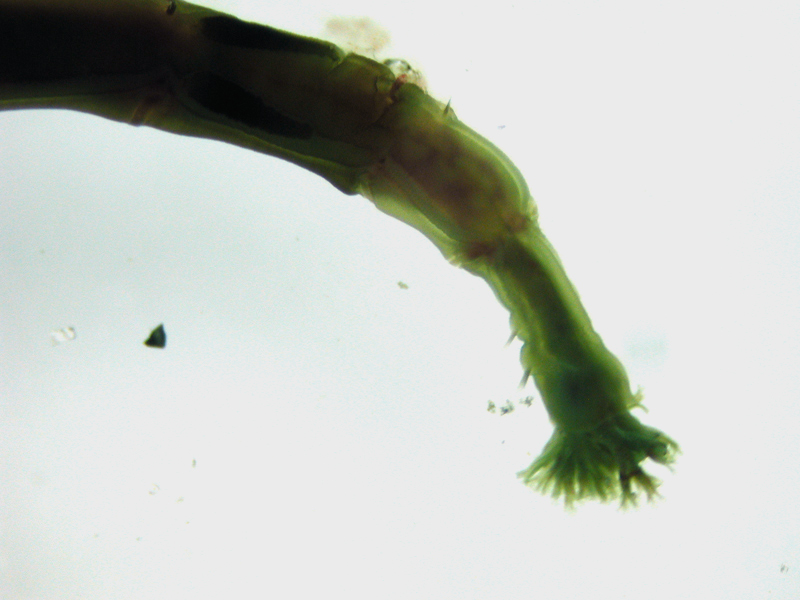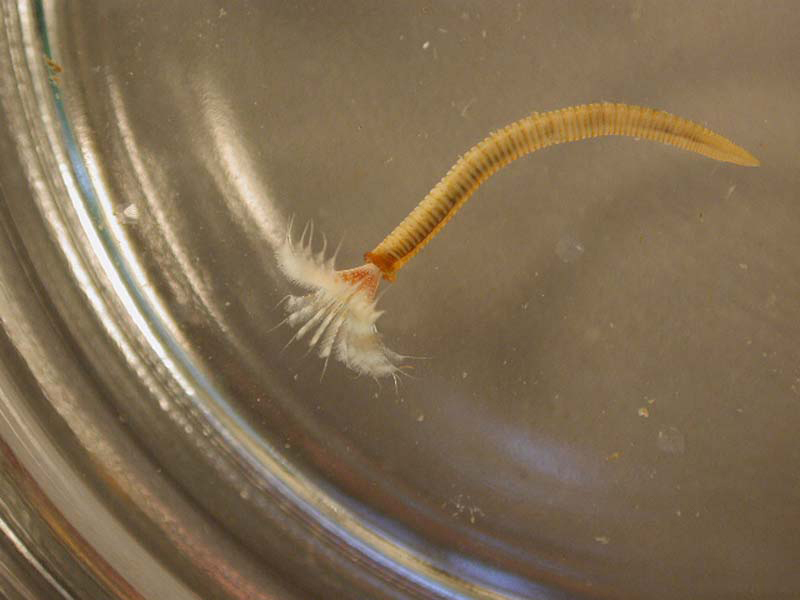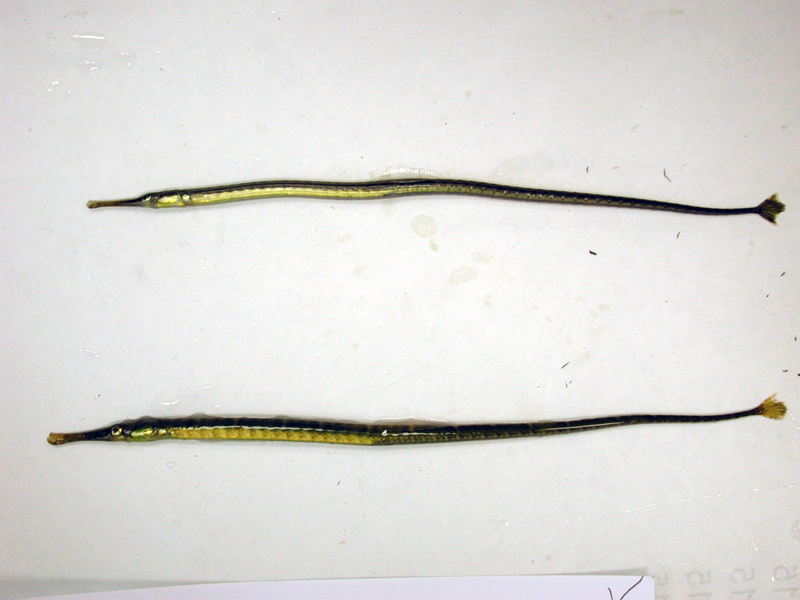Hairy Cucumber, Mexican Thyone
Description
Similar to the brown cucumber, the hairy cucumber is found in subtidal, seagrass beds of the Gulf and Caribbean. Growing only to 2 inches long, it has grayish podia (feet) scattered all over its body with only those on the lower surface having suckers.
What Are The Effects On Clams?
This sea cucumber is a detritivore, meaning that it feeds on organic wastes. In doing so, it can consume clam feces and pseudofeces, removing these wastes from the clam bag.
- FRIEND
What Can A Clam Farmer Do?
No action needs to be taken by a clam farmer.
Sea Pork
Description
Sea pork tunicates grow as plate-like, irregular or spherical masses attached to rocks or shells. Colonies are hard and very smooth. The surface is covered with circular groups of pores that give it a starred appearance. It is pale bluish to sea green in coloration. When colonies wash ashore, they bleach white and may look like slices of salt pork or fat back. Sea pork colonies may be over an inch thick and more than 12 inches in diameter.
What Are The Effects On Clams?
Sea squirts (tunicates) are filter or suspension feeders and can compete for the same type of food (micro algae) as clams. This tunicate can form a large, hard rubbery mat on the surface of clam bags or cover netting.
- FOE
- Competitor
- Fouler
What Can A Clam Farmer Do?
Clam bags should be inspected to determine the extent of fouling, particularly at lease sites with limited tidal exchange and when water temperatures are high. Extensive fouling may limit water flow to the clams and could result in suffocation. If it becomes a problem, fouled cover netting could be removed and clean cover netting replaced over the bags. This tunicate can be difficult to remove from the bag or cover net surface.
Mottled Sea Hare
Description
The mottled sea hare is found in seagrass beds and protected sand flats of shallow waters where macro algae (sea grasses) are abundant. This swimming species is extremely variable in color, with the background color varying from yellow brown, brown gray, green or black, and is relatively large, growing up to 10” long. Sea hares are so called because of the fancied resemblance of the second pair of antennae to a hare's long ears, and the similarity of the animal's general shape to that of a crouched hare. Like their namesakes, sea hares are herbivorous, eating eelgrass and a variety of red, green, and brown algae from whose pigment they derive their color. An interesting feature is that they emit a cloud of purple mucus when disturbed.
What Are The Effects On Clams?
This large “shell-less”snail has a voracious appetite for sea lettuce and can help keep clam bags free of macro algae.
- FRIEND
What Can A Clam Farmer Do?
No action needs to be taken by a clam farmer.
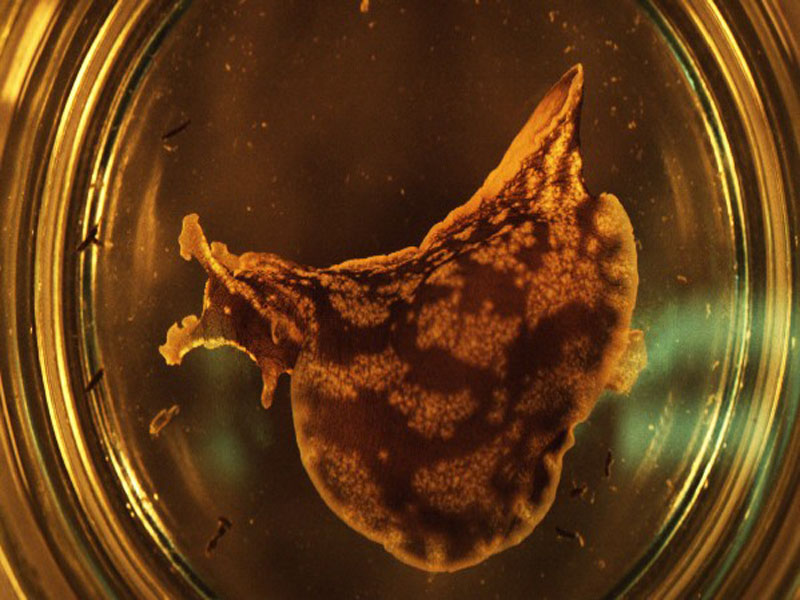
Taxonomy
- Kingdom:Animalia
- Phylum: MOLLUSCA
- SubPhylum:
- Class: Gastropoda
- Order: Anaspidea
- Family: Aplysiidae
- Genus: Aplysia
- Species: brasiliana
Purple Acorn Barnacle
Description
The purple acorn barnacle ranges from Massachusetts to the Gulf of Mexico and the West Indies. This small barnacle, like most barnacles, is sedentary, settling on almost any hard substrate, including rocks, pilings, shells, debris, mangrove roots, and crabs and cementing itself there for the duration of its life. All barnacles are also filter feeders, sticking their feather-like legs (cirri) out through the top to catch passing plankton. The purple acorn is conical, with light purple stripes running the length of each plate. It has four movable plates that close the top hole when its not feeding to protect the animal. Dead barnacles are identified by the lack of these movable plates. The name “acorn” refers to the lack of a stalk in this barnacle species. It can reach almost 1 inch in height.
What Are The Effects On Clams?
Barnacles can have a two-fold effect on clams. As a filter or suspension feeder, barnacles can compete for the same type of food (micro algae) as clams. They can also attach to cover netting and to the clam shells themselves. This can result in mechanical interference with clams, preventing them from opening up, feeding or burying. Fouling on the shells can make clams less desirable for marketing.
- FOE
- Competitor
- Fouler
What Can A Clam Farmer Do?
Fouling of barnacles on clams within the bag is usually a result of the bag not being able to bury completely in the bottom substrate. A grower should limit the use of lease bottoms that are excessively hard or contain shell hash during periods of peak barnacle sets. Generally barnacles do not set directly on the soft clam bag mesh. In most cases, they are found on oyster shells attached to the bag. However, clam bags dipped in net coatings, result in a stiffer bag surface and may allow for settlement of barnacles. Gloves are necessary when handling bags covered with barnacles as the shells are sharp.
Ivory Barnacle
Description
The ivory barnacle is the most common barnacle found in the Gulf of Mexico and southeastern U.S., growing on oysters, rocks, pilings, and mangrove roots close to the low tide line. It is comprised of 2 pairs of plates overlapping 1 or 2 unpaired plates. There are two pairs of grooved plates on top that move to allow the feeding apparatus to extend. The shells are entirely white and, like other barnacles, this barnacle is a filter feeder. It is also like the purple acorn barnacle, as it does not have a stalk. It is a rather large barnacle, reaching 3 inches in length, and up to 1 inch in height.
What Are The Effects On Clams?
Barnacles can have a two-fold effect on clams. As a filter or suspension feeder, barnacles can compete for the same type of food (micro algae) as clams. They can also attach to cover netting and to the clam shells themselves. This can result in mechanical interference with clams, preventing them from opening up, feeding or burying. Fouling on the shells can make clams less desirable for marketing.
- FOE
- Competitor
- Fouler
What Can A Clam Farmer Do?
Fouling of barnacles on clams within the bag is usually a result of the bag not being able to bury completely in the bottom substrate. A grower should limit the use of lease bottoms that are excessively hard or contain shell hash during periods of peak barnacle sets. Generally barnacles do not set directly on the soft clam bag mesh. In most cases, they are found on oyster shells attached to the bag. However, clam bags dipped in net coatings, result in a stiffer bag surface and may allow for settlement of barnacles. Gloves are necessary when handling bags covered with barnacles as the shells are sharp.
Striped Barnacle
Description
The striped barnacle has a similar appearance to the purple acorn barnacle. It also has a similar range, though it does not extend nearly as far north, commonly found in the shallow waters of the southeastern U.S. It has a rough shell, with a triangular opening covered by deep-seated closing plates. It has two sets of 4 or 5 dark purple lines down each plate. As in the other “acorn”-type barnacles, it is a sedentary animal that filter feeds using feather-like feet (cirri) and is not perched upon a stalk. This barnacle reaches 1 inch in height.
What Are The Effects On Clams?
Barnacles can have a two-fold effect on clams. As a filter or suspension feeder, barnacles can compete for the same type of food (micro algae) as clams. They can also attach to cover netting and to the clam shells themselves. This can result in mechanical interference with clams, preventing them from opening up, feeding or burying. Fouling on the shells can make clams less desirable for marketing.
- FOE
- Competitor
- Fouler
What Can A Clam Farmer Do?
Fouling of barnacles on clams within the bag is usually a result of the bag not being able to bury completely in the bottom substrate. A grower should limit the use of lease bottoms that are excessively hard or contain shell hash during periods of peak barnacle sets. Generally barnacles do not set directly on the soft clam bag mesh. In most cases, they are found on oyster shells attached to the bag. However, clam bags dipped in net coatings, result in a stiffer bag surface and may allow for settlement of barnacles. Gloves are necessary when handling bags covered with barnacles as the shells are sharp.
Pacific Colonial Tunicate
Description
The Pacific colonial tunicate is native to Japan but was accidentally introduced to California in the late 1970s. By the 1980s it had become very common in estuaries throughout New England. Pacific colonial tunicates live on eelgrass, seaweeds, pilings, and other hard substrates in shallow waters. Color of Pacific colonial tunicates is variable, but they are usually bright orange. Individual zooids (structures of individual animals) are arranged in meandering rows. Pacific colonial tunicates grow to over 10 inches in diameter and about 1/8 inch thick.
What Are The Effects On Clams?
Sea squirts (tunicates) are filter or suspension feeders and can compete for the same type of food (micro algae) as clams. The colonial tunicate could potentially settle and cover clam bags and cover netting.
- FOE
- Competitor
- Fouler
What Can A Clam Farmer Do?
The Pacific colonial tunicate has not been sighted in the Suwannee Sound area, but has recently been found in Tampa Bay. If a suspected tunicate colony is found, growers should report to the Nonindigenous Aquatic Species Program at 877-STOP-ANS or on the Internet at the website: http://nas.er.usgs.gov. If possible, save samples by freezing.
Golden Star Tunicate
Description
The golden star tunicate grows on eelgrass, seaweeds, pilings and other hard substrates. Colonies are dark brown, green, or purple; while the star-shaped clusters of tiny individual zooids (structures of individual animals) are each 1/16 inches long and yellow or white in coloration. Golden star colonies grow to over 8 inches in diameter and 1/8th inch thick.
What Are The Effects On Clams?
Sea squirts (tunicates) are filter or suspension feeders and can compete for the same type of food (micro algae) as clams. The golden star tunicate is not as commonly found as the white crust tunicate, but this colonial tunicate can potentially cover clam bags and cover netting.
- FOE
- Competitor
- Fouler
What Can A Clam Farmer Do?
Clam bags should be inspected to determine the extent of fouling, particularly at lease sites with limited tidal exchange and when water temperatures are high. Extensive fouling may limit water flow to the clams and could result in suffocation. If it becomes a problem, fouled cover netting could be removed and clean cover netting replaced over the bags.
Ragged Sea Hare
Description
The ragged sea hare is a soft, flabby, plump snail, with adults having no shell at all. Found from the Gulf of Mexico to the Caribbean in grassy areas of shallow, protected waters, it grazes on macro algae within the grassy areas, and lays its eggs in large, tangled masses of spaghetti-like strings. This swimming snail has a green-grey to olive-green color with white specks and is covered in highly branched filaments. When handled or disturbed, the ragged sea hare, like other sea hares, gives off a deep purple ink. It reaches 4 inches in length.
What Are The Effects On Clams?
This is large “shell-less” snail that has an appetite for green macro algae and can help keep clam bags free from fouling.
- FRIEND
What Can A Clam Farmer Do?
No action needs to be taken by a clam farmer.
Yellow Boring Sponge
Description
The yellow boring sponge is found growing on rocks, shells, and corals in the subtidal zone and may overgrow its substrate entirely. The lobe-shaped, hard sponge appears bright yellow with pimple-like pores. Dried specimens appear woody and brown with dots surrounded by faint circles. Large specimens can measure up to 3 feet across and 1½ feet high, while individuals are less than 1/8 inch in width.
What Are The Effects On Clams?
Larvae of this sponge settle on shells and develop into tiny sponges. By secreting sulfuric acid, the sponge bores into the calcareous shell of mollusks (oysters and clams). Affected shells are riddled with small holes (about 1/8”), creating a honeycomb of tunnels. The shell can be weakened to the point of disintegration, resulting in the death of the mollusk.
- FOE
- Fouler
What Can A Clam Farmer Do?
This sponge may be controlled by exposure to sun in early stages of development.
White Crust
Description
White crust tunicates (sea squirts) resemble a splash of white paint on firm surfaces, including rock rubble and seaweeds. Colonies look smooth but feel gritty due to calcareous spicules (dart-like or needle-like structures supporting the tissue of the tunicate). When the colony is damaged, it releases sulfuric acid and vanadium, which are toxic to most marine organisms. White crust is only 1/10 of an inch in thickness, but can exceed 4-8 inches in diameter.
What Are The Effects On Clams?
Sea squirts (tunicates) are filter or suspension feeders and can compete for the same type of food (micro algae) as clams. This colonial tunicate can cover large surface areas of hard bottom substrate, as well as clam bags and cover netting.
- FOE
- Competitor
- Fouler
What Can A Clam Farmer Do?
Clam bags should be inspected to determine the extent of fouling, particularly at lease sites with limited tidal exchange and when water temperatures are high. Extensive fouling may limit water flow to the clams and could result in suffocation. This tunicate can be difficult to remove from the bag or cover net surface.
Frog Egg Tunicate
Description
Frog egg tunicates (sea squirts) grow on hard objects, such as rocks, but will also grow on other fouling organisms, such as hydroids and bryozoans. Colonies are thin, gelatinous, and slimy. The body of an individual tunicate is greenish-grey and is imbedded in a transparent structure, making the colony resemble an amphibian egg mass. Frog egg tunicates are 1/10 of an inch thick and 4 inches or more in diameter.
What Are The Effects On Clams?
Sea squirts (tunicates) are filter or suspension feeders and can compete for the same type of food (micro algae) as clams. This colonial tunicate can cover large surface areas of hard bottom substrate, as well as clam bags and cover netting.
- FOE
- Competitor
- Fouler
What Can A Clam Farmer Do?
Clam bags should be inspected to determine the extent of fouling, particularly at lease sites with limited tidal exchange and when water temperatures are high. Extensive fouling may limit water flow to the clams and could result in suffocation. This tunicate can be difficult to remove from the bag or cover net surface.
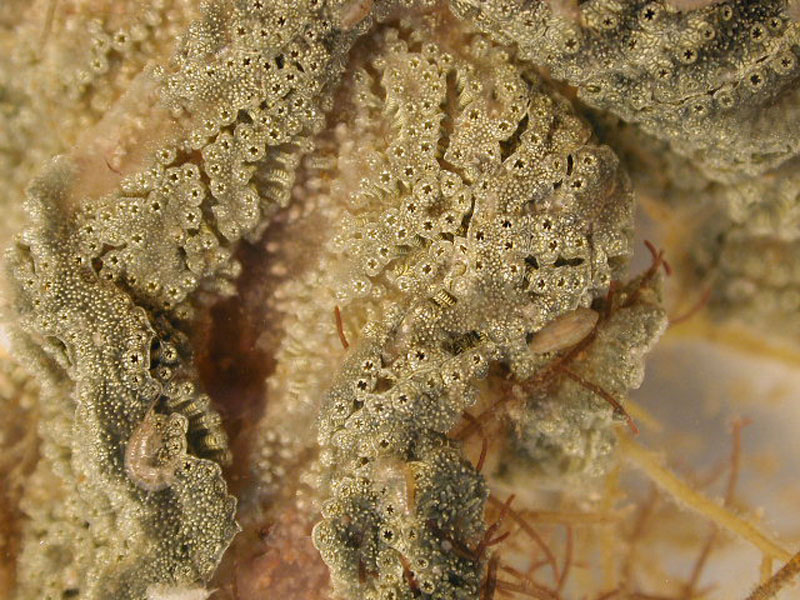
Taxonomy
- Kingdom:Animalia
- Phylum: CHORDATA
- SubPhylum: Urochordata
- Class: Ascidiacea
- Order: Aplousobranchia
- Family: Didemnidae
- Genus: Diplosoma
- Species: listerianum
Orange Tunicate, Mangrove Tunicate
Description
The orange or mangrove tunicate grows attached to mangrove roots, turtle grass and other surfaces. Individual zooids (bodies of individual animals) occur in clumps, joined at their bases by a “root.” They are transparent with orange markings on the siphons. Individual orange tunicates are about 1 inch long.
What Are The Effects On Clams?
Sea squirts (tunicates) are filter or suspension feeders and can compete for the same type of food (micro algae) as clams. Each individual "polyp" of this colonial tunicate is a hungry mouth. The tunicate can attach by its “root” to clam bags and can be a major fouler.
- FOE
- Competitor
- Fouler
What Can A Clam Farmer Do?
Clam bags should be inspected to determine the extent of fouling, particularly at lease sites with limited tidal exchange and when water temperatures are high. Extensive fouling may limit water flow to the clams and could result in suffocation. If it becomes a problem, fouled cover netting could be removed and clean cover netting replaced over the bags. Individual squirts can be manually removed from the bag surface by hand or brush and will not reattach.
Sea Liver
Description
The sea liver tunicate is a colonial animal which can be very extensive and thickly cover substrates, such as docks. Colonies are purple, with large, rubbery, slippery lobes, resembling liver. It may turn white in the winter. The tiny brownish zooids (structures of individual animals), embedded in the colony, are arranged in groups of about 1/10 of an inch in diameter. Juvenile crabs often occupy the folds and creases of colonies. The surface of sea liver colonies is rarely fouled by other organisms.
What Are The Effects On Clams?
Sea squirts (tunicates) are filter or suspension feeders and can compete for the same type of food (micro algae) as clams. The sea liver tunicate is not as commonly found as the white crust tunicate, but this colonial tunicate can potentially cover clam bags and cover netting.
- FOE
- Competitor
- Fouler
What Can A Clam Farmer Do?
Clam bags should be inspected to determine the extent of fouling, particularly at lease sites with limited tidal exchange and when water temperatures are high. Extensive fouling may limit water flow to the clams and could result in suffocation. If it becomes a problem, fouled cover netting could be removed and clean cover netting replaced over the bags.
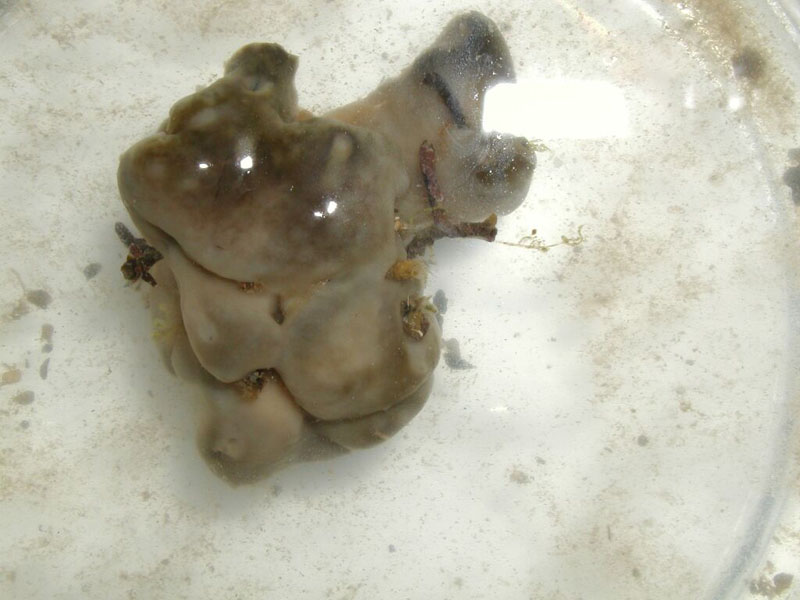
Taxonomy
- Kingdom:Animalia
- Phylum: CHORDATA
- SubPhylum: Urochordata
- Class: Ascidiacea
- Order: Aplousobranchia
- Family: Polycitoridae
- Genus: Eudistoma
- Species: hepaticum
Bread Sponge
Description
The bread sponge is found on protected undersides of stones, pilings, and other hard substrates, including animals, from the low-tide line to waters more than 200 feet deep. It thrives in harbors and estuaries where it is tolerant of muddy and brackish conditions. It is often found intertwined with hydroids and algae. This sponge has a thin crust that can appear yellow, olive, or beige and can vary in form from cushion-like to gnarled, finger-like branches. The sponge pores are prominent with tiny conical projections which create a texture resembling bread crumbs. The bread sponge can grow 12 inches wide and 2 inches high.
What Are The Effects On Clams?
This sponge can form mats and potentially spread over the surface of clam bags and cover netting.
- FOE
- Fouler
What Can A Clam Farmer Do?
Clam bags should be inspected to determine the extent of fouling, particularly at lease sites with limited tidal exchange and when water temperatures are high. Extensive fouling may limit water flow to the clams and could result in suffocation. If it becomes a problem, fouled cover netting could be removed and clean cover netting replaced over the bags. Air drying would be the only effective means of removing this sponge from clam bags.
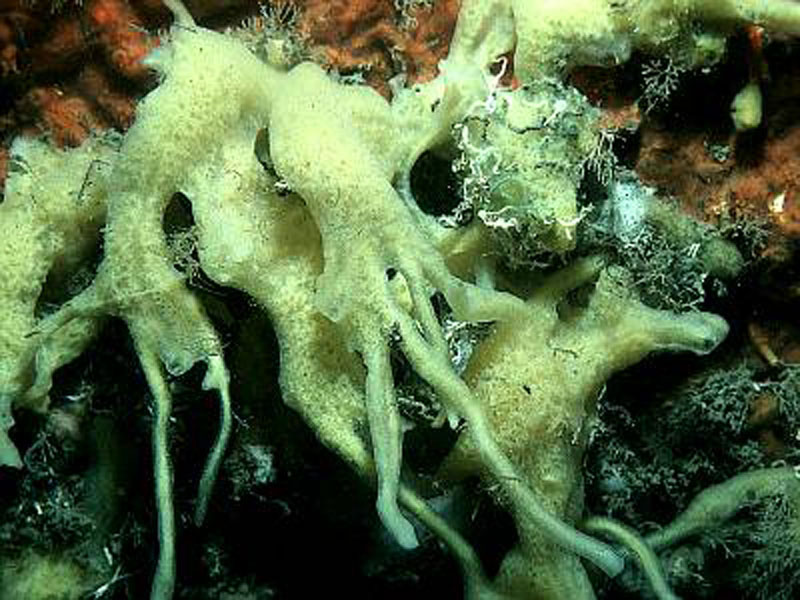
Taxonomy
- Kingdom:Animalia
- Phylum: PORIFERA
- SubPhylum:
- Class: Demospongiae
- Order: Halichondrida
- Family: Halichondridae
- Genus: Halichondria
- Species: bowerbanki
Humans
Description
Humans are bipedal (two-legged) apes belonging to the great ape family. Humans have a highly developed brain capable of abstract reasoning, language, and introspection. This, combined with an erect body carriage that frees their upper limbs for manipulating objects, allows them to make greater use of tools than any other species. Like most primates, humans are by nature social. However, humans are particularly adept at utilizing systems of communication for self-expression and the exchange of ideas. Humans inhabit every continent with a total population of over 6.5 billion people as of 2006.
What Are The Effects On Clams?
First and foremost, humans are consumers of clams, and purchase clams grown by farmers for consumption. Humans live in coastal areas, often in sight of clam aquaculture leases. Their activities on land, such as waste disposal, placement of dwellings (zoning density), and use of fertilizers and pesticides, can affect the quality of inshore waters, the management plan of the shellfish harvesting area, and the safety of shellfish for human consumption. Humans also use inshore coastal waters for boating, fishing and recreational activities, as well as other commercial activities, such as crabbing. Sometimes these activities can cause problems for clam farmers and their crops. In particular, clam bags can be cut by a motor’s propeller when a boater runs over a lease at low tide. Further, some growers use SCUBA or hookah rigs to work their crops on high tides or on deeper leases. Unaware boaters could potentially snag this equipment causing harm to the diver. Finally, one of the biggest predators of clams is human. Losses of cultured clams from theft can be significant.
- FRIEND, FOE, NEIGHBOR
- Competitor
- Predator
What Can A Clam Farmer Do?
Education is the key. To increase consumption of clams, a clam farmer, as well as wholesalers and retailers, must provide information to the public about the nutritional value of clams and tips on how to store, handle, and prepare clams. Marketing brochures and recipes are available through the Florida Department of Agriculture and Consumer Services, Bureau of Seafood and Aquaculture Marketing. <HYPERLINK TO http://www.fl-seafood.com/recipes/clam_recipes.htm>. A clam farmer must educate their neighbors as to the economic and environmental importance of clam farming to ensure land use regulations and practices are favorable to maintaining and preserving water quality standards for shellfish harvesting. A clam farmer must also educate boaters, informing them of the location of lease areas as well as the activities conducted on their farms. Educational signs placed at marinas, boat ramps, and on aquaculture lease markers can be used to provide appropriate warnings to the public. Further, growers must display a Diver-Down flag when using SCUBA gear or hookah rigs on their leases. Although control of human predators is problematic, cultured clams are protected by state law (Chapter 812.014, Florida Statues). Stealing of clams is grand theft of the third degree and a felony of the third degree. Some clam farmers must employ security measures, such as continuous surveillance, in order to prevent significant losses due to theft. The Florida Department of Agriculture and Consumer Services provides a reward of up to $2,500 for information leading to the arrest and conviction of individuals unlawfully possessing or harvesting cultured shellfish. Violations are to be reported to 1-800-DIAL-869.
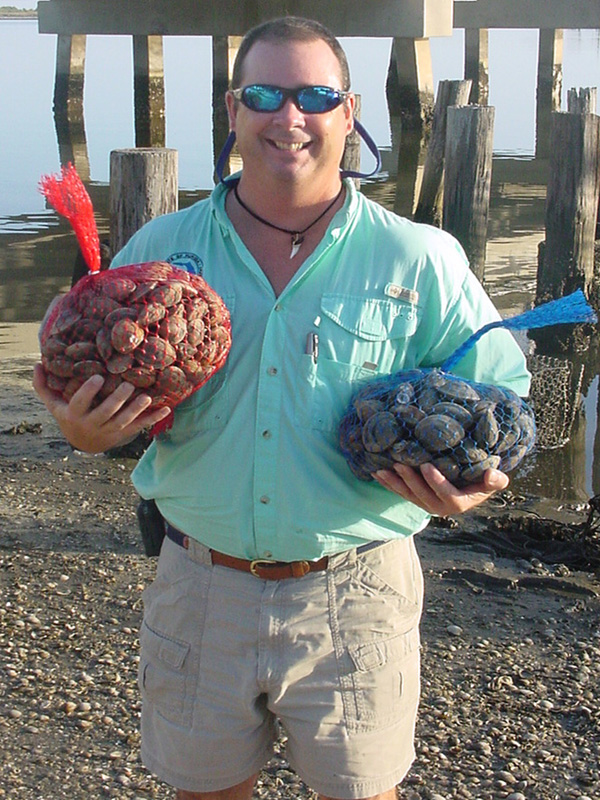
Taxonomy
- Kingdom:Animalia
- Phylum: CHORDATA
- SubPhylum: Vertebrata
- Class: Mammalia
- Order: Primata
- Family: Hominidae
- Genus: Homo
- Species: sapiens
Sun Sponge
Description
The sun sponge is a low growing sponge that can be found in shallow waters with direct sunlight. It occurs intertidally anchored on shell debris in sand, oysters, and other hard objects, and is tolerant of short periods of air exposure. The sponge may exceed 16 inches in diameter and appear as encrusting sheets with numerous erect, rough, finger-like projections. Coloration can vary from light yellow with olive green tints in sunny areas to deep orange or reddish-orange in shaded areas. The sponge’s configuration offers habitat to numerous smaller animals like shrimps, crabs, and brittle stars.
What Are The Effects On Clams?
This sponge can form mats and potentially spread over the surface of clam bags and cover netting.
- FOE
- Fouler
What Can A Clam Farmer Do?
Clam bags should be inspected to determine the extent of fouling, particularly at lease sites with limited tidal exchange and when water temperatures are high. Extensive fouling may limit water flow to the clams and could result in suffocation. If it becomes a problem, fouled cover netting could be removed and clean cover netting replaced over the bags. Air drying for at least 24 hours would be the only effective means of removing this sponge from clam bags.
Garlic Sponge
Description
The garlic sponge is found on pilings and seagrasses in shallow waters. It often is seen surrounding individual blades of grass, growing to fist size. This sponge can appear yellow, blue, or green-gray externally, and is tan internally. Its shape can be amorphous, irregular, and sometimes mound-like with lobed edges. The surface is usually smooth with conspicuous, randomly distributed pores. When broken, it emits a strong odor of garlic, hence its common name. The garlic sponge can reach a height of 8 inches.
What Are The Effects On Clams?
This sponge can form mats and potentially spread over the surface of clam bags and cover netting.
- FOE
- Fouler
What Can A Clam Farmer Do?
Clam bags should be inspected to determine the extent of fouling, particularly at lease sites with limited tidal exchange and when water temperatures are high. Extensive fouling may limit water flow to the clams and could result in suffocation. If it becomes a problem, fouled cover netting could be removed and clean cover netting replaced over the bags. Air drying would be the only effective means of removing this sponge from clam bags.
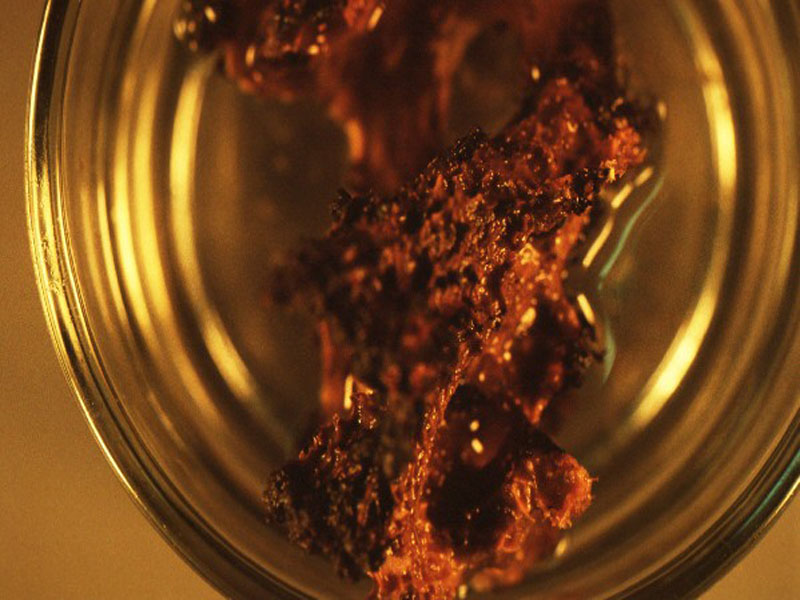
Taxonomy
- Kingdom:Animalia
- Phylum: PORIFERA
- SubPhylum:
- Class: Demospongiae
- Order: Poecilosclerida
- Family: Tedaniidae
- Genus: Lissodendoryx
- Species: isodictyalis
Sea Mat
Description
The common sea mat is a calcareous, encrusting bryozoan that forms a white, lacy mat on rocks, shells, and other hard substrates, and is very common in shallow areas along the Florida coast and the Gulf of Mexico. It is a colonial animal with colonies reaching many inches in length. The rectangular body chamber of individual animals is structurally continuous with that of others in the colony, with each animal enclosed in its own box-like exoskeleton. The feeding apparatus is contained within this box, and is extended to feed upon passing plankton.
What Are The Effects On Clams?
Bryozoans are filter or suspension feeders and can compete for the same type of food (micro algae) as clams. This bryozoan can also attach to clam shell surfaces, making the clam undesirable for market.
- FOE
- Competitor
- Fouler
What Can A Clam Farmer Do?
If the clam bag and clams themselves are completely buried in the bottom substrate, fouling and food competition should not occur.
Red Beard Sponge
Description
The red beard sponge is found on rocks, pilings, oysters, shells, and other hard objects in protected bays and estuaries below the low-tide line. This sponge appears bright orange to red and dried specimens are often brown. It varies from a thin encrusting layer less than 1/8 inch wide covering a few square inches to 8 inches high and 8 inches wide with many branches. Its knobby, multi-branched form makes identification easy.
What Are The Effects On Clams?
This sponge can form mats and potentially spread over the surface of clam bags and cover netting.
- FOE
- Fouler
What Can A Clam Farmer Do?
Clam bags should be inspected to determine the extent of fouling, particularly at lease sites with limited tidal exchange and when water temperatures are high. Extensive fouling may limit water flow to the clams and could result in suffocation. If it becomes a problem, fouled cover netting could be removed and clean cover netting replaced over the bags. Air drying would be the only effective means of removing this sponge from clam bags.
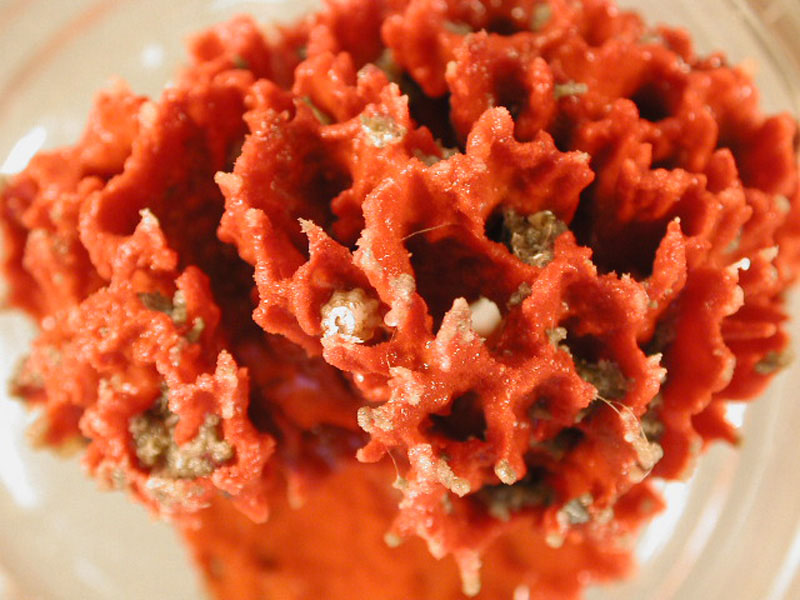
Taxonomy
- Kingdom:Animalia
- Phylum: PORIFERA
- SubPhylum:
- Class: Demospongiae
- Order: Poecilosclerida
- Family: Clathriidae
- Genus: Microciona
- Species: prolifera
Sea Walnut, Comb Jelly
Description
Despite its name, the comb jelly, or sea walnut, is not a jellyfish, as it is in a phylum all its own. It is comprised of two oval lobes with two small tentacles, and appears transparent. It is lined with four rows of cilia along the body, which help it move through the water. The cilia appear iridescent during the day and luminescent at night. The comb jelly is indigenous to Atlantic and Gulf of Mexico estuaries and inshore waters, though was recently introduced to the Black and Caspian Seas via ballast tanks of ships. Being a voracious predator of zooplankton, fish eggs and larvae, the comb jelly has had a catastrophic effect on the Black and Caspian Sea ecosystems. They are hermaphroditic, bearing both male and female organs, and have the capability of self fertilizing. The comb jelly can grow up to 4 inches in length.
What Are The Effects On Clams?
The comb jelly is rarely found in clam bags, but during the warmer months these animals can be found in "bloom" or large numbers that can greatly reduce the amount of zooplankton (microscopic animals) in the water column. When this happens, there is more phytoplankton (clam food) available for clams.
- FRIEND
What Can A Clam Farmer Do?
No action needs to be taken by a clam farmer.
Sea Grape
Description
Sea grape tunicates (sea squirts) are solitary, rather than colonial, but grow in groups, resembling slightly flattened milky white grapes. It may be fouled with other organisms such as hydroids or bryozoans, and may also be covered with silt or sand. The incurrent and excurrent siphons are not spaced very far apart, and are used to filter plankton out of the water and bring oxygenated water into the respiratory organs. When picked up and squeezed, they release water from their excurrent siphon in a tight stream, thus the name “sea squirt.” Individual sea grapes grow to 1 to 2 inches in height.
What Are The Effects On Clams?
Sea squirts (tunicates) are filter or suspension feeders and can compete for the same type of food (micro algae) as clams. This tunicate is one of the most commonly found fouling organisms affecting clam culture equipment. It sets individually on the surface of clam bags and cover netting. Because it binds with others, the sea grape can form dense mats over the entire surface of the bag.
- FOE
- Competitor
- Fouler
What Can A Clam Farmer Do?
Clam bags should be inspected to determine the extent of fouling, particularly at lease sites with limited tidal exchange and when water temperatures are high. Extensive fouling may limit water flow to the clams and could result in suffocation. If it becomes a problem, fouled cover netting could be removed and clean cover netting replaced over the bags. Individual squirts can be manually removed from the bag surface by hand or brush and will not reattach.
Sandy Sea Squirt
Description
The sandy sea quirt is a mud or sand colored solitary tunicate, commonly found along Florida and the Gulf of Mexico coasts. It is usually covered in mud or sand engrained into the animal, making it feel like sandpaper and resembling a ball of sand. The tunic, or thick tissue covering the sea squirt is tough and wrinkled while the mantle tissue is bright orange at the siphons. The incurrent and excurrent siphons are not spaced very far apart, and are used to filter plankton out of the water and bring oxygenated water into the respiratory organs. When picked up and squeezed, they release water from their excurrent siphon in a tight stream, thus the name “sea squirt.” Tunicates are primitive chordates, making them more closely related to humans than any other invertebrates. They can reach 2.5 inches in length.
What Are The Effects On Clams?
Sea squirts (tunicates) are filter or suspension feeders and can compete for the same type of food (micro algae) as clams. This tunicate does not attach to a surface; rather it settles inside a clam bag, usually before the bag is completely buried.
- FOE
- Competitor
What Can A Clam Farmer Do?
Although these animals can compete with clams for food, they are generally not found in high enough numbers to cause a problem. No practical control method is necessary.
Sea Onion
Description
The sea onion is a sea anemone that ranges from New England to the Gulf of Mexico. It is a burrowing anemone, found in coastal sandy areas, and can burrow up to 14 inches into the sand using a ventral attachment disk. It is translucent, with white longitudinal stripes running along the body. It contains up to 180 tentacles, brown in color due to the presence of zooxanthellae (one-celled plants that live inside cells and tissues of various invertebrates). Often only the short tentacles can be seen, used to catch drifting plankton. If disturbed, it will puff up into an onion-shaped mass and drift with the current to a new location.
What Are The Effects On Clams?
Although this anemone is a filter feeder and can potentially compete with clams for food, it most likely catches larger planktonic organisms than clams. It is rarely found in numbers high enough to cause a problem.
- FOE
- Competitor
What Can A Clam Farmer Do?
No practical control method is necessary.
Pigmy Sea Cucumber, Five-Lined Sea Cumber, Red Footed Sea Cucumber
Description
The pygmy sea cucumber is often seen adhering to substrate in shallow rocky bottoms or seagrass beds, usually in high salinity and clear waters. Its long body, which is stiffer than most other sea cucumbers, appears chocolate-brown in color with four rows of yellow or pink tube feet. The unusually large tube feet of this species are highly modified and are adapted for clinging. Ten feathery, black, tentacles located on the anterior end are used for feeding. The pygmy sea cucumber can reach a length of 4 inches.
What Are The Effects On Clams?
This sea cucumber is a detritivore, meaning that it feeds on organic wastes. In doing so, it can consume clam feces and pseudofeces, removing these wastes from the clam bag.
- FRIEND
What Can A Clam Farmer Do?
No action needs to be taken by a clam farmer.
Staghorn Bryozoan
Description
The staghorn bryozoan is a calcareous, encrusting bryozoan, ranging from North Carolina to the Gulf of Mexico, preferring warm waters. It settles upon three dimensional surfaces, such as sea grasses, sea whips and clam bags, forming orange to purple tubular colonies, resembling small clumps of coral. The rectangular body chamber of the individual animals is structurally continuous with that of others in the colony, with each animal enclosed in its own box-like exoskeleton. The feeding apparatus has multiple tentacles contained within this box, which extend and are used to feed on passing plankton.
What Are The Effects On Clams?
Bryozoans are filter or suspension feeders and can compete for the same type of food (micro algae) as clams. This bryozoan can attach to clam bags and cover netting, becoming a fouling nuisance.
- FOE
- Competitor
- Fouler
What Can A Clam Farmer Do?
Clam bags should be inspected to determine the extent of fouling, particularly at lease sites with limited tidal exchange and when water temperatures are high. Extensive fouling on the bags may limit water flow to the clams and could result in suffocation. If it becomes a problem, fouled cover netting could be removed and clean cover netting replaced over the bags. Bryozoan clumps can be manually removed from the bag surface by hand or brush and will not reattach.
Brown Sea Cucumber
Description
The brown sea cucumber is found on mud or sand bottoms from the low-tide line to water 20 feet deep. The hairy, pear-shaped body can be blackish, brownish, greenish, or purplish in color and is covered with slender, translucent, randomly distributed tube feet. Its soft body is wide in the middle and tapers towards the ends, with both ends oriented upwards. The animal burrows in the sediments with tentacles and anus projecting above the surface. Ten large, bushy tentacles located on the anterior end are used for feeding. This sea cucumber can grow up to 6 inches long and 2 inches wide.
What Are The Effects On Clams?
This sea cucumber is a detritivore, meaning that it feeds on organic wastes. In doing so, it can consume clam feces and pseudofeces, removing these wastes from the clam bag.
- FRIEND
What Can A Clam Farmer Do?
No action needs to be taken by a clam farmer.
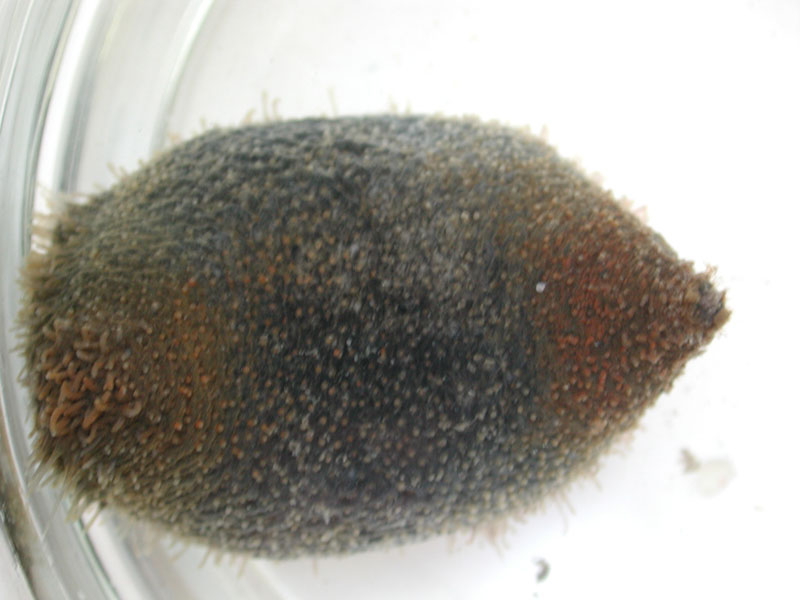
Taxonomy
- Kingdom:Animalia
- Phylum: ECHINODERMATA
- SubPhylum: Echinozoa
- Class: Holothuroidea
- Order: Dendrochirotida
- Family: Sclerodactylidae
- Genus: Sclerodactyla
- Species: briareus
White Baby Ear
Description
The white baby’s ear (locally known as "snot dog") is commonly found on sandy bottoms below the low-tide line in shallow waters. This snail has a white, wide, flattened shell with a thin, yellowish periostracum (the outer layer of the shell), and reaches a length of 2 inches and a width of 1 ¼ inches. Its white mantle (tissue that lines and secrets the mollusk shell) covers the entire shell when extended, secreting large amounts of mucus when handled.
What Are The Effects On Clams?
The baby’s ear is a predator of clams and can be found in clam lease areas. This snail burrows like the moon snail and also has similar predatory activities, with the only exception being that the drill hole may not be as beveled as the moon snail.
- FOE
- Predator
What Can A Clam Farmer Do?
The clam bag and cover netting are effective control methods.
Rough Sea Squirt, Pleated Sea Squirt, Brain Squirt
Description
The pleated or rough sea squirt is the largest of the solitary sea squirts, reaching 4 inches in length, and is the most common sea squirt found in the Gulf of Mexico and southeastern U.S, up to North Carolina. They can be found singly or clumped together, often fouling ropes, boat bottoms, pilings and floating docks; but can also be found on grass flats. Being sessile, they often are encrusted with other tunicates or bryozoans. They are a tan color, with a wrinkly and slippery exterior. There are four lobes, as viewed from above, edged with purple-brown lines, and two distinct siphons, one incurrent and one excurrent. They filter plankton out of the water for food and, as with other sea squirts, when picked up and squeezed, they will shoot out a surprisingly long stream of water.
What Are The Effects On Clams?
Sea squirts (tunicates) are filter or suspension feeders and can compete for the same type of food (micro algae) as clams. This tunicate sets individually on the surface of clam bags and cover netting, but can also bind together, covering larger areas.
- FOE
- Competitor
- Fouler
What Can A Clam Farmer Do?
Clam bags should be inspected to determine the extent of fouling, particularly at lease sites with limited tidal exchange and when water temperatures are high. Extensive fouling may limit water flow to the clams and could result in suffocation. If it becomes a problem, fouled cover netting could be removed and clean cover netting replaced over the bags. This tunicate can be difficult to remove from the bag or cover net surface.
Lettuce Bryozoan
Description
Lettuce bryozoans grow as lacy ruffles that are as thin and brittle as a potato chip. Colonies grow on other organisms, such as seaweeds and sea whips, and may also attach to hard substrates. Young colonies begin as crusts but then grow away from the surface. Heads of lettuce bryozoans may exceed 7 inches in diameter.
What Are The Effects On Clams?
Bryozoans are filter or suspension feeders and can compete for the same type of food (micro algae) as clams. This bryozoan can attach to clam bags and cover netting, becoming a fouling nuisance.
- FOE
- Competitor
- Fouler
What Can A Clam Farmer Do?
Clam bags should be inspected to determine the extent of fouling, particularly at lease sites with limited tidal exchange and when water temperatures are high. Extensive fouling on the bags may limit water flow to the clams and could result in suffocation. If it becomes a problem, fouled cover netting could be removed and clean cover netting replaced over the bags. Bryozoan clumps can be manually removed from the bag surface by hand or brush and will not reattach.
Green Sea Cucumber
Description
The green sea cucumber lives in mud flats and sea grasses and is usually found in less than 20 feet of water. Its elongate body can appear brown, mottled brown, greenish-brown, or completely black. Its thick skin is covered with bumpy calcareous spicules (small structures which support tissues of some soft-bodied invertebrates). Tube feet are arranged in double rows along its body with more rows on the bottom side. Tips of the tube feet may be red due to the presence of hemoglobin. The animal lives in a U-shape burrow with tentacles and anus projecting above ground. Their paired round holes can be seen in the bottom sediments spaced from one to three inches apart. Ten dark-brown tentacles are laid on the sediment or swept through the water to pick up detritus, which is sucked from the tentacles when placed in the mouth. This sea cucumber can grow up to 6 inches in length.
What Are The Effects On Clams?
This sea cucumber is a detritivore, meaning that it feeds on organic wastes. In doing so, it can consume clam feces and pseudofeces, removing these wastes from the clam bag.
- FRIEND
What Can A Clam Farmer Do?
No action needs to be taken by a clam farmer.
Atlantic Abra, Nut Clam
Description
Atlantic abra or nut clams can be very abundant in shallow sand flats. The plump shells are translucent white, smooth and glossy, and may be slightly iridescent. There is a very thin clear to yellowish covering (periostracum) on the shells. The Atlantic abra grows to only ¼ inches in length.
What Are The Effects On Clams?
Atlantic abra clams are found in clam bags and are often abundant in raceways. They are deposit-feeders, consuming sediment and extracting the organic material. They would, therefore, remove and recycle clam fecal material from the culture bags or raceways.
- FRIEND
What Can A Clam Farmer Do?
As non-competing deposit feeders, Atlantic abra clams can be left in culture bags and raceways.
Atlantic Paper Mussel
Description
Atlantic paper mussels are found in soft muddy environments or attached to seagrasses in shallow water. The fragile shells are elongate, smooth, and glistening. The outsides of the shells are two-toned with bluish green and yellowish brown, while the insides of the shells are iridescent white. Atlantic paper mussels grow to 1 inch in length.
What Are The Effects On Clams?
Atlantic paper mussels are filter feeders and, therefore, can compete for the same type of food (micro algae) as clams. The “beard” or byssal threads may ball up and trap small clam seed.
- FOE
- Competitor
- Fouler
What Can A Clam Farmer Do?
Atlantic paper mussels are infrequently found in clam bags and rarely pose a problem. However, caution should be taken in land-based nurseries. Manual removal of mussels from wellers and raceways is recommended to eliminate entrapment of small seed (1-3 mm) in the mussel’s byssal threads.
Transverse Ark
Description
Transverse arks are fairly common and burrow shallowly in silty sand, with one end exposed. As juveniles, they may also live attached to rocks or other materials by a “beard” (byssal threads). The shells are somewhat rectangular, with a grayish-brown, felt-like shell covering (periostracum) that may be partially worn away. Transverse arks grow to 1.5 inches in size.
What Are The Effects On Clams?
Transverse arks are filter feeders and, therefore, can compete for the same type of food (micro algae) as clams.
- FOE
- Competitor
What Can A Clam Farmer Do?
Transverse arks are infrequently found in clam bags and rarely pose a problem.
Common Jingle Shell
Description
The jingle shell is a widely distributed bivalve found from Canada to the West Indies. They are often found attached to logs, boats, and docks. The shell is extremely thin, colored a dull yellow or silver. The lower valve, or shell, has a hole near the apex for byssal threads to attach to substrate. They are suspension or filter feeders, catching plankton that drifts by. They get their name because the shells collected from dead specimens cause a jingling sound when shaken together. They are often found in tourist shops, strung together as wind chimes. Common jingles can reach up to 2 inches in length.
What Are The Effects On Clams?
Common jingles are filter feeders and, therefore, can compete for the same type of food (micro algae) as clams. They may attach to dead clam shells.
- FOE
- Competitor
- Fouler
What Can A Clam Farmer Do?
Common jingles are infrequently found in clam bags and rarely pose a problem.
Florida Bay Scallop
Description
Florida bay scallops live in seagrass beds in relatively shallow water, 4 to 10 feet deep. The shells have 19 to 21 square ribs. One shell is typically white and much fatter than the other shell, which is bluish gray to brown. The two “ears” at the hinge are about the same length. Florida bay scallops grow to 2 to 3 inches. This subspecies was once plentiful throughout Florida’s west coast. An extensive scallop fishery existed in Tampa Bay as recently as the 1960s, but scallops are rarely found there now. Currently, the most extensive bay scallop populations are located north and west of the Suwannee River where recreational harvests are allowed during the summer months.
What Are The Effects On Clams?
Florida bay scallops are filter feeders and, therefore, can compete for the same type of food (micro algae) as clams.
- FOE
- Competitor
What Can A Clam Farmer Do?
Florida bay scallops are infrequently found in clam bags and rarely pose a problem.
Stiff Pen Shell
Description
The stiff pen shell is a large bivalve ranging from North Carolina to the West Indies, from intertidal waters to 90 feet deep. It has a fan shape, with 15-20 radiating ribs along the valves, with the apex, or top, buried in the sand and the wide end exposed above the mud. It uses byssal threads to attach deep within the mud, often making it hard to pull out of the substrate. The exposed end is often covered in fouling organisms, such as barnacles and bryozoans. The shell is a dark olive brown color, with the internal tissue a bright golden orange, and iridescent mother of pearl (nacre) present on the inside of the valves.
What Are The Effects On Clams?
Stiff pen shells are found either in clam culture bags or attached to the outside of the bag by its “beard,” or byssal threads. The “beard” may ball up and trap small clam seed. Pen shells are filter feeders and, therefore, can compete for the same type of food (micro algae) as clams.
- FOE
- Competitor
- Fouler
What Can A Clam Farmer Do?
Pen shells can frequently be found on the outside of bags, but can easily be removed and rarely pose a problem.
Scorched Mussel
Description
The scorched mussel is small, up to 1.2 inches, and attaches to hard substrates such as rocks and oyster beds using byssal threads. It has a yellow to dark brown color, and thick-ribbed valves. The name “scorched” comes from the lack of a hairy outer surface common on other mussels called the periostracum. Scorched mussels are the most common of the mussels seen in intertidal zones in the southeastern U.S. These mussels are known for forming dense mats along hard substrates that can actually break waves.
What Are The Effects On Clams?
Scorched mussels are filter feeders and, therefore, can compete for the same type of food (micro algae) as clams. The “beard” or byssal threads may ball up and trap small clam seed.
- FOE
- Competitor
What Can A Clam Farmer Do?
Scorched mussels are infrequently found in clam bags and rarely pose a problem.
Broad-ribbed Carditid
Description
The broad-ribbed carditid is named so for its relatively wide 20 ribs along each thick valve, or shell. The ribs are rounded and beaded, often with brown flecks on them. The shell is oval, and over 1 inch long, with brown concentric rings on a white-yellow background. The periostracum, or shell covering, is grey, while the interior is white. The broad-ribbed carditid uses byssal threads to attach to substrate, often in mud flats. It is a common bivalve in the shallow waters of the Gulf of Mexico.
What Are The Effects On Clams?
Broad-ribbed carditids are filter feeders and, therefore, can compete for the same type of food (micro algae) as clams.
- FOE
- Competitor
What Can A Clam Farmer Do?
Broad-ribbed carditids are infrequently found in clam bags and rarely pose a problem.
Cross-Barred Venus
Description
Cross-barred venus clams are common shallow water bivalves found in clean or slightly silty sand. They have short siphons and live at the surface, with one end protruding from the sediment. Shells are thick with a grid-work of raised concentric ridges and many course radial ribs. Outside shell color is white to gray or yellow and may be decorated with zigzag or triangular patches of purplish brown. The inside is glossy-white with purplish blue. Cross-barred venus clams are less than 1½ inches in length.
What Are The Effects On Clams?
Cross-barred venus clams are filter feeders and, therefore, can compete for the same type of food (micro algae) as clams.
- FOE
- Competitor
What Can A Clam Farmer Do?
Cross-barred venus clams occur infrequently in clam bags and rarely pose a problem. Note that they may be confused with juvenile hard clams, Mercenara mercenaria.
Eastern Oyster
Description
This economically important bivalve is very common in intertidal zones in the southeastern and Gulf of Mexico states, and forms large reefs on mud flats and rocks. Oysters can tolerate a wide range of salinities, from estuaries to salt marshes. They can grow to 6 inches in length, with elongate, irregular, asymmetric valves that have sharp edges. Oysters spawn throughout the summer, giving rise to free-swimming larvae that look for suitable hard substrate to cement onto, often times onto an existing oyster reef. In Florida, oysters can reach an edible size of 3 inches in a year or less. Oyster reefs are homes to many creatures, including fish, gastropods (including the predatory oyster drill), other bivalves, polychaete worms, shrimps, and crabs.
What Are The Effects On Clams?
Oysters can have a two-fold effect on clams. As a filter or suspension feeder, oysters can compete for the same type of food (micro alga) as clams. They can also attach to clam bags and cover netting and to the clam shells themselves. This can result in mechanical interference and prevent the clam from opening, feeding or burying. Fouling on the clam shell can make them less desirable for marketing. The eastern oyster grows much faster than clams and under the right conditions (lower salinities) can rapidly “take over” a clam bag resulting in clam mortalities due to suffocation. Clam bags which contain a large set of oysters can be difficult to remove from the lease. Often they are not recovered, resulting in the creation of a small oyster “reef.”
- FOE
- Competitor
- Fouler
What Can A Clam Farmer Do?
The best approach to minimize oyster set is to not plant clam bags on hard lease bottoms during peak periods of oyster spawning. Unfortunately, oyster set can occur periodically from April through October in Florida. To minimize fouling on the clams and bags, a clam farmer could add cover netting during periods of peak sets and remove afterwards, basically harvesting the oysters. Note that plastic or rigid cover netting can also “attract” oyster spat and may become the problem. Dipped bags which stiffen the mesh may also provide suitable substrate for oysters. Clam bags fouled with oysters should be removed from the lease as soon as possible. Gloves are necessary when handling bags covered with oysters as they are very sharp and can cause serious injuries.
Angel Wing Clam, Snout Clam
Description
Angel wing clams bore into silty sand or clay in the high subtidal area. They live in burrows as deep as 2 feet and can move up and down. The elongate shells, with about 30 beaded ribs, are pure white with a thin gray covering (periostracum). The shells gape widely and cannot completely enclose the soft body. Angel wings can grow up to 5 to 7 inches in shell length, although the body is much longer.
What Are The Effects On Clams?
Angel wing clams are filter feeders and, therefore, can compete for the same type of food (micro algae) as clams.
- FOE
- Competitor
What Can A Clam Farmer Do?
Angel wing clams are infrequently found in clam bags and rarely pose a problem.
Atlantic Giant Cockle
Description
Atlantic giant cockles live in sand in shallow to intertidal waters. Shells of the Atlantic giant cockle are inflated and have strong, smooth, ribs. They have a narrow foot used to burrow quickly or “leap” away from predators. There are two short, separate, siphons with fine tentacles. Cockles are heart-shaped when viewed from either end. Atlantic giant cockles grow to 4 inches in size.
What Are The Effects On Clams?
Atlantic giant cockles are filter feeders and, therefore, can compete for the same type of food (micro algae) as clams.
- FOE
- Competitor
What Can A Clam Farmer Do?
Atlantic giant cockles are infrequently found in clam bags and rarely pose a problem.
Disk Dosinia, Disk Clam
Description
Disk dosinia clams live in shallow waters, preferring sandy tidal flats with no surf. They burrow rapidly, with a rocking motion, to about 4 inches deep. The circular shells are strongly compressed and have uniformly spaced, fine, concentric lines. Shells are glossy white, with a thin yellowish covering (periostracum) but may be stained black from the sediments. Adults grow to 3 inches in length.
What Are The Effects On Clams?
Disk dosinia clams are filter feeders and, therefore, can compete for the same type of food (micro algae) as clams.
- FOE
- Competitor
What Can A Clam Farmer Do?
Disk dosinia clams occur infrequently in clam bags and rarely pose a problem.
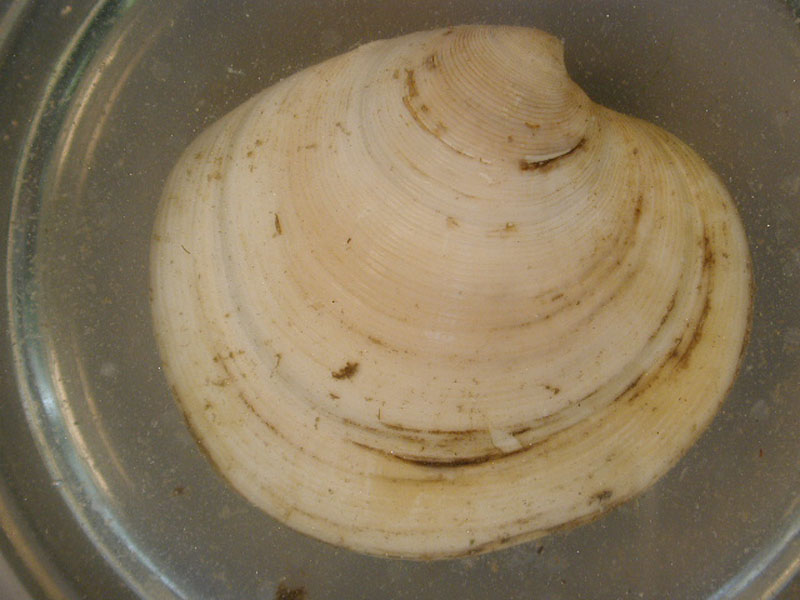
Taxonomy
- Kingdom:Animalia
- Phylum: MOLLUSCA
- SubPhylum:
- Class: Bivalvia
- Order: Veneroida
- Family: Veneridae
- Genus: Dosinia
- Species: discus
Minor Jackknife Clam, Razor Clam
Description
Minor jackknife clams are moderately common in shallow waters, preferring fine, muddy, sand and strong currents. They can burrow very rapidly. The slightly curved shells are fragile and more than 6 times as long as they are high. The outside of the shell is covered with a thin, glossy covering (periostracum) that is green, brown, or purplish in color. The inside of the shell has purple stains. Minor jackknife clams rarely exceed 3 inches in length.
What Are The Effects On Clams?
Minor jackknife clams are sometimes found attached to the outside of clam culture bags. They are filter feeders and, therefore, can compete for the same type of food (micro algae) as clams.
- FOE
- Competitor
What Can A Clam Farmer Do?
Minor jackknife clams are infrequently found and rarely pose a problem.
Morton's Egg Cockle, Yellow Egg Cockle
Description
Morton's egg cockle is a small species ranging from Massachusetts to the Gulf of Mexico. It has a thin but strong shell that appears inflated and glossy, with a cream color and purplish zigzags. The interior may be a bright yellow, and the margins of the two valves are smooth. Cockles are heart-shaped when viewed from either end. It is often found on sandy substrate from intertidal zones to about 20 feet of depth. It has short siphons for breathing and feeding and is found buried rather shallow in the sand.
What Are The Effects On Clams?
Morton’s egg cockles, or yellow egg cockles, are filter feeders and, therefore, can compete for the same type of food (micro algae) as clams.
- FOE
- Competitor
What Can A Clam Farmer Do?
Yellow egg cockles are infrequently found in clam bags and rarely pose a problem.
Florida Lucine
Description
The Florida lucine is commonly found in the Gulf of Mexico, and buries in intertidal sands from shore to about 40 foot depth. It uses a worm-like siphon to form a mucus-lined tube in the sand for incurrent water. The siphon is retracted into the shell similar to the finger of a glove turning inside-out, and is used to keep the incurrent tube free of debris. It has a rounded shape, compressed shell, and is fairly smooth with some irregular growth lines. The periostracum, or shell covering, is a light tan, and is flaky to the touch. Florida lucines grow to about 1 inch in length.
What Are The Effects On Clams?
Florida lucines are filter feeders and, therefore, can compete for the same type of food (micro algae) as clams.
- FOE
- Competitor
What Can A Clam Farmer Do?
Florida lucines are infrequently found in clam bags and rarely pose a problem.
Constricted Macoma
Description
Constricted macoma clams are common just offshore. They are active burrowers in soft sediments. Shells are dingy-white and chalky with growth rings stained by a gray or yellow covering (periostracum). The elongate end of the shell (posterior) is twisted to one side and has a blunt point. Constricted macoma clams grow to 2.5 inches in length.
What Are The Effects On Clams?
Constricted macoma clams are deposit-feeders, consuming sediment and extracting the organic material. They would, therefore, remove and recycle clam fecal material from culture bags. In addition, their active burrowing may help aerate the sediments.
- FRIEND
What Can A Clam Farmer Do?
As non-competing deposit feeders, constricted macoma clams can remain in the culture bags.
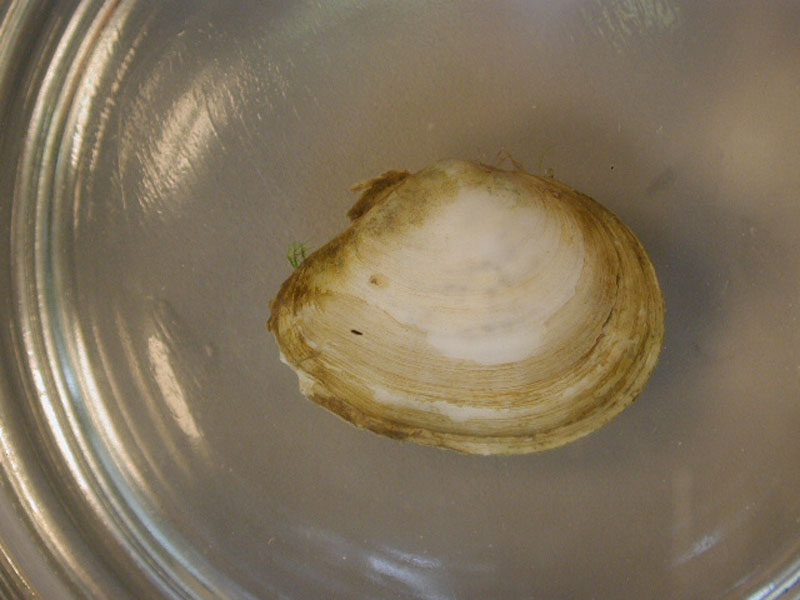
Taxonomy
- Kingdom:Animalia
- Phylum: MOLLUSCA
- SubPhylum:
- Class: Bivalvia
- Order: Veneroida
- Family: Tellinidae
- Genus: Macoma
- Species: constricta
Sunray Venus
Description
The sunray venus is so named due to the glossy brown or lavender color with a sunburst of dark bands radiating from the umbo (oldest part of the shell near the hinge) to the edges of the elongate valves (shells). They can grow to about 5 inches in length, and are found in low energy sandy intertidal zones, from North Carolina to the Gulf of Mexico. There are teeth concentrated near the umbo of the clam. The flesh is a pink color and sunray venus clams are often harvested recreationally for food. They bury themselves in the sand with a strong foot. Grooves in the sand indicate their presence just beneath the surface.
What Are The Effects On Clams?
Sunray venus clams are filter feeders and, therefore, can compete for the same type of food (micro algae) as clams.
- FOE
- Competitor
What Can A Clam Farmer Do?
Sunray venus clams are infrequently found in clam bags and rarely pose a problem. It should be noted that sunray venus clams are being considered as a potential aquaculture species.
Fragile Surf Clam
Description
Fragile surf clams live in intertidal and high subtidal sandy areas. They have smooth, off-white to yellowish shells with a silky shell covering (periostracum). The shells are an elongate oval and, when closed, there is a wide gape at one end for the foot to emerge from. The hinge is centrally located. Fragile surf clams can grow up to 2.5 inches.
What Are The Effects On Clams?
Fragile surf clams are filter feeders and, therefore, can compete for the same type of food (micro algae) as clams.
- FOE
- Competitor
What Can A Clam Farmer Do?
Fragile surf clams are infrequently found in clam bags and rarely pose a problem.
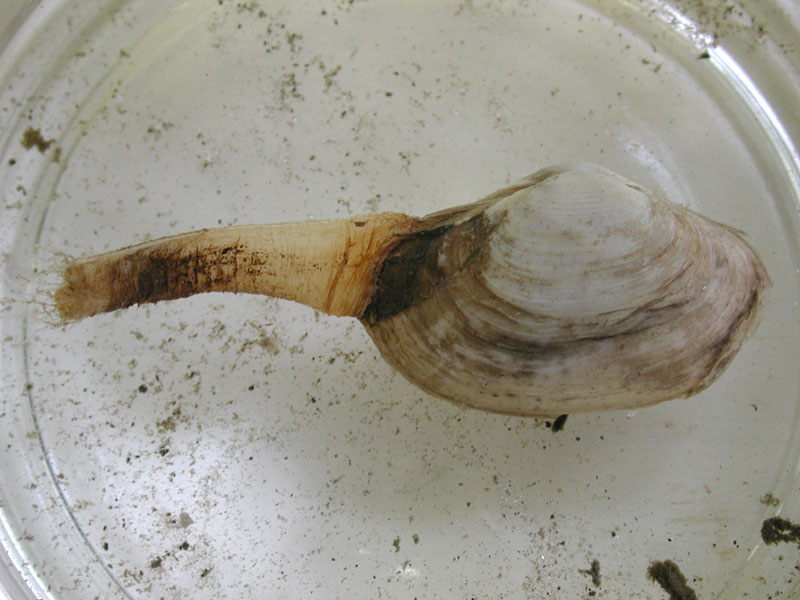
Taxonomy
- Kingdom:Animalia
- Phylum: MOLLUSCA
- SubPhylum:
- Class: Bivalvia
- Order: Veneroida
- Family: Mactridae
- Genus: Mactrotoma
- Species: fragilis
Northern Quahog, $$
Description
The hard clam occurs often in sand or mud, between high- and low-tide lines in shallow coastal waters. This clam is cosmopolitan in distribution, ranging from the Gulf of St. Lawrence in Canada to Florida and Texas, and supports important fisheries and aquaculture industries within its range. The broadly oval, moderately inflated clam has a thick-shelled, solid appearance with equal valves, or shells, and a heart-shaped appearance when viewed with the hinge up. The color is a dull grayish yellow, but can be brownish or black when freshly pulled from the bottom. A subspecies, know as notata, is characterized by reddish or chestnut-colored, chevron-shaped markings on the shell exterior. Many aquacultured clams feature these striated markings. The surface of the shells has many closely-set, erect concentric rings; stronger near the umbo (oldest part of the shell near the hinge) and smoother in the center. Internally the shell is white, sometimes with deep purple at the siphon end. The hard clam can reach up to 5 inches long and over 3 inches in width. The accepted common name is the northern quahog, but it is locally known as hard clam. The name "quahog" (pronounced co-hog) is derived from two Native American words meaning "closed" and "shell." Indians used the purple shell lining to make wampum beads, which were a trading currency in the colonial period. The genus and species names mercenaria (meaning "money" in Latin) refer to their former value. In addition to the regional names for this mollusk, there are different names for hard clams of different sizes. Littlenecks, a reference to the size of the siphons or “necks,” are the most valued aquaculture product size (approximately 1” across the hinge, or width).
What Are The Effects On Clams?
This is the species that clam farmers are growing on their leases and should be found at commercial densities inside the bottom bag.
What Can A Clam Farmer Do?
A clam farmer should first locate his or her growout site (shellfish aquaculture lease) in a suitable area that supports good growth and survival of this species, for example, relatively high salinities and a sand-mud mixture of bottom sediments. Next a clam farmer must not only invest money (“it takes money to make money”), but also his or her management time and skills for the business to be successful (Oesterling, 1995). A clam farmer should also have a basic understanding of the types and abundance of predator and fouling organisms found around the lease area. This information can assist a clam farmer in determining what predator exclusion techniques or planting strategies must be incorporated into the farming methods. Finally, record keeping is an important management tool which allows a clam farmer to evaluate the farm operation and to understand trends and patterns in clam production.
Southern Quahog
Description
Southern quahogs live in sandy bottoms from intertidal flats to 120 feet in depth. The southern quahog resembles the hard clam or northern quahog, M. mercenaria, which is the commercially aquacultured clam. However, the southern quahog seldom has interior purple coloring, and its shells become heavier and more inflated than the northern species. The southern species is best distinguished by persistent growth ridges completely around the shell. An important physiological difference is the shelf life. It is found in the more southern regions of the range of hard clams and the two species are reported to form hybrids. The southern quahog grows larger than the hard clam and can reach 3 to 6 inches in length.
What Are The Effects On Clams?
Southern quahogs are filter feeders and, therefore, can compete for the same type of food (micro algae) as clams.
- FOE
- Competitor
What Can A Clam Farmer Do?
When smaller than normal clams appear in culture bags, they may be southern quahogs or hybrids of southern and northern quahogs. These clams, especially the pure southern quahogs, will have a poor shelf life, as they gape in refrigerated storage, and are not favorable for marketing.
Dwarf Surf Clam, Nut Clam
Description
The dwarf surf clam is the smallest of the surf clams, ranging from Maine to Texas. It is found most often in very calm, fine silty sands or mud, often in estuaries. The valves, or shells, are somewhat triangular, slightly inflated and are rather strong, usually colored white. The umbo, or “beak” of the shell, has a triangular pit in which a ligament is housed that helps keep the valves slightly agape while relaxed. The back slope of each valve has a posterior ridge, and the valves possess a yellow, fibrous periostracum, or shell covering. It grows only to a length of about 5/8 inches.
What Are The Effects On Clams?
Dwarf surf clams are filter feeders and, therefore, can compete for the same type of food (micro algae) as clams.
- FOE
- Competitor
What Can A Clam Farmer Do?
Dwarf surf clams are infrequently found in clam bags and rarely pose a problem.
Ponderous Ark
Description
Ponderous arks are common and live in soft and shelly subtidal habitats in shallow water. The strongly inflated shells have raised square ribs which are slit down the middle with a fine line. The shells have a thick, black, felt-like shell covering (periostracum) which may be worn off near the hinge. Ponderous arks grow up to 2.5 inches in length.
What Are The Effects On Clams?
Ponderous arks are filter feeders and, therefore, can compete for the same type of food (micro algae) as clams. Ponderous arks may recruit into clam culture bags before the bag is buried, since the bags provide optimal habitat. Their “beard” or byssal threads may ball up and trap small clam seed.
- FOE
- Competitor
What Can A Clam Farmer Do?
Ponderous arks are infrequently found in clam bags and rarely pose a problem. It should be noted that ponderous arks are being considered as a potential aquaculture species.
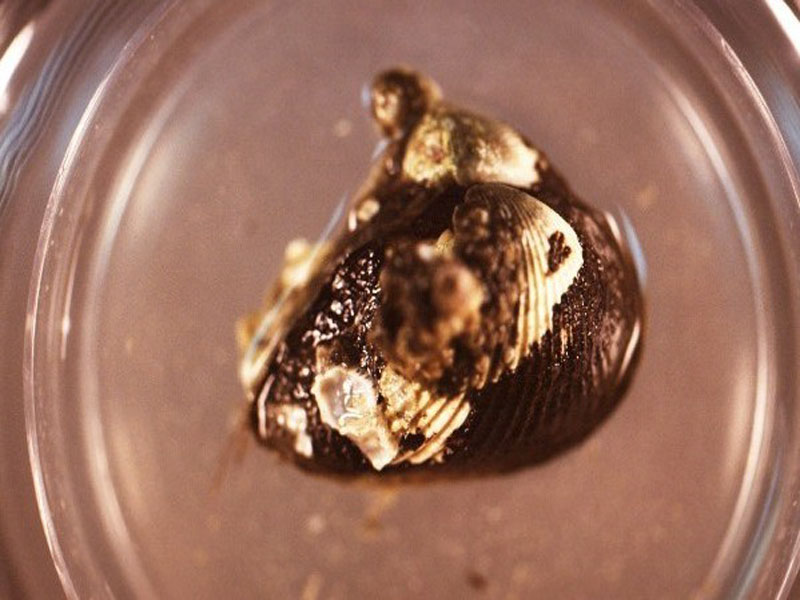
Taxonomy
- Kingdom:Animalia
- Phylum: MOLLUSCA
- SubPhylum:
- Class: Bivalvia
- Order: Arcoida
- Family: Noetiidae
- Genus: Noetia
- Species: ponderosa
Crested Oyster, Horse Oyster
Description
Like eastern oysters, crested or horse oysters cement themselves to subtidal hard substrates. However, they do not form reefs as do the eastern oysters. Crested oysters live in water that is saltier than that in which eastern oysters live. Shells are circular to oval with wavy (crenulated) margins. The shell attached to the substrate is flat inside, but highly cupped. One way to distinguish crested oysters from eastern oysters is by the row of tiny teeth (denticles) on the inside edge of the upper shell, especially near the hinge. These teeth or more easily felt with a fingertip or knife, than seen with the eye. Adults reach 1 to 2 inches in length.
What Are The Effects On Clams?
Oysters can have a two-fold effect on clams. As a filter or suspension feeder, oysters can compete for the same type of food (micro algae) as clams. They can also attach to clam bags and cover netting and to the clam shells themselves. This can result in mechanical interference and prevent the clam from opening, feeding or burying. Fouling on the shell can make them less desirable for marketing. The crested oyster is smaller than the eastern oyster, does not form reefs and prefers higher salinities.
- FOE
- Competitor
- Fouler
What Can A Clam Farmer Do?
To minimize fouling on the clams and bags, a clam farmer could add cover netting during periods of peak sets and remove afterwards, basically harvesting the oysters. Note that plastic or rigid cover netting can also “attract” oyster spat and may become the problem. Dipped bags which stiffen the mesh can also provide suitable substrate for oysters. Clam bags fouled with oysters should be removed from the lease as soon as possible. Gloves are necessary when handling bags covered with oysters as they are very sharp and can cause serious injuries. The crested oyster is less frequently found in and on clam bags than the eastern oyster, and does not pose as great a problem.
Asian Green Mussel
Description
This green mussel is native to the Indo-Pacific and is assumed to have arrived in the U.S. as larvae in ship’s ballast tanks. They were discovered in Tampa Bay in 1999 and have since become established. Like other mussels, green mussels attach to firm substrates by a “beard,” or byssal threads. They seem to prefer attaching to man-made structures. Their dense growth has been correlated with oyster mortality on oyster bars, and they appear to outcompete native bivalves for space on structures. They can tolerate salinity and turbidity extremes well and are efficient filter feeders. Green mussels have bright green to blue-green shells that develop brown markings in adulthood.
What Are The Effects On Clams?
Green mussels are an invasive species and are established in Tampa Bay. They recruit in dense numbers on hard substrate and prefer artificial structures. They will also attach to other shellfish and have been correlated with high oyster mortalities. If green mussels spread north from Tampa Bay to the Suwannee Sound, clam growers could expect extensive fouling of clam culture bags by green mussels, potentially suffocating the clams, as well as competing with them for food.
- FOE
- Competitor
- Fouler
What Can A Clam Farmer Do?
If a suspected green mussel is sighted, growers should report to the Nonindigenous Aquatic Species Program at 877-STOP-ANS or on the Internet at http://nas.er.usgs.gov. If possible, save samples of the shells.
Purplish Semele
Description
Purplish semele clams live in shallow subtidal waters. The thin shells are lopsided oval in shape and are thin and smooth except for very fine growth rings overlaid by very fine grooves. The color is variable but they are usually gray or cream with purple or orange mottling. The inside of the shell is glossy purple, orange, or brown. Purplish semele clams reach 1 inch in length.
What Are The Effects On Clams?
Purplish semele clams are found infrequently in culture bags. They are deposit-feeders, consuming sediment and extracting the organic material. They would, therefore, remove and recycle clam fecal material from culture bags.
- FRIEND
What Can A Clam Farmer Do?
As non-competing deposit feeders, purplish semele clams can remain in the culture bags.
Atlantic Surf Clam
Description
Atlantic surf clams live in unstable shifting sand in tidal channels or beaches in the high subtidal to low intertidal. The shells are smooth and triangular with the hinge centrally located. The shell is white with a thin, glossy, yellowish shell covering (periostracum). Atlantic surf clams may exceed 8 inches in length but are usually less than 4 inches.
What Are The Effects On Clams?
Atlantic surf clams are filter feeders and, therefore, can compete for the same type of food (micro algae) as clams.
- FOE
- Competitor
What Can A Clam Farmer Do?
Atlantic surf clams are infrequently found in clam bags and rarely pose a problem.
Purplish Tagelus
Description
Purplish tagelus clams are common intertidal to shallow water species. They inhabit permanent burrows in mud or muddy sand that are often “J”-shaped. The elongate shells are smooth and fragile. Shell color is whitish purple and the shells are covered by a thin, glossy chestnut brown covering (periostracum). Purplish tagelus clams reach 1.5 inches in length.
What Are The Effects On Clams?
Purplish tagelus clams are filter feeders and, therefore, can compete for the same type of food (micro algae) as clams. On the other ‘shell’, their burrows may help aerate the sediments.
- FRIEND, FOE
- Competitor
What Can A Clam Farmer Do?
Purplish tagelus clams occur infrequently in clam bags and rarely pose a problem.
Florida or Yellow Prickly Cockle
Description
Florida or yellow prickly cockles live in sand in shallow to intertidal waters. When viewed end on, they have a slender heart-shaped profile. When viewed from the side, the shells are nearly circular, with rough scaly ribs. The outside shell color is often yellowish with brown mottling, while the inside of the shells are yellow. Yellow prickly cockles grow to 2.5 inches in size.
What Are The Effects On Clams?
Florida or yellow prickly cockles are filter feeders and, therefore, can compete for the same type of food (micro algae) as clams.
- FOE
- Competitor
What Can A Clam Farmer Do?
Yellow prickly cockles are infrequently found in clam bags and rarely pose a problem.
Blue Crab
Description
The blue crab is the largest and most important, economically, of the swimming crabs. Found widespread among Southeastern, Atlantic, and Gulf of Mexico coasts, the blue crab supports large commercial fisheries. These crabs are characterized by wide carapaces with sharp spines on either side, and the last pair of legs has been modified into swimming paddles. Their carapace can reach 9 inches in width and 4 inches in length, and is a blue-grey color, with granulations on the top. There are eight teeth on either side of the carapace between the spine and the eyes, and there are two teeth between the eyes on the carapace. Females are differentiated from males by having red tips on their claws. Blue crabs will feed on anything ranging from other crabs and shrimp to decaying flesh, and are some of the more aggressive of the crabs, raising their claws in defense when approached.
What Are The Effects On Clams?
Blue crabs prey heavily on almost all sizes of clams. Blue crabs are voracious consumers of hard clam seed with rates of clam consumption greater than those reported for any other bivalve species (Krauter and Castagna, eds., 2001). Clam size is the most important factor in the rate of crab predation. Only very large blue crabs can consume clams greater than pasta-size (about 30-35 mm shell length). Considered a scavenger, the blue crab typically opens a clam with their claws by crushing the entire clam, chipping a valve (shell) edge, or forcing the valves apart. Evidence of blue crab predation includes chipped edges or crushed shells, as well as torn or ripped clam bags.
- FOE
- Predator
What Can A Clam Farmer Do?
Predator control for blue crabs includes the clam bag and, if needed, additional protective covering, such as chicken wire or plastic netting. Blue crabs can be removed from the aquaculture lease area by using crab traps. Clam farmers can apply for a depredation endorsement with their Saltwater Products License that allows them to possess up to 75 blue crab traps for the incidental take of destructive or nuisance crabs within 1 mile of their aquaculture lease. Sale of blue crabs taken with a depredation endorsement is prohibited. Visit the website of the Florida Fish and Wildlife Conservation Commission <HYPERLINK TO www.floridaconservation.org> for more information. Caution should be taken when handling blue crabs as their pincher claws are powerful and can inflict a serious cut.
Thinstripe Hermit Crab
Description
The thinstripe hermit crab is one of the largest of the common hermit crabs found from Virginia to Caribbean shores. It is often found on mud flats or rock jetties in a variety of snail shells, and can reach a length of 3 inches. It is very distinct in that the walking legs are lined with four white stripes down the length of each leg. The crab is otherwise a greenish to dark brown color, with orange antennae. The claws are equal sized, and its fingers are spooned. Adults can often be found in tulip snail or pear whelk shells, though they are not immune to the stings of snail fur, and thus will not be seen in shells harboring these hydroids. These crabs feed on scavenged material, detritus, or macro algae.
What Are The Effects On Clams?
Thinstripe hermit crabs are herbivores and consume macro algae, in particular sea lettuce. They can assist in reducing fouling organisms found on the bag
- FRIEND
What Can A Clam Farmer Do?
No action needs to be taken by a clam farmer.
Say's Mud Crab
Description
The Say's mud crab is a smaller, yet still common, mud crab of the Atlantic and Gulf coasts. Reaching just over 1 inch long, this mud crab is found along mud and oyster shell bottoms, but can also be found among seagrasses. The claws are of unequal size, and the fingers are dark brown or black, bearing a slight curve at the tips. The claws do not have large teeth at the base of the fingers as do many other mud crabs. The front sides of the shell have 4 teeth, though the front-most tooth is obscured just behind the eyes, and there is a distinct indentation in the middle of the carapace between the eyes. They feed on acorn barnacles, juvenile clams of the genus Mercenaria, and other invertebrates in their environment.
What Are The Effects On Clams?
Mud crabs are predators of cultured clams and the most common crab species found in the clam lease environment. These crabs attack clams by patiently chipping away at the shell margin with a large tooth-like structure on their larger claw. Predatory activity is limited by clam size. Mud crabs select smaller clam seed with only the very large mud crabs capable of consuming clams up to 20 mm in shell length (Krauter and Castagna, eds., 2001). On the other ‘claw’, mud crabs also eat very small fouling organisms. In doing so, they assist in keeping the surface of a clam bag clean.
- FRIEND, FOE
- Predator
What Can A Clam Farmer Do?
Predator control for mud crabs includes the clam bag and if needed, additional predator covering, such as chicken wire or plastic netting. Dipping of nursery bags with a net coating, which stiffens the mesh, may also minimize predation of clam seed by mud crabs.
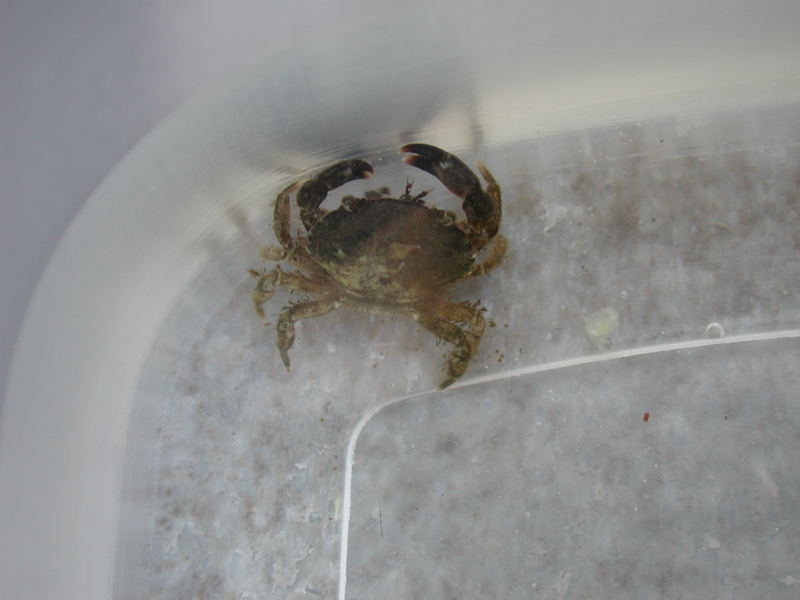
Taxonomy
- Kingdom:Animalia
- Phylum: ARTHROPODA
- SubPhylum: Crustacea
- Class: Malacostraca
- Order: Decapoda
- Family: Panopeidae
- Genus: Dyspanopeus
- Species: sayi
Flatback Mud Crab
Description
The flatback mud crab is found on mud bottoms in bays and brackish estuaries often occurring with oysters. It preys on newly settled oysters, but is not considered a serious pest by oystermen. The fan-shaped crab is grayish-olive to olive-brown, lighter underneath, the fingers of the pincers dark brown. The carapace is rounded in front, with the sides slanting in toward the rear border. Pincers appear stout and unequal, the larger pincer with the fingers almost straight, the tips of which appear hollowed out or "spoon-shaped". This small mud crab is ½ inch long and ¾ inch wide.
What Are The Effects On Clams?
Mud crabs are predators of cultured clams and the most common crab species found in the clam lease environment. These crabs attack clams by patiently chipping away at the shell margin with a large tooth-like structure on their larger claw. Predatory activity is limited by clam size. Mud crabs select smaller clam seed with only the very large mud crabs capable of consuming clams up to 20 mm in shell length (Krauter and Castagna, eds., 2001). On the other ‘claw’, mud crabs also eat very small fouling organisms. In doing so, they assist in keeping the surface of a clam bag clean.
- FRIEND, FOE
- Predator
What Can A Clam Farmer Do?
Predator control for mud crabs includes the clam bag and if needed, additional predator covering, such as chicken wire or plastic netting. Dipping of nursery bags with a net coating, which stiffens the mesh, may also minimize predation of clam seed by mud crabs.
Calico Box Crab, Rooster Crab, Shame-Faced Crab
Description
The calico box crab occupies sand bottoms in bays and the open ocean from below the low-tide line to water 150 feet deep. This crab is very active, has a greater gill area, and hence greater capacity to take in oxygen than most crabs. It is fan-shaped with a broadly rounded carapace, which is yellowish, grayish, or brownish in color with many large, round or irregular, light red spots and dark borders. The pincers are strong and equal and with a row of coarse, low, round projections on the outer surface of the hand. The calico box crab can obtain a carapace width of 2 ½ inches and a length of 1 ¾ inches.
What Are The Effects On Clams?
Calico crabs could be a potential predator on clams, but are infrequently observed on clam aquaculture leases.
- FOE
- Predator
What Can A Clam Farmer Do?
Clam bags and cover netting should be adequate protection against potential rooster crab predation.
Smooth Mud Crab
Description
The smooth mud crab occurs commonly on both shelly and soft sandy bottoms. This small crab is dark reddish brown to dark gray in color, often with a light yellow band along the front edge of the carapace. The pincers are unequal with the upper finger of the larger pincer having a large tooth at the base. The smooth mud crab can reach a length of almost 1 inch.
What Are The Effects On Clams?
Mud crabs are predators of cultured clams and the most common crab species found in the clam lease environment. These crabs attack clams by patiently chipping away at the shell margin with a large tooth-like structure on their larger claw. Predatory activity is limited by clam size. Mud crabs select smaller clam seed with only the very large mud crabs capable of consuming clams up to 20 mm in shell length (Krauter and Castagna, eds., 2001). On the other ‘claw’, mud crabs also eat very small fouling organisms. In doing so, they assist in keeping the surface of a clam bag clean.
- FRIEND, FOE
- Predator
What Can A Clam Farmer Do?
Predator control for mud crabs includes the clam bag and if needed, additional predator covering, such as chicken wire or plastic netting. Dipping of nursery bags with a net coating, which stiffens the mesh, may also minimize predation of clam seed by mud crabs.
Snail Fur
Description
Snail fur is a pink to white mat-like growth on the gastropod (snail) shells occupied by hermit crabs. Within the mat, there are three types of polyps: 1) a club-like feeding polyp that grows up to ½ inch in length, with upper and lower circles of eight tentacles, the lower set being shorter than the upper; 2) male and female reproductive polyps that have a few short terminal tentacles; and, 3) specialized defensive stinging polyps that are long coils and look thread-like. This is an example of mutualism – the hermit crab receives protection from the hydroid's nematocysts (stinging cells), while the hermit crab carries the hydroid to plankton-inhabited areas.
What Are The Effects On Clams?
Snail fur is only found attached to the shell of hermit crabs. They are filter feeders and can compete for the same food source (micro algae) as clams.
- FOE
- Competitor
What Can A Clam Farmer Do?
Snail fur is infrequently found in clam bags and rarely poses a problem.
Longnose Spider Crab
Description
The longnose spider crab is a sluggish crab commonly found in the southeastern U.S. on most bottom substrates, though preferring quiet waters. It has a rounded carapace, and a forked rostrum projecting from between the eyes. Adults have 6 prominent spines along the length of the back, but the brown carapace is otherwise covered in small spines. Immature individuals can often be found overgrown with algae, sponges, hydroids and tunicates on the shell, while adults are usually clear of fouling. Juveniles have been known to ride on cannonball jellyfish and moon jellyfish, apparently feeding upon the cnidarians. It can reach almost 4 inches in length.
What Are The Effects On Clams?
There does not appear to be any reports linking spider crabs to predation on hard clams, but it is possible these crabs could prey on small clam seed. On the other ‘claw’, spider crabs typically eat very small fouling organisms. In doing so, they assist in keeping the surface of a clam bag clean.
- FRIEND, FOE
- Predator
What Can A Clam Farmer Do?
As with other crabs, predator control includes the clam bag and, if needed, additional protective covering, such as chicken wire or plastic netting.
Horseshoe Crab
Description
The horseshoe crab is common on mud or sand bottoms from near low-tide line to water 75 feet deep. This animal is the only one of its kind in American waters, and cannot be confused with anything else. It feeds on small clams, worms, and other invertebrates which it grinds with the burr-like bases of the walking legs that surround its mouth. This large crab has a greenish-tan, horseshoe-shaped carapace with triangular abdomen and spike-like tail. A pair of compound eyes is located on each side of the carapace and two simple eyes are present on the forepart of the midline. The sides of the abdomen are scalloped with six spines. The mouth is surrounded by 5 pairs of walking legs; the first pair on males is rounded and heavy, while the others have pincher tips. The underside of the abdomen has six pairs of overlapping flaps, the first covering an opening of six ducts, the others covering five pairs of book gills comprised of many flat sheets. The horseshoe crab can obtain a length of 2 feet and a width of 1 foot. Males are about one-third the size of females.
What Are The Effects On Clams?
Horseshoe crabs are capable of eating very small clam seed. Large adult horseshoe crabs may uncover clam bags as they search and feed on worms found on the lease bottom. Their feeding behavior could expose clam bags to other predators.
- FOE
- Predator
What Can A Clam Farmer Do?
Typically the nursery clam bag provides adequate protection from horseshoe crab predation. Adequate cover netting should minimize the risk of exposed clam bags becoming vulnerable to other predators.
Florida Stone Crab
Description
The Florida stone crab is another commercially important species of crab. They range from North Carolina to the West Indies, and can reach a length of 5 inches across the carapace. One of the largest members of the mud crab family, stone crabs have large, thick claws and a smooth, heavy carapace. The colors of the crab change from glossy purple to speckled grey to tan as they mature, yet always maintain dark colored fingers. The front sides of the carapace have four flattened teeth, and the claws are of unequal sizes, one as crushers and one for pincers. Adults burrow in the mud flats underneath rocks, corals, and oysters. They feed upon acorn barnacles, oysters and a variety of other invertebrates.
What Are The Effects On Clams?
The stone crab is capable of consuming large clams and is a serious predator in certain growing areas. Evidence of stone crab predation includes crushed shells, usually larger shell fragments than found with blue crab predation, as well as torn or ripped clam bags.
- FOE
- Predator
What Can A Clam Farmer Do?
Predator control for stone crabs includes the clam bag and, if needed, additional protective covering, such as chicken wire or plastic netting. Stone crabs can be removed from the aquaculture lease area by using crab traps. Clam farmers can apply for a depredation endorsement with their Saltwater Products License that allows them to possess up to 75 stone crab traps for the incidental take of destructive or nuisance crabs within 1 mile of their aquaculture lease. Sale of stone crabs taken with a depredation endorsement is prohibited. Visit the website of the Florida Fish and Wildlife Conservation Commission <HYPERLINK TO www.floridaconservation.org> for more information. While they appear much more sluggish than blue crabs, and are readily handled, it should still be noted that their claws can easily crush a finger.
Longwrist Hermit Crab
Description
The long wrist hermit crab is one of the most common decapod (10-legged) crabs found along the soft-bottomed shallows from Massachusetts to the Gulf of Mexico. It reaches about 1 inch in length, and is found in a variety of empty snail shells. The right claw is much longer than the left claw, being nearly cylindrical, smooth and hairless. The fingers of the left claw are spooned, and the right claw has a long stripe on each side. Walking legs are iridescent, and the carapace is a light green color. They have been found to subsist on a diet of diatoms (micro algae), detritus and macro algae, along with scavenged material.
What Are The Effects On Clams?
These hermit crabs are opportunistic feeders, meaning they consume any available organic material. They may consume unburied stressed clams, but not buried healthy clams.
- FOE
- Predator
What Can A Clam Farmer Do?
Clams in buried bottom bags are protected from possible hermit crab predation.
Flatclaw Hermit Crab
Description
The flatclaw hermit crab is a larger species of hermit crab, reaching up to 1 ¼ inches in length, and ranges from Massachusetts to the Gulf of Mexico, living in intertidal zones similar to the long wrist hermit crab. As the name implies, both claws are large and flat, with the right claw larger than the left. The large claw has serrations around the edge, and is usually a white or cream color. They feed upon detritus, macro algae and scavenged material, and when disturbed will retreat into their shell using the large flat claw as a door. Larger individuals are often found in moon snail and lightning whelk shells, and they sometimes adorn their shells with the tricolor anemone, which serves as a protective symbiont (two species that have long-term interdependence between them).
What Are The Effects On Clams?
These hermit crabs are opportunistic feeders, meaning they consume any available organic material. They may consume unburied stressed clams, but not buried healthy clams.
- FOE
- Predator
What Can A Clam Farmer Do?
Clams in buried bottom bags are protected from possible hermit crab predation.
Atlantic Mud Crab
Description
Behind the stone crab, the common mud crab is the largest of the mud crabs, reaching 2.5 inches in length. Common along mud flats, oyster reefs, and mangrove roots from Massachusetts to South America, this mud crab has 5 spines along the front sides of the carapace, and an indentation between the eyes. Claws are large and heavy, the right one being larger than the left. The fingers are often a black color, and the dark color of the bottom finger usually extends a little onto the palm. The larger claw also has a distinct, white tooth at the base of the top, moveable finger. These mud crabs are known to feed on oysters as well as acorn barnacles, juvenile clams of the genus Mercenaria, and other invertebrates in their environment.
What Are The Effects On Clams?
Mud crabs are predators of cultured clams and the most common crab species found in the clam lease environment. These crabs attack clams by patiently chipping away at the shell margin with a large tooth-like structure on their larger claw. Predatory activity is limited by clam size. Mud crabs select smaller clam seed with only the very large mud crabs capable of consuming clams up to 20 mm in shell length (Krauter and Castagna, eds., 2001). On the other ‘claw’, mud crabs also eat very small fouling organisms. In doing so, they assist in keeping the surface of a clam bag clean.
- FRIEND, FOE
- Predator
What Can A Clam Farmer Do?
Predator control for mud crabs includes the clam bag and if needed, additional predator covering, such as chicken wire or plastic netting. Dipping of nursery bags with a net coating, which stiffens the mesh, may also minimize predation of clam seed by mud crabs.
Green Porcelain Crab
Description
The green porcelain crab is a small crab, distributed throughout the Gulf of Mexico and the Caribbean shores, found often along rocky rubble, oyster bars and other intertidal hard substrates. It reaches a maximum size of about 1 inch in carapace width. Both claws are of equal size and, despite their relatively large size, do not offer a hard pinch. The green porcelain crab is often brownish to green in coloration, and has bead-like projections all over the carapace and claws. On each claw, there are three spines on the inside edge of the wrists that help differentiate it from another common porcelain crab.
What Are The Effects On Clams?
Green crabs are filter feeders and can consume similar phytoplankton (micro algae) species as hard clams.
- FOE
- Competitor
What Can A Clam Farmer Do?
Green porcelain crabs are infrequently found in clam bags and rarely pose a problem.
Spineback Hairy Crab
Description
The spineback hairy crab is found in a variety of habitats, including shelly bottoms, pilings, wrecks, reefs, rocks, and mangrove swamps. This small oval crab appears grayish to reddish-brown. All but the rear third of its carapace is covered with yellow hairs, including the surfaces of its walking legs. Its robust, unequal claws are black-fingered and also covered with hairs and sharp black spines, which often occur in rows. The spineback hairy crab can reach a carapace length of 1 inch and a width of 1½ inches.
What Are The Effects On Clams?
This crab can attack clams by patiently chipping away at the shell margin with a large tooth-like structure on its larger claw. However, predatory activity is limited by clam size with smaller clam seed generally selected. On the other ‘claw,’ this crab also eats very small fouling organisms. In doing so, it assists in keeping the surface of a clam bag clean.
- FOE
- Predator
What Can A Clam Farmer Do?
Predator control for crabs includes the clam bag and if needed, additional predator covering, such as chicken wire or plastic netting. Dipping of nursery bags with a net coating, which stiffens the mesh, may also minimize predation of clam seed by this crab.
Iridescent Swimming Crab
Description
The iridescent swimming crab is common in shallow shelf waters and lower reaches of bays and inshore waters, mostly found on sandy or muddy bottoms. This swimming crab has a brownish-red to tan carapace with small, iridescent patches on the edge. The front sides of the legs look iridescent purple-red in the light. Its carmine-red pincers are twice the body length, strong and sharp with the last pair of walking legs being paddle-shaped.
What Are The Effects On Clams?
These swimming crabs are often mistaken for juvenile blue crabs. Like blue crabs, swimming crabs can prey heavily on small clams. Since they do not get as large as blue crabs, they generally do not affect larger clam sizes. Considered a scavenger, the swimming crab typically opens a clam with its claws by crushing the entire clam, chipping a valve edge, or forcing the valves apart. Evidence of crab predation includes chipped edges or crushed shells, as well as torn or ripped clam bags.
- FOE
- Predator
What Can A Clam Farmer Do?
Predator control for swimming crabs includes the clam bag and, if needed, additional protective covering, such as chicken wire or plastic bird netting.
Southern Sting Ray
Description
The Southern stingray is common in bays and estuaries of the Gulf of Mexico. Stingrays are bottom animals and typically bury themselves with only the eyes showing. They have a long whip-like tail with a strong serrated spine and venomous tissue near the base. The snout is somewhat pointed and the mouth is ventral, with teeth modified as crushing plates. The body is grey to dark brown. Adults can grow to 3 feet wide.
What Are The Effects On Clams?
Southern stingrays primarily prey on worms but, in doing so, may disturb and expose bags, leaving them vulnerable to predation. Alternatively, their activities may cover nursery bags with excessive sediments, resulting in suffocation of the seed clams.
- FOE
What Can A Clam Farmer Do?
Southern stingrays are not aggressive and are only dangerous if stepped on. The spine can inflict a painful wound that may become infected. Therefore, it is recommended that, before entering the water, growers disturb the bottom with a pole and, once in the water, shuffle their feet to avoid stepping on a stingray. If stung, the grower should flush the wound with seawater, apply heat with an instant heat pack to kill the toxin, and immediately seek medical attention.
Gulf Toad Fish
Description
The gulf toadfish is common in seagrass beds and rocky areas of shallow bays. Small individuals may enter cans, jars, or clam culture bags and become trapped as they grow. Toadfish have large, flattened heads. The tail fin is rounded and the pectoral fins are large and fan-like. Eggs, which are attached to the surface of rock cavities or inside debris, are guarded by the male. Adults may reach 15 inches in length.
What Are The Effects On Clams?
Toadfishes do not eat shellfish but, rather, may feed on predators of shellfish, including crustaceans (crabs) and other fish.
- FRIEND
What Can A Clam Farmer Do?
Shellfish growers in the Northeast have experimented with placing toadfish inside bottom screens, nets, and raceways to reduce crab predation. Toadfishes are belligerent, however, and may bite.
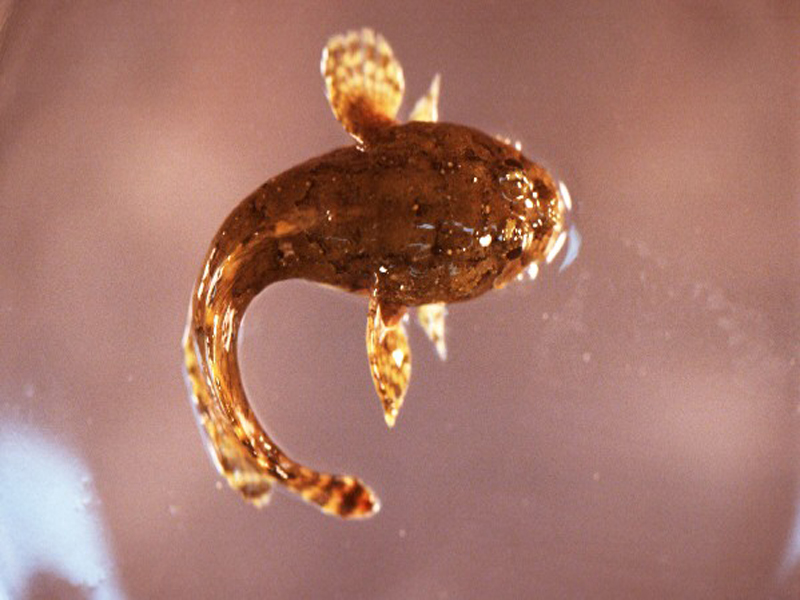
Taxonomy
- Kingdom:Animalia
- Phylum: CHORDATA
- SubPhylum: Vertebrata
- Class: Osteichthyes
- Order: Batrachoidiformes
- Family: Batrachoididae
- Genus: Opsanus
- Species: beta
Black Drum
Description
Black drum are bottom-dwelling fishes found over sand and mud in bays and estuaries, often around oyster beds. They are chunky in size with a high arched back and 10 to 14 pairs of chin barbells or whiskers under their lower jaw. Younger fish have four or five dark vertical bars on their sides but these disappear with age. Adults are slivery to dark gray in coloration, but that can vary greatly. Adults may reach over 100 pounds and 65 inches in length and live to 35 years or more. Black drum form large schools.
What Are The Effects On Clams?
Black drum are primarily carnivores and will consume worms, shrimp, crabs, small fish and mollusks. Barbells, or whiskers, are used to find food by feel and smell. Drum dig and root out mollusks and worms while feeding in a head-down position. This process is called “tailing.” Black drum have been considered one of the most serious threats to the oyster fishery in Louisiana and other Gulf coast states. Schools are often sighted around clam leases on the west coast of Florida. Nursery bags are typically not targeted, however larger seed in growout bags are vulnerable when they are recently planted and have not yet buried into the bottom sediments. Black drum can draw the bag mesh into their mouths, crush the clam shells with pharyngeal (in the throat) teeth, and suck out the meats through the mesh openings. Evidence of predation by black drum includes abrasion of the bag fabric, but typically no holes are found.
- FOE
- Predator
What Can A Clam Farmer Do?
Cover netting may be necessary to reduce black drum predation. Net coatings that stiffen the bag mesh may help prevent the fish from drawing the fabric into their mouths. Specific guidelines for use of net coatings can be found in the Florida Department of Agriculture and Consumer Services, Division of Aquaculture, Technical Bulletin Number 4, 2005. <HYPERLINK TO http://www.floridaaquaculture.com/technicalbulletins.htm> When large schools of black drum are seen on the lease area, typically in spring and summer, growers may want to delay transfer of seed from nursery to growout bags.
Cownose Ray
Description
Cownose rays are cartilaginous fishes found inshore along the Gulf of Mexico during the summer, with schools migrating to the Yucatan Peninsula in the fall. Cownose rays “fly” through the water by flapping their long pointed pectoral fins. They have a pointed tail with a spine at the base. The snout is square with an indentation in the center, resembling a cow’s muzzle. The body is brown to olive, with no spots or markings. The mouth is ventral, with teeth modified as crushing plates. Adults can grow to 7 feet from wingtip to wingtip.
What Are The Effects On Clams?
Cownose rays are voracious predators of bivalve mollusks, including hard clams, which they crush with their dental plates. Food is located by mechanical or electro-receptive detection. To uncover their prey, rays use stirring motions of the fins and blow water to liquefy the sediment. Cownose rays will crush clams right through the mesh of culture bags, consuming the clam meat, and damaging the bag. Large schools can cause extensive damage. Evidence of predation by cownose rays includes butterfly-shaped or paired holes in the clam bag mesh.
- FOE
- Predator
What Can A Clam Farmer Do?
The use of net coatings that stiffen the bag mesh may prevent rays from grasping the firmer material in their mouths. Specific guidelines for use of net coatings can be found in the Florida Department of Agriculture and Consumer Services, Division of Aquaculture, Technical Bulletin Number 4, 2005. <HYPERLINK TO http://www.floridaaquaculture.com/technicalbulletins.htm>
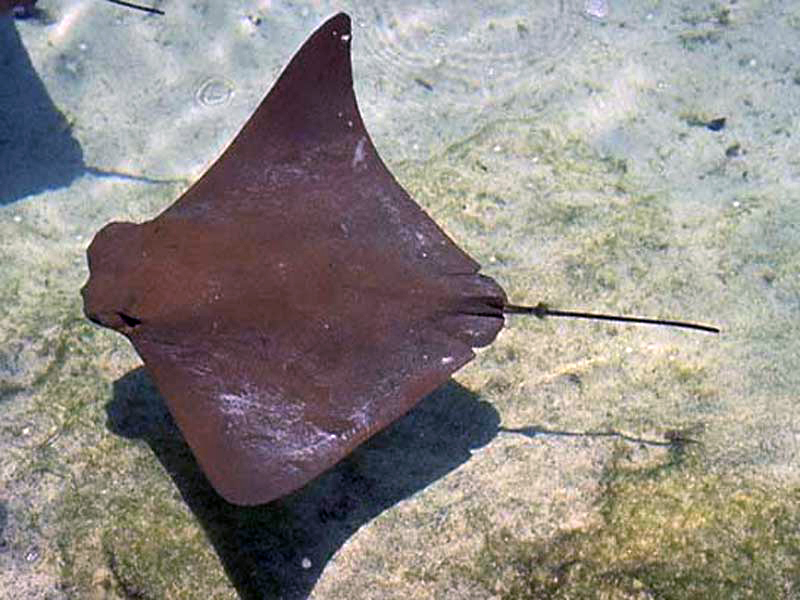
Taxonomy
- Kingdom:Animalia
- Phylum: CHORDATA
- SubPhylum: Vertebrata
- Class: Chondrichthyes
- Order: Myliobatiformes
- Family: Rhinopteridae
- Genus: Rhinoptera
- Species: bonasus
Red Drum
Description
Red drum, also known as redfish, are bottom-dwelling fishes found in seagrass beds and over muddy and sand bottoms. Solitary juveniles and subadults inhabit the shallow waters of bays and sounds, where they are seen swimming about with their dorsal fins protruding from the water. Adults normally occur in open oceanic and gulf waters. The red drum has an elongate body and is coppery-brown to reddish, with a black spot or spots on the base of the tail. This species has no chin whiskers or barbells, like the black drum. On the Gulf of Mexico coast, adults can grow to 40 inches and 40 pounds.
What Are The Effects On Clams?
Red drum are primarily carnivores, preferring fish, crabs, and shrimp. They will consume clams. Nursery bags are not typically targeted. However, larger seed in growout bags are vulnerable when they are recently planted and have not yet buried into the bottom sediments. Red drum can draw the bag mesh into their mouths, crush the clam shells with molar-like teeth, and suck out the meats through the mesh openings. Evidence of predation by red drum includes abrasion of the bag fabric, but typically no holes are found.
- FOE
- Predator
What Can A Clam Farmer Do?
Cover netting may be necessary to reduce red drum predation. Net coatings that stiffen the bag mesh may help prevent the fish from drawing the fabric into their mouths. Specific guidelines for use of net coatings can be found in the Florida Department of Agriculture and Consumer Services, Division of Aquaculture, Technical Bulletin Number 4, 2005. <HYPERLINK TO http://www.floridaaquaculture.com/technicalbulletins.htm>
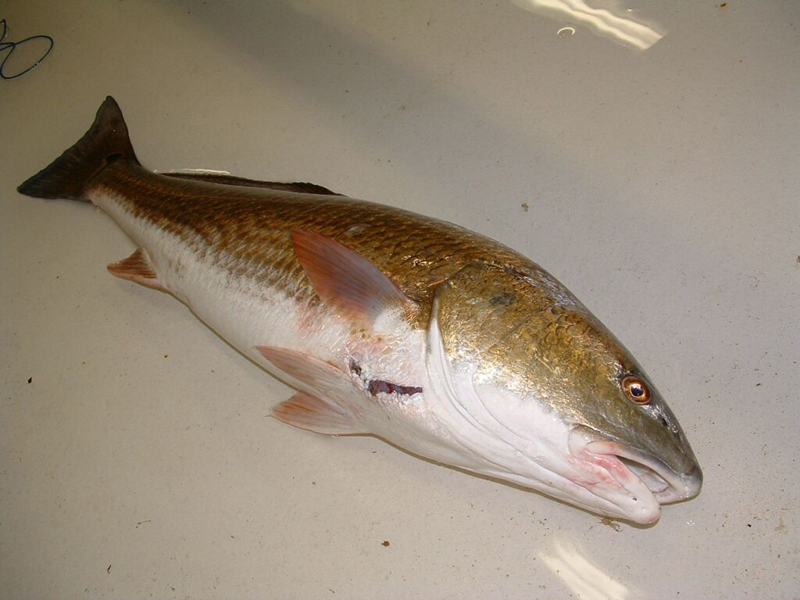
Taxonomy
- Kingdom:Animalia
- Phylum: CHORDATA
- SubPhylum: Vertebrata
- Class: Osteichthyes
- Order: Perciformes
- Family: Sciaenidae
- Genus: Sciaenops
- Species: ocellatus
BlackcheekTongue Fish
Description
The blackcheek tonguefish is an abundant species generally seen over mud bottoms of inshore waters and rarely found deeper than 120 feet. The elongate, tapering flatfish has a small mouth. Eyes, which are very small, are found on the left side of the head. It has a large, black patch on the operculum (gill cover) and varies in color from tan to dark brown with crossbands present or not. The dorsal (top) and anal (bottom) fins are continuous with the pointed caudal (tail) fin, and there are no pectoral (shoulder) fins nor fin spines. This moderately small, slender bottom fish can reach a length of up to 8 inches.
What Are The Effects On Clams?
Tongue fish prey on small invertebrates, such as worms, and otherwise have no known effects on clams.
- NEIGHBOR
What Can A Clam Farmer Do?
No action needs to be taken by a clam farmer.
Gobies
Description
There are more than 2,000 species of gobies and most live in tropical coastal waters. Gobies live in very shallow, protected waters, including seagrass beds and algal mats. They are secretive bottom-dwellers and have protective coloration that matches their backgrounds. Gobies often are not noticed until they make sudden darting movements. Gobies are small and those in the Suwannee Sound area reach only 3-6 inches in length.
What Are The Effects On Clams?
Gobies prey on small shrimp-like organisms, such as amphipods and isopods, and otherwise have no known effects on clams.
- NEIGHBOR
What Can A Clam Farmer Do?
No action needs to be taken by a clam farmer.
Blennies
Description
The combtooth blennies are small fishes that live in and around rocks, reefs and other hard substrates, including clam culture bags. Blennies are territorial and nest in holes such as cans or empty shells. They are recognized by the hair-like or fleshy projections on their heads. The teeth are comb-like. These fish have no scales. Blennies are small and those in the Suwannee Sound area reach no more than 5 inches in length.
What Are The Effects On Clams?
Blennies are herbivores and may help keep clam culture bags clean of fouling macro algae.
- FRIEND
What Can A Clam Farmer Do?
No action needs to be taken by a clam farmer.
Bushy Bryozoan
Description
The bushy bryozoan is a branching bush-like bryozoan that inhabits hard substrates, primarily in the intertidal zone. Colonies are grey-brown and hang limply when the tide is out. Bushy bryozoan colonies are about 2 ½ inches in height.
What Are The Effects On Clams?
The bushy bryozoan is a filter feeder and therefore competes with clams for the same types of food (micro algae). It can also be a fouling nuisance on clam bags. If fouling is extensive enough to restrict water flow into the bags, clams may suffocate, especially at high water temperatures.
- FOE
- Competitor
- Fouler
What Can A Clam Farmer Do?
Growers should inspect culture bags to determine the extent of fouling, particularly at lease sites with limited tidal exchange. Clumps can be manually removed by hand or with a brush and will not reattach. Extensively fouled cover netting can be replaced with clean netting.
Common Bugula
Description
Bugula is a bryozoan which is commonly found worldwide. It appears as a reddish-brown, plant-like tuft up to 4 inches tall, fouling rocks, shells, pilings, debris and even crabs. Individual zooids (individuals in a colony arising through asexual reproduction) are arranged alternately in two rows along each branch, and face the same direction on the branch. They are suspension feeders, using a U-shaped lophophore (feeding organ) to catch drifting plankton. Each zooid is hermaphroditic, capable of spawning by itself.
What Are The Effects On Clams?
The common bugula is a filter feeder and therefore competes with clams for the same types of food (micro algae). It can also be a fouling nuisance on clam bags. If fouling is extensive enough to restrict water flow into the bags, clams may suffocate, especially at high water temperatures.
- FOE
- Competitor
- Fouler
What Can A Clam Farmer Do?
Growers should inspect culture bags to determine the extent of fouling, particularly at lease sites with limited tidal exchange. Clumps can be manually removed by hand or with a brush and will not reattach. Extensively fouled cover netting can be replaced with clean netting.
Green Fleece, Dead Man's Fingers
Description
Green fleece is a dark green macro algae that is found in intertidal and inshore subtidal zones, growing from hard bottoms. It has large, forked branches (or tubular “fingers”) with a felt-like or rubbery texture. Each branch of this macro algae is rope-like, made up of tightly interwoven microscopic filaments. The erect branches, attached from a broad disk or holdfast, can exceed 12 inches in length.
What Are The Effects On Clams?
Green fleece has a holdfast (a root-like structure) with which it can attach to clam bags and cover netting. It can also be a drift macro algae, meaning it can float and move with prevailing currents. It can become a problem at lease areas with limited flow, such as those located in lagoons, sounds and harbors, and at high water temperatures. When it dies and decomposes on top of clam bags, it can create an anoxic (no oxygen) layer, resulting in clam mortalities.
- FOE
- Fouler
What Can A Clam Farmer Do?
Inspect bags to determine extent of fouling, particularly at lease sites with limited flow and when water temperatures are high. If fouling over the bags is extensive, then it must be removed. Some clam growers actually use custom-designed “push” nets, operated from their boats to remove drift algae. Fouled cover netting could be removed and clean cover netting replaced over bags.
Mermaid's Hair, Angel Hair
Description
Mermaid's hair has bright green, tubular filaments and is common in quiet waters and hard bottoms. This macro algae, or seaweed, is usually found growing in dense, tangled masses and is also found mixed with other green macro algae, such as sea lettuce. It is extremely variable in length and diameter of tubes, which may by constricted at intervals. Mermaid's hair can reach a height of 12 inches tall.
What Are The Effects On Clams?
Mermaid’s hair has a holdfast (a root-like structure) with which it can attach to clam bags and cover netting. It can also be a drift macro algae, meaning it can float and move with prevailing currents. It can become a problem at lease areas with limited flow, such as those located in lagoons, sounds and harbors, and at high water temperatures. When it dies and decomposes on top of clam bags, it can create an anoxic (no oxygen) layer, resulting in clam mortalities.
- FOE
- Fouler
What Can A Clam Farmer Do?
Inspect bags to determine extent of fouling, particularly at lease sites with limited flow and when water temperatures are high. If fouling over the bags is extensive, then it must be removed. Some clam growers actually use custom-designed “push” nets, operated from their boats to remove drift algae. Fouled cover netting could be removed and clean cover netting replaced over bags.
Red Sticky Hydroid, Pink Hydroid
Description
The red sticky hydroid, or pink hydroid, has irregularly arranged, branched stems that bear polyps (attached animals with a columnar body topped by a ring of tentacles). Each trumpet-shaped polyp is surrounded by whorls of filamentous tentacles. These hydroids are often found with sea spiders, which prey on them. Colonies are colorful and reach 5 inches in diameter.
What Are The Effects On Clams?
The red sticky hydroid is a filter feeder and, therefore, can compete with clams for the same types of food (micro algae). It can also be a fouling nuisance on clam bags. If fouling is extensive enough to restrict water flow into the bags, clams may suffocate, especially at high water temperatures.
- FOE
- Competitor
- Fouler
What Can A Clam Farmer Do?
Growers should inspect culture bags to determine the extent of fouling, particularly at lease sites with limited tidal exchange. Clumps can be manually removed by hand or with a brush and will not reattach. Extensively fouled cover netting can be replaced with clean netting.
Rolling Moss, Drift Algae
Description
Found in Florida, the Bahamas, and throughout the Caribbean, this tough, wiry alga is often the principal component of mixed turfs. Found from the intertidal zone to about 20 feet deep, it will frequently attach to hard substrates only to break off and drift with the current. The branches are sparse, olive-yellow to dark red-brown, and cylindrical to slightly flatten. Branchlets, ¼ inch in size, are found scattered or arranged in opposite rows on the branches.
What Are The Effects On Clams?
This macro algae can drift, meaning it floats with prevailing currents, and can be found to “roll” on the bottom. It also has a holdfast (a root-like structure) with which it can attach to clam bags and cover netting. It can become a problem at lease areas with limited flow, such as those located in lagoons, sounds and harbors, and at high water temperatures. When it dies and decomposes on top of clam bags, it can create an anoxic (no oxygen) layer, resulting in clam mortalities.
- FOE
- Fouler
What Can A Clam Farmer Do?
Inspect bags to determine extent of fouling, particularly at lease sites with limited flow and when water temperatures are high. If fouling over the bags is extensive, then it must be removed. Some clam growers actually use custom-designed “push” nets, operated from their boats to move the algae. Fouled cover netting could be removed and clean cover netting replaced over bags.
Rolling Moss, Drift Algae
Description
This group of macro algae, or seaweeds, is cosmopolitan in distribution, and has been reported from the artic, temperate and tropical regions of the world. They occur in intertidal and shallow subtidal zones on hard bottoms, attached to surfaces, but can also drift with prevailing water movements. They are usually deep red, maroon, or purplish, but may also be orange or green in coloration. Several species display rounded and strap-shaped branches which start from a small holdfast (a root-like structure). In some species, the entire plant consists of slender, rounded branches that constrict slightly at their point of attachment. In others, main branches are strap-shaped and branchlets are strap-shaped or rounded in cross section. The branches can reach up to 1 foot in length.
What Are The Effects On Clams?
This group of macro algae has a holdfast (a root-like structure) with which it can attach to clam bags and cover netting. They can also drift, meaning they float with prevailing currents, and can be found to “roll” on the bottom. They can become a problem at lease areas with limited flow, such as those located in lagoons, sounds and harbors, and at high water temperatures. When they die and decompose on top of clam bags, an anoxic (no oxygen) layer can be created, resulting in clam mortalities.
- FOE
- Fouler
What Can A Clam Farmer Do?
Inspect bags to determine extent of fouling, particularly at lease sites with limited flow and when water temperatures are high. If fouling over the bags is extensive, then it must be removed. Some clam growers actually use custom-designed “push” nets, operated from their boats to remove the drift algae. Fouled cover netting could be removed and clean cover netting replaced over bags.
Rolling Moss, Drift Algae
Description
This alga is found in Florida and the Antilles on shell fragments, sand plains, or tangled in seagrass beds to 90 feet deep. It can be purple, pink, rose-red, or brown in color. The branches are cylindrical, irregularly alternate, and may appear to have knobs between branchlets. It can reach heights of up to 6 feet.
What Are The Effects On Clams?
This macro algae can drift, meaning it floats with prevailing currents, and can be found to “roll” on the bottom. It also has a holdfast (a root-like structure) with which it can attach to clam bags and cover netting. It can become a problem at lease areas with limited flow, such as those located in lagoons, sounds and harbors, and at high water temperatures. When it dies and decomposes on top of clam bags, it can create an anoxic (no oxygen) layer, resulting in clam mortalities.
- FOE
- Fouler
What Can A Clam Farmer Do?
Inspect bags to determine extent of fouling, particularly at lease sites with limited flow and when water temperatures are high. If fouling over the bags is extensive, then it must be removed. Some clam growers actually use custom-designed “push” nets, operated from their boats to move the algae. Fouled cover netting could be removed and clean cover netting replaced over bags.
Rolling Moss, Drift Algae
Description
This tough, cartilaginous group of algae can be highly variable but most forms are bushy and dark red to green-brown in color. Branches are cylindrical and branchlets may appear to have knobby ends. These algae are common throughout Florida, the Bahamas, and the Caribbean. During certain times of the year, they can form dense drift mats on the bottom. Clumps can reach 6 to12 inches in diameter.
What Are The Effects On Clams?
These macro algae can drift, meaning they float with prevailing currents, and can be found to “roll” on the bottom. They also have a holdfast (a root-like structure) with which they can attach to clam bags and cover netting. They can become a problem at lease areas with limited flow, such as those located in lagoons, sounds and harbors, and at high water temperatures. When they die and decompose on top of clam bags, they can create an anoxic (no oxygen) layer, resulting in clam mortalities.
- FOE
- Fouler
What Can A Clam Farmer Do?
Inspect bags to determine extent of fouling, particularly at lease sites with limited flow and when water temperatures are high. If fouling over the bags is extensive, then it must be removed. Some clam growers actually use custom-designed “push” nets, operated from their boats to move the algae. Fouled cover netting could be removed and clean cover netting replaced over bags.
Colorful Sea Whip
Description
Colorful sea whips grow on shelly bottoms in bays and tidal creeks, but can also be found on docks and oyster reefs. They may be purple, white, orange, yellow, or red. Colonies attach to hard substrates with a tough holdfast (a root-like structure). Undisturbed colonies expand small white polyps from the stem and branches. The springy branches have an internal skeleton that looks like a black or brown wire. Colorful sea whips grow to 24 inches in length.
What Are The Effects On Clams?
The colorful sea whip is a filter feeder and, therefore, competes with clams for the same types of food (micro algae). It attaches to clam culture bags and other hard substrates with a tough tenacious holdfast.
- FOE
- Competitor
- Fouler
What Can A Clam Farmer Do?
Colorful sea whips can be difficult to impossible to remove from bags. However, they do not occur in high densities and consist of a few springy branches. Therefore, they pose little problem as fouling organisms. Some growers believe that the presence of sea whips on a culture bag indicates “good clam production.”
Feather Hydroid
Description
Feather hydroids are abundant fouling organisms in high salinity areas, especially in summer and fall. They particularly like moderate to strong water flow. Branches are arranged on either side of a central branch, resembling a feather. Stems are black and the polyps are pinkish-white. Polyps are cone-shaped, with a whorl of long tentacles at the base and whorls of short tentacles at the top. Feather hydroids reach 8 inches in height.
What Are The Effects On Clams?
The feather hydroid is a filter feeder and, therefore, competes with clams for the same types of food (micro algae). It can also be a fouling nuisance on clam bags. If fouling is extensive enough to restrict water flow into the bags, clams may suffocate, especially at high water temperatures.
- FOE
- Competitor
- Fouler
What Can A Clam Farmer Do?
Growers should inspect culture bags to determine the extent of fouling, particularly at lease sites with limited tidal exchange. Clumps can be manually removed by hand or with a brush and will not reattach. Extensively fouled cover netting can be replaced with clean netting.
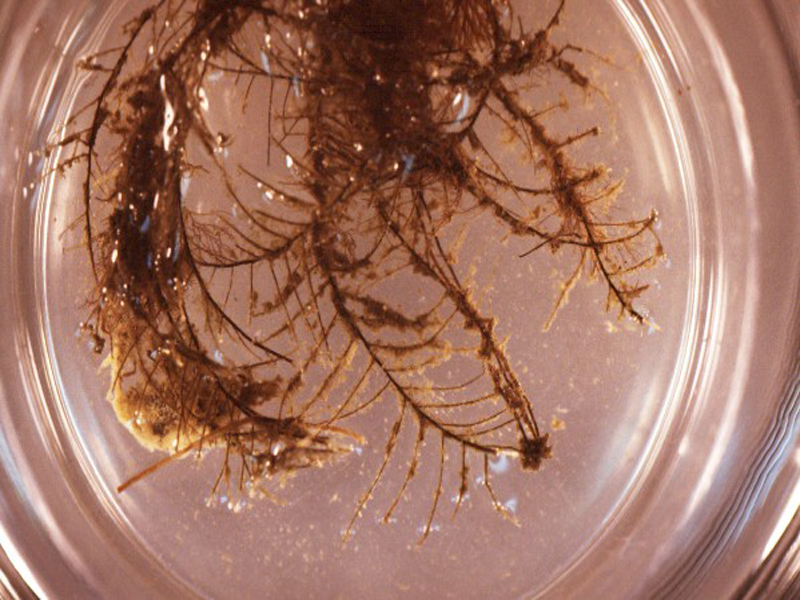
Taxonomy
- Kingdom:Animalia
- Phylum: CNIDARIA
- SubPhylum:
- Class: Hydrozoa
- Order: Anthoathecatae
- Family: Pennariidae
- Genus: Pennaria
- Species: disticha
Sea Lettuce
Description
Sea lettuce has one to several wrinkled, broad, and flat blades arising from a basal holdfast and is one of the best-known seaweeds. It can also be found free-floating in tidal shallows. This bright green macro algae can reach 10 feet in length.
What Are The Effects On Clams?
Sea lettuce has a holdfast (a root-like structure) with which it can attach to clam bags and cover netting. It can also be a drift macro algae, meaning it can float and move with prevailing currents. It can become a problem at lease areas with limited flow, such as those located in lagoons, sounds and harbors, and at high water temperatures. When it dies and decomposes on top of clam bags, it can create an anoxic (no oxygen) layer, resulting in clam mortalities.
- FOE
- Fouler
What Can A Clam Farmer Do?
Inspect bags to determine extent of fouling, particularly at lease sites with limited flow and when water temperatures are high. If fouling over the bags is extensive, then it must be removed. Some clam growers actually use custom-designed “push” nets, operated from their boats to remove drift algae. Fouled cover netting could be removed and clean cover netting replaced over bags.
Straw Bryozoan
Description
The straw bryozoan occurs in quiet waters in deep tidal creeks or harbors, but can also be found intertidally. Individual zooids (individuals in a colony arising through asexual reproduction) are found in two rows on each side of the stem and branches. The irregular branches are soft and flaccid, resembling transparent oriental noodles. The straw bryozoan may exceed 12 inches in length.
What Are The Effects On Clams?
The straw bryozoan is a filter feeder and therefore competes with clams for the same types of food (micro algae). It can also be a fouling nuisance on clam bags. If fouling is extensive enough to restrict water flow into the bags, clams may suffocate, especially at high water temperatures.
- FOE
- Competitor
- Fouler
What Can A Clam Farmer Do?
Growers should inspect culture bags to determine the extent of fouling, particularly at lease sites with limited tidal exchange. Clumps can be manually removed by hand or with a brush and will not reattach. Extensively fouled cover netting can be replaced with clean netting.
Snapping Shrimp
Description
The snapping shrimp, while very common from North Carolina to the West Indies, is rarely seen, though often heard. Usually hiding among oyster reefs and other hard structures in intertidal zones, snapping shrimp, also called pistol shrimp, use an enlarged claw to make a loud snapping noise. This can be used to fend off predators or stun prey, and has been known to break glass in aquaria. The big-clawed snapping shrimp is the largest in the area, reaching up to 2 inches in carapace length, and has a green color to the body, black and white markings on the claws, red walking legs, and orange and blue lines along the tail. It also has two distinct notches in the large claw, at the base of the fingers.
What Are The Effects On Clams?
These shrimp will catch and consume some of the smaller predators found in clam bags, such as small mud crabs, but will also consume some animals that can be beneficial to clams such as other small shrimps.
- FRIEND
What Can A Clam Farmer Do?
No action needs to be taken by a clam farmer.
Skeleton Shrimp
Description
Skeleton shrimp are found on hydroids, bushy algae, and other growth, near the low-tide line and below. These crustaceans have a pale buff or tan to greenish color. They have small, round eyes and a long, slender, arched, jointed body with a rounded head at the front. The first antennae are 1/3 the body length and twice the length of the second antennae. First and second thoracic appendages appear as grasping claws. A pair of saclike gills is found on the next two segments and the last 3 segments have bristly grasping appendages directed backward. Skeleton shrimp are small, ranging from ¾ of an inch to 2 inches in length, and are very narrow in width.
What Are The Effects On Clams?
These tiny crustaceans may be found in high numbers on clam bags or on other organisms fouling clam bags, but present no problem for the clams themselves.
- NEIGHBOR
What Can A Clam Farmer Do?
No action needs to be taken by a clam farmer.
Pink Shrimp
Description
The pink shrimp comprises one of the largest commercial marine fisheries in the world. It is an extremely common shrimp in inshore waters from Virginia to Mexico, and can reach up to 10 inches long. The antennae of this shrimp are much longer than the body, and this genus is separated from most others by having three pairs of small pincers. As the name implies, it is colored a translucent pink, and has a distinct groove running the length of the carapace (the shell covering the head). There is a dark spot on either side of the abdomen between the 3rd and 4th segments, and has a long, sharp rostrum above the head, with about 10 spines on top and 2-3 on the bottom. Larvae of this shrimp grow in estuarine waters, then move offshore as adults to spawn. It is these spawning grounds that are used by fishermen for large catches.
What Are The Effects On Clams?
This common shrimp helps clams in two ways. Aeration of the sediment and oxidation of sulfides occurs when it burrows into the sediment. At night, they come out to feed on organic wastes, such as accumulated clam feces and pseudofeces, removing these wastes from the clam lease.
- FRIEND
What Can A Clam Farmer Do?
No action needs to be taken by a clam farmer.
Beach Flea
Description
Beach fleas are small amphipods, rarely reaching above ½ inch in length. They are common all along the Atlantic and Gulf of Mexico coasts. They have a brown to translucent color, and feed on detritus, decaying algae and grass. They can often be seen swarming underneath rocks and dead weed lines along the beach. Lying on their side, beach fleas remain under shelter, but when disturbed, they jump and/or swim away quickly, often jumping like fleas.
What Are The Effects On Clams?
These small crustaceans are detritivores, meaning that they feed on organic wastes. In doing so, they can consume clam feces and pseudofeces, removing these wastes from the clam bag.
- FRIEND
What Can A Clam Farmer Do?
No action needs to be taken by a clam farmer.
False Zostera Shrimp, Broken Back Shrimp
Description
The false zostera, or broken back, shrimp is often found among shallow water vegetation from Connecticut to Texas. It is very small, only ½ inch in length, and ranges from brown to green in color, to match the color of the seagrass it lives in, especially eelgrass. The first and second pairs of legs are modified into claws, the second pair being bigger. So-called because of the sharp bend of the abdomen at the third segment, giving it the appearance of a broken back, the shrimp also has tufts of hair on the back side of the abdomen and carapace.
What Are The Effects On Clams?
These small shrimp consume bits of algae and can be beneficial in keeping clam bags clean.
- FRIEND
What Can A Clam Farmer Do?
No action needs to be taken by a clam farmer.
Gribble
Description
These species of isopods are common, though discreet, crustaceans, rarely reaching over ¼ inch in length. They range from New England to South America, and are almost cylindrical in shape. They are wood borers, well known for causing heavy destruction in unkempt wood such as boats, pilings, and flotsam. Often times, they are the reason for the numerous holes in driftwood found washed ashore, or for the hourglass shape of dock pilings at the intertidal levels. Individuals are colored black and grey with white mottling, and can be dug out of the wood with a pocket knife.
What Are The Effects On Clams?
These "pillbug"-looking crustaceans can be found in clam bags adjacent to wooden pilings. Although they pose no direct threat to clams, they are very destructive to wooden structures.
- FOE
What Can A Clam Farmer Do?
As a deterrent, clam farmers can use PVC pipe for lease markers.
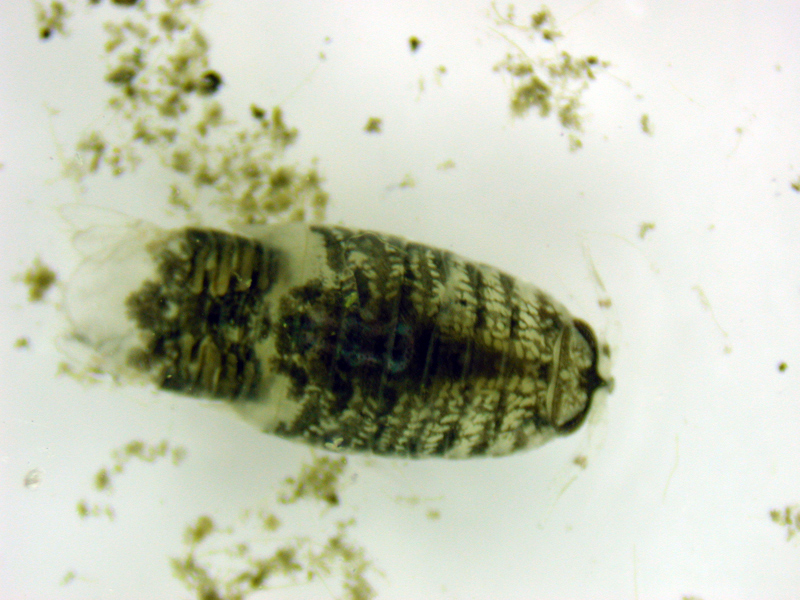
Taxonomy
- Kingdom:Animalia
- Phylum: ARTHROPODA
- SubPhylum: Crustacea
- Class: Malacostraca
- Order: Isopoda
- Family: Limnoriidae
- Genus: Limnoria
- Species: sp.
Peppermint Shrimp
Description
The peppermint shrimp is found on rocks, jetties, coral reefs, among hydroids on pilings and buoys and other structures from low-tide to water 100 feet deep. This shrimp is translucent white with longitudinal red stripes, edged with white, down the back and traverse stripes on the side. Its appearance is responsible for its common name. The peppermint shrimp can grow to a length of almost 3 inches and a height of ½ inch. This species and others of its genus act as cleaners, picking tissue debris and parasites off surfaces of fishes that actively seek them out.
What Are The Effects On Clams?
Peppermint shrimp remove and consume small parasitic organisms from substrates and can therefore be considered beneficial to have around clam leases.
- FRIEND
What Can A Clam Farmer Do?
No action needs to be taken by a clam farmer.
Daggerblade Grass Shrimp
Description
The grass shrimp is the most common shrimp-like species in seagrass beds and often found in brackish waters. This shrimp is transparent with claws present on the first and second legs with the second claws being the largest. The rostrum (knife-like, serrated structure projecting like a horn from the head) tapers to a sharp point and is toothed on the upper edge with three teeth present on the lower edge. The back in this species is straight. The grass shrimp can reach a length of 2 inches.
What Are The Effects On Clams?
Grass shrimp remove and consume small parasitic organisms from substrates and, therefore, can be considered beneficial to have around clam leases.
- FRIEND
What Can A Clam Farmer Do?
No action needs to be taken by a clam farmer.
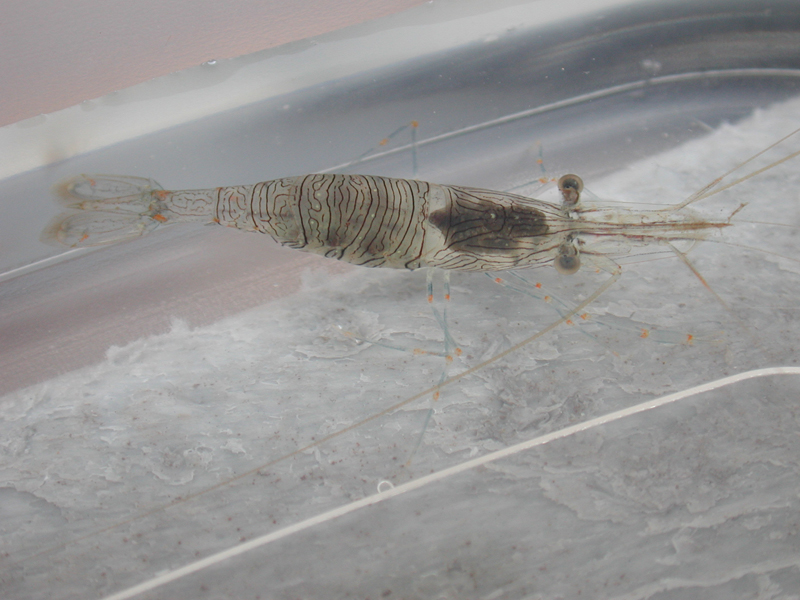
Taxonomy
- Kingdom:Animalia
- Phylum: ARTHROPODA
- SubPhylum: Crustacea
- Class: Malacostraca
- Order: Decapoda
- Family: Palaemonidae
- Genus: Palaemonetes
- Species: pugio
Southern Gribble
Description
The southern gribble is a common isopod in the southeastern U.S., found among intertidal rocks and seaweeds. It is identified best by microscope, noting that its hindmost appendages (uropods) reach to the very edge of the rounded tail, and that there are 4 teeth on the edge of each of the uropods. It can be seen in many different colors, including green, brown, and orange, and reaches 4/5 inches in length. Similar to backyard roly-polies or pillbugs, this isopod can roll up into a ball in defense.
What Are The Effects On Clams?
These "pill bug"-looking crustaceans can be found in clam bags adjacent to wooden pilings. Although they pose no direct threat to clams, they are very destructive to wooden structures.
- FOE
What Can A Clam Farmer Do?
As a deterrent, clam farmers can use PVC pipe for lease markers.
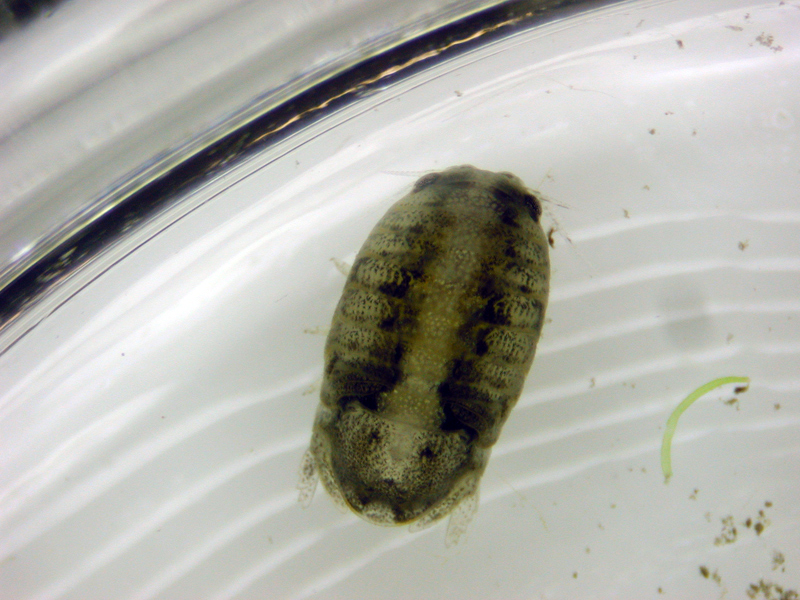
Taxonomy
- Kingdom:Animalia
- Phylum: ARTHROPODA
- SubPhylum: Crustacea
- Class: Malacostraca
- Order: Isopoda
- Family: Sphaeromatidae
- Genus: Sphaeroma
- Species: quadridentatum
Arrow Shrimp
Description
The arrow shrimp is a long, small, slender shrimp, found in the Gulf of Mexico and the Caribbean and North Carolina, though not in South Carolina or Georgia. It is usually colored a bright green to brown, depending on the grasses that it is living in. It reaches a length of about 2 inches, and is very common in shallow waters with vegetation or similar cover. Swimming in a vertical position, it is very well camouflaged among the grasses. The legs in general are short, with the first pair very short. The abdomen has a strong bend after the third segment, and the sharp rostrum (knife-like structure projecting like a horn from the head) is very long, taking a slight curve upward towards the very front. The top of the rostrum is smooth, while the bottom has up to 20 spines. In addition, there are two sharp spines at either side of the base of rostrum. The arrow shrimp feeds mainly on both plant and animal growths on and within sea grasses.
What Are The Effects On Clams?
This stick-looking shrimp consumes bits of algae and can be beneficial in keeping clam bags clean.
- FRIEND
What Can A Clam Farmer Do?
No action needs to be taken by a clam farmer.
Coastal Mud Shrimp
Description
The mud shrimp is found burrowed in sand and mud flats of the intertidal and subtidal zones, often under flat stones. This long, slender shrimp varies from almost pure white to a bluish or yellowish gray and resembles a miniature lobster with a fat abdomen and membranous shell. The first pair of antennae are small and the second pair are ½ the body length and bristle-like. The rostrum is squarish, flattened, and extends beyond its tiny eyes. The first pair of walking legs and carapace (shell over head and thorax) may be covered in a mat of fine bristles. The abdomen is large, twice the length of carapace, and separated from it by a deep constriction. The tail fan is also large. The mud shrimp can reach a length of 4 inches. This crustacean is not a true shrimp, but is more closely related to the hermit crab.
What Are The Effects On Clams?
Mud shrimp burrow into the sediment which can be beneficial; however, they are filter feeders and therefore can compete for the same types of food as clams (micro algae).
- FOE
- Competitor
What Can A Clam Farmer Do?
These shrimp are not found in high numbers and present little problem.
Lunar Dovesnail, Black Snail
Description
The lunar dovesnail is a very common snail, often overlooked due to its size; it never exceeds ½ inch in length. It is commonly found in intertidal hard bottoms, crawling around on algae, bryozoans ,or other bottom dwelling growths, especially branching bush-like bryozoans. It is spindle-shaped, having a fat middle and thin ends. It has a smooth, un-sculptured, brown shell with dark zigzags or pale spiral bands. The operculum that covers the long and narrow aperture (shell opening) is horny, and is an elongate oval with a curved narrow end.
What Are The Effects On Clams?
The dovesnail is a detritivore, meaning that it feeds on organic wastes. In doing so, it can consume clam feces and pseudofeces, removing these wastes from the clam bag.
- FRIEND
What Can A Clam Farmer Do?
No action needs to be taken by a clam farmer.
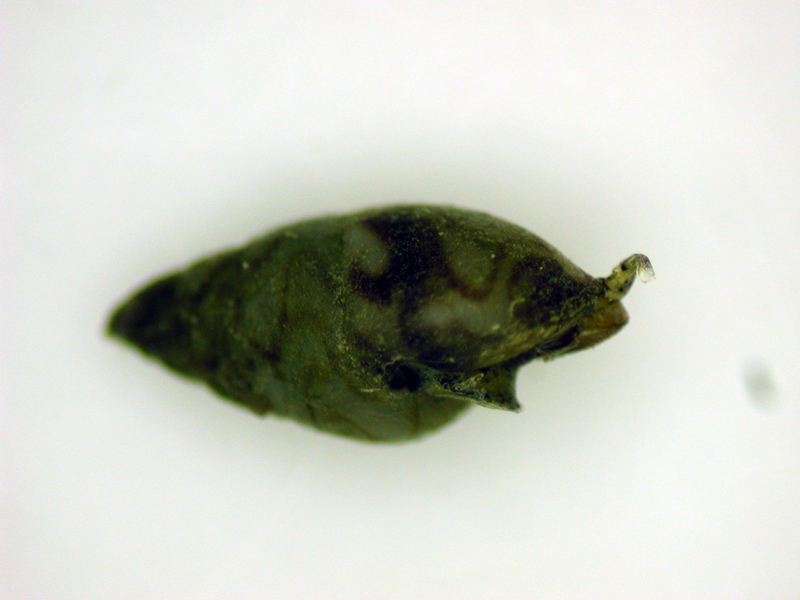
Taxonomy
- Kingdom:Animalia
- Phylum: MOLLUSCA
- SubPhylum:
- Class: Gastropoda
- Order: Neogastropoda
- Family: Columbellidae
- Genus: Astyris
- Species: lunata
Striate Bubble
Description
The striate bubble is a common gastropod (snail) of shallow, grassy mud flats from North Carolina to the West Indies. It has a dome-like shell with a broad aperture and reaches almost 1 inch in length. The shell is white with irregular brown striations, and when the body of the animal is extended, it completely envelops the shell. The bubble snail is a hermaphrodite, meaning that both sexes are contained in one animal, and lays jelly-like ribbons in which its eggs are embedded.
What Are The Effects On Clams?
The bubble snail is a herbivore, meaning that it feeds on plant material. It primarily consumes green macro algae which it grinds up with plates in its gizzard. In doing so, it can help keep clam bags free of macro algae that otherwise may foul the bag.
- FRIEND
What Can A Clam Farmer Do?
No action needs to be taken by a clam farmer.
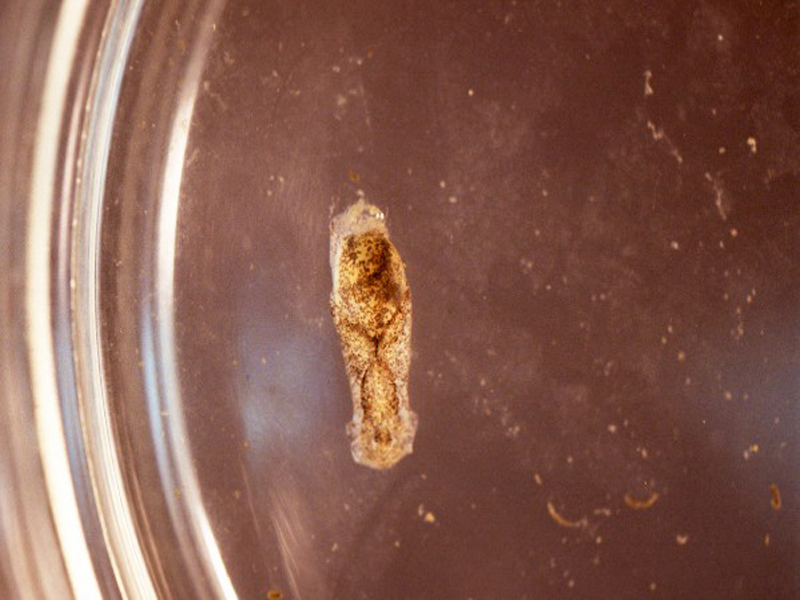
Taxonomy
- Kingdom:Animalia
- Phylum: MOLLUSCA
- SubPhylum:
- Class: Gastropoda
- Order: Cephalaspidea
- Family: Bullidae
- Genus: Bulla
- Species: striata
Lightning Whelk
Description
The lightning whelk is a very large, common predatory gastropod (snail) in Florida's shallow waters. It gets its name from the brown lightning-like streaks down the length of the shell. Older shells tend to be white. This is one of the few "left-handed" snails, meaning the spirals of the shell go to the left. It can reach 16 inches in length and 7 inches in width.
What Are The Effects On Clams?
This whelk feeds on larger clams, by using the hard part of its foot to grasp the clam and hammer away at the edge of the shell until it breaks. Using its foot and body, the whelk rocks the clam back and forth. Gradually the clam is forced open and then it inserts its proboscis (snout) to consume the clam meat. Their predatory activity leaves a distinctive chipped or scrapped mark on the clam shell.
- FOE
- Predator
What Can A Clam Farmer Do?
The clam bag is an effective deterrent as the whelk can not grasp the clam from outside the bag.
Pear Whelk
Description
The pear whelk is not as commonly found as other whelks. It is tan with wavy, reddish-brown vertical streaks. The shell is thin and the body whorl, which has a deep channel, comprises almost all of the shell. The spire is flattened and the shell has no knobs. This whelk can reach a length of 5 ½ inches.
What Are The Effects On Clams?
This whelk is less likely to consume hard clams than the heavier shelled snails, such as the crown conch, and is not found frequently in the clam lease environment. Size preference is for the larger adult clams. Feeding actions are similar to the crown conch; the whelk forces the clam shells open with its shell and then inserts its proboscis (snout) to consume the clam meat.
- FOE
- Predator
What Can A Clam Farmer Do?
The clam bag and cover netting are effective control methods.
Channeled Whelk
Description
The channeled whelk is a very common snail found on sand bottoms in shallow water. There is a deep groove or channel that spirals around the top of the shell. The outer edge (shoulder) of the body whorl is broad and flat, without ornamentation. Color is beige or yellowish gray. There is often a hairy outer layer. Channeled whelks grow to 8 inches long; the opening is about ¾ the total shell length.
What Are The Effects On Clams?
This whelk is less likely to consume hard clams than the heavier shelled snails, such as the crown conch, and is not found frequently in the clam lease environment. Size preference is for the larger adult clams. Feeding actions are similar to the crown conch; the whelk forces the clam shells open with its shell and then inserts its proboscis (snout) to consume the clam meat.
- FOE
- Predator
What Can A Clam Farmer Do?
The clam bag and cover netting are effective control methods.
Dark Cerith
Description
The dark cerith is a tall-spired snail reaching 1½ inches in height, with an oval aperture covered by a dark ovoid operculum (lid-like structure closing the shell opening). It ranges from North Carolina to the tropics, and inhabits shallow, subtidal waters. The dull grey and white-specked shell has 6 or 7 whorls, several longitudinal ribs, and spiral, beaded rows. The edges of its apertures are toothy and thick, with the bottom edge curved outward. Sexes are separate, and eggs are laid in jelly masses or strings.
What Are The Effects On Clams?
The cerith snail is a detritivore, meaning that it feeds on organic wastes. In doing so, it can consume clam feces and pseudofeces, removing these wastes from the clam bag.
- FRIEND
What Can A Clam Farmer Do?
No action needs to be taken by a clam farmer.
Variable Cerith
Description
The variable cerith is similar to the dark cerith, but doesn't grow nearly as big, reaching less than 1 inch in length. It has a sharp spire, 5 or 6 whorls, and revolving rows of beads. It is a brownish color mottled with white, and also feeds upon detritus in the shallow, subtidal waters of the southeastern U.S. The shell is much thinner than that of the dark cerith, and it has a smooth edge to the aperture. The bottom of the aperture doesn't have a hook at the end, as in that of the dark cerith.
What Are The Effects On Clams?
The cerith snail is a detritivore, meaning that it feeds on organic wastes. In doing so, it can consume clam feces and pseudofeces, removing these wastes from the clam bag.
- FRIEND
What Can A Clam Farmer Do?
No action needs to be taken by a clam farmer.
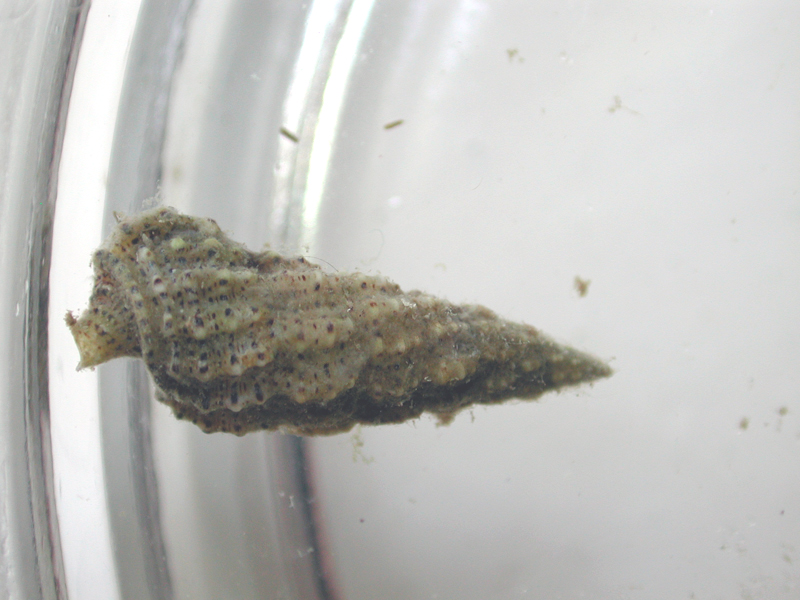
Taxonomy
- Kingdom:Animalia
- Phylum: MOLLUSCA
- SubPhylum:
- Class: Gastropoda
- Order: Neotaenioglossa
- Family: Cerithiidae
- Genus: Cerithium
- Species: lutosum
Lace Murex
Description
The lace murex is found among mangroves, on rocks, mud or sand bottoms, below the low-tide line in shallow water. This snail appears brownish-black to light brown. Younger specimens can be almost entirely pink with the darker pigments developing as the snail grows. The shell is spiny, sturdy, and rough with an elevated conical spire, and has 7 whorls and 3 prominent spiny ridges. The shell opening is small and round with 8 -10 large, leaf-like spines along the outer lip and a stout, circular, blackish operculum (lid to shell opening). The lace murex can reach 3 inches in length and 1½ inches in width.
What Are The Effects On Clams?
This snail is not as commonly found in the clam lease environment as others, but it does prey on clams. Their predatory activities are similar to those of the oyster drill.
- FOE
- Predator
What Can A Clam Farmer Do?
Cover netting over the clam bags can effectively reduce predation by the lace murex.
Common Atlantic Slippersnail
Description
The slippersnails, or slipper shells, are among the most common gastropods (snails) in shallow waters in the southeastern U.S. They get their name due to a shelf on the inside of the shell, making it look like a slip-on shoe. The common Atlantic slipper shell is a convex shell with a downward curve at the front of the shoe and can form large stacks.
What Are The Effects On Clams?
The slipper shell attaches to the shells of clams, possibly hindering the clam from burying. Also the fouling on the clam shell can make them less desirable for marketing.
- FOE
- Fouler
What Can A Clam Farmer Do?
A clam farmer can easily remove slipper shells from the clam shell by popping them off.
Eastern White Slippersnail
Description
The eastern white slippersnail, or slipper shell, is a very common shallow water gastropod (snail), ranging from Nova Scotia to Texas, and found in similar locations as the common Atlantic slipper shell, but is easily differentiated. The white slipper shell is more of a white color, more concave, and flatter than the other. Like the Atlantic slipper shell, it is a herbivore, feeding on macro algae, or seaweeds. It can often be found on the inside of hermit crab shells. This species does not form large stacks. Instead, a small male can be seen atop a large female.
What Are The Effects On Clams?
The slipper shell attaches to the shells of clams, possibly hindering the clam from burying. Also the fouling on the clam shell can make them less desirable for marketing.
- FOE
- Fouler
What Can A Clam Farmer Do?
A clam farmer can easily remove slipper shells from the clam shell by popping them off.
Banded Tulip
Description
The banded tulip is a common shallow water snail found in sandy bottoms, mud flats, and grass flats. It has about 8 smooth whorls, and reaches up to 3 inches in length, having a very distinct, uninterrupted black band encircling the shell. A large, brown, horny operculum, or lid-like structure, completely closes the shell opening when the animal is frightened. The tulip snail is a voracious predator of other mollusks, both bivalves and gastropods. It uses the thick lips of the aperture to break mollusk shells, and insert its proboscis (snout) to feed. Tulips lay clusters of conical egg capsules onto hard substrate.
What Are The Effects On Clams?
The tulip snail commonly preys on other snails, but is an opportunistic predator on clams. Its feeding behavior is similar to that of the crown conch.
- FOE
- Predator
What Can A Clam Farmer Do?
The clam bag is an effective deterrent to the banded tulip snail.
Crown conch
Description
While its name is correct in terms of the description of the shell (crown-like), the crown conch is not a true conch (true conchs are herbivores and have a distinct notch in the edge of the aperture). The shell is like no other, in that it has very distinct white, curved spines on the shoulder of the shell, which has a rather short spire. The shell is usually brown colored with white spiral bands, and the internal column is white. The body is dark colored, usually speckled with white, and has a horny operculum (lid-like structure closing the shell opening). This snail is a common sight in shallow estuarine waters of the Gulf of Mexico, and is usually associated with mangrove forests and oyster beds along mud flats. It feeds on mollusks (oysters and clams) and other gastropods, but will also scavenge for dead animals. Egg cases look like a string of small potato chips. In the same family as the lightning whelk, this snail’s eggs complete larval stages while in the case and resemble tiny adults when released, unlike many other gastropods.
What Are The Effects On Clams?
The crown conch is an active predator of clams and is abundantly found in clam lease areas. The conch opens a clam by placing the lip of its shell between the clam’s shells. Once the shells are forced open, the conch inserts its proboscis (snout) and consumes the clam meat by rasping away the tissue with its radula, which is a file-like apparatus. There is little evidence on the clam shell of this predatory action. As the conch’s proboscis may extend as much as 6” to reach its prey, the conch can easily consume clams from outside the bag.
- FOE
- Predator
What Can A Clam Farmer Do?
The bag does not deter this conch, but cover netting (chicken wire or plastic) may effectively limit the conch’s access to the bag. Large numbers of crown conchs can be found at times on the lease area. Although removal by hand may be impractical, a clam farmer may try controlling by trapping. Traps are simple small cages made of chicken wire with clams or fish used as bait. There are no state regulations pertaining to the harvest of crown conch, so removal of this snail from the lease area is permissible.
Bruised Nassa, Dog Whelk, Mud Snail
Description
The bruised nassa is the most common of the dog whelks in the southeastern U.S., found on sandy intertidal zones from the Gulf of Mexico to North Carolina. The conical shell is grey to greenish-grey, and has distinct beaded ribs along the whorls. The aperture is oval with pale, flaring lips. The outer lip is toothed along the inner margin, and the operculum (lid-like structure closing the shell opening) is toothed as well. The animal itself has two distinct antennae-like fleshy projections on the back of its foot. This dog whelk feeds upon the eggs of polychaete worms as well as detritus and dead animal material.
What Are The Effects On Clams?
The dog whelk is one of the most common snails found on a clam lease. It is a detritivore, meaning that it feeds on organic wastes. In doing so, it can consume clam feces and pseudofeces, removing these wastes from the clam bag.
- FRIEND
What Can A Clam Farmer Do?
No action needs to be taken by a clam farmer.
Moon Snail, Shark Eye
Description
The moon snail is a common predatory gastropod along the Gulf of Mexico and Atlantic coasts, the shell reaching 3 inches in length. So called due to the blue at the center of the spherical shell apex, the moon snail is found along intertidal sand flats. The animal, when extended, nearly covers its glossy shell, and produces protective mucus to easily slide through the coarse, abrasive sand. They are predators of other mollusks, using their foot to dig up bivalves. Their calling card can be seen among many dead shells washed up on the beach — a perfectly round, beveled hole near the umbo (pointed portion, or “beak,” of a bivalve shell) produced by the moon snail's file-like radula to reach the soft animal inside. Another common sight around shallow sand flats is the moon snail's egg case, the sand collar, which is a 3-4 inch case that looks like a wide, inverted funnel made of sand grains
What Are The Effects On Clams?
The moon snail is found frequently buried in nursery and growout bags, entering the mesh openings as small juvenile snails and growing with the clams. This snail attacks clams in the bag by holding them in place with a large muscular foot. It gains access to the clam shell by means of a flexible proboscis (snout), which extends well beyond its mouth. Attached to the proboscis is a radula, which looks like a file, and an accessory boring organ resembling a soft pad. When the pad is applied to the clam shell, secretions soften the shell to allow the radula to scrape out a hole in the shell. Once the shell is penetrated, the clam meat is consumed. A beveled hole, often found near the shell hinge, is evidence of moon snail predation.
- FOE
- Predator
What Can A Clam Farmer Do?
Since moon snails are burrowers and typically found inside the bag, control is limited. Removal of large adults and their egg cases, which look like a sand collar, by hand or by trapping may reduce snail numbers on the lease.
Common Atlantic Marginella
Description
The common Atlantic marginella occurs abundantly in grass beds at the low-tide line and below in shallow water. This plump little snail can be cream-colored, yellowish, golden, or orange-brown, and has four reddish spots on the outer lip. The shell has a short spire and 3-4 whorls with a large, convex body whorl. The shell opening is long and narrow with a smooth outer lip and an inner lip with four strong folds. There is no operculum (lid that closes the body opening) present in this species. It reaches a length of ½ inch and width of ¼ inch.
What Are The Effects On Clams?
The marginella snail is a detritivore, meaning that it feeds on organic wastes. In doing so, it can consume clam feces and pseudofeces, removing these wastes from the clam bag.
- FRIEND
What Can A Clam Farmer Do?
No action needs to be taken by a clam farmer.
Oyster Drill
Description
Oyster drills are found on rocks and shellfish beds where they prey on bivalves and barnacles. They use a combination of mechanical and chemical methods to drill a hole in their prey’s shell. The gray shells of these snails have spiraling ridges, as well as distinct ribs that run lengthwise from the top to the bottom. The lips of the opening are thin and sharp, and there is a distinct canal where the siphon comes out. The bottom of the shell is pointed. Oyster drills reach 1¼ inches in length.
What Are The Effects On Clams?
Oyster drills are commonly found snails. They are active predators on oysters, but much less so on clams. These snails are known as drills for their ability to bore through mollusk shells using its radula (a file-like apparatus). Once a hole is drilled, the snail inserts its proboscis (snout) to feed on the clam meat. A straight hole is evidence of drill predation and can be found anywhere on the clam shell. Although its feeding activities are similar to the moon snail, it does not bury and can easily pass through the mesh of a growout bag.
- FOE
- Predator
What Can A Clam Farmer Do?
Clams buried in the bags will not be affected by this snail.
Mud Brittle Star
Description
Mud brittle stars are burrowing brittle stars that occur occasionally on the west coast of Florida in soft mud. The central disk reaches ½ inch in diameter and the arm length is more than 10 times the central disk diameter, up to 5 inches. At each arm joint, there are 3 to 4 short spines on each side of the arm. The arms of brittle stars contain neither digestive nor reproductive organs, thus their loss is relatively inconsequential. Once an arm is broken off, regeneration is easily and quickly accomplished.
What Are The Effects On Clams?
Mud brittle stars may be deposit or filter feeders. When filter feeding, 2 to 3 arms are held upright in the water while the disk and other arms are buried in the sediment. Mud brittle stars can also be deposit feeders, consuming sediment and extracting the organic material. As deposit feeders, they remove and recycle clam fecal materials from the culture bags. In addition, their burrowing activities help aerate the sediments.
- FRIEND
What Can A Clam Farmer Do?
As primarily non-competing deposit feeders, mud brittle stars can be left in culture bags.
Blood Brittle Star
Description
Blood brittle stars burrow in oxygen-poor sediments. They are filter-feeders and wave their arms in the water to ventilate their burrows. This species has hemoglobin blood which causes the tube feet to appear red.
What Are The Effects On Clams?
Blood brittle stars are filter feeders and, therefore, compete with clams for food.
- FOE
- Competitor
What Can A Clam Farmer Do?
Blood brittle stars are infrequently found in clam bags and rarely pose a problem.
Grey Sea Star, Armoured Sea Star
Description
Grey sea stars are abundant on sandy bottoms in shallow waters. They are bluish gray on top with a dark blue-gray stripe running the length of each arm and the underside is whitish. They burrow into the sand with their tube feet, in search of food. The tube feet lack suckers and, instead, have rounded or pointed tips. Grey sea stars are fast, reaching speeds of 30 inches per minute.
What Are The Effects On Clams?
Grey sea stars consume brittle stars. However, given the opportunity, they may consume small clams, eating them whole.
- FOE
- Competitor
What Can A Clam Farmer Do?
Clams buried in bottom bags are protected from possible predation by grey sea stars. They are found infrequently on clam leases.
Smooth Brittle Star
Description
Smooth brittle stars occur commonly in grass beds. They are usually olive green, but color may vary and the arms may be banded. The spines lie flat against the arm, giving it a sleek shape. The smooth brittle star can measure up to 3 inches in diameter.
What Are The Effects On Clams?
As an omnivore (an animal which eats both plant and animal material), smooth brittle stars will consume clam wastes, dead clams and other small organisms. Thus, they may help to keep the clam bags clean and free of fouling organisms.
- FRIEND
What Can A Clam Farmer Do?
As primarily non-competing omnivores, smooth brittle stars can be left in culture bags.
Elegant Brittle Star
Description
Elegant brittle stars prefer flat sandy mud habitats. The upper side of the disk is completely covered with plates and scales, forming a flower-like rosette in the center. Color is greenish gray to brown, and the arms may be banded. They reach a diameter of 3 inches.
What Are The Effects On Clams?
As an omnivore (an animal which eats both plant and animal material), elegant brittle stars will consume clam wastes and other small particles. Thus, they may help to keep the clam bags clean and free of fouling organisms.
- FRIEND
What Can A Clam Farmer Do?
As primarily non-competing omnivores, elegant brittle stars can be left in culture bags.
Burrowing Brittle Star
Description
Burrowing brittle stars burrow in fine sand or mud. They have very long, thin arms and reach 16 inches in diameter. The disk is gray and the arms are indistinctly banded.
What Are The Effects On Clams?
Burrowing brittle stars are filter feeders and, therefore, compete with clams for food.
- FOE
- Competitor
What Can A Clam Farmer Do?
Burrowing brittle stars are infrequently found in clam bags and rarely pose a problem.
Spiny Brittle Star
Description
Spiny brittle stars are common and are often associated with fouling organisms such as tunicates, bryozoans and sponges. They are colorful and may be green, grey, red or orange. Spines on the arms are long and glassy. Spiny brittle stars reach a diameter of 2½ inches.
What Are The Effects On Clams?
Spiny brittle stars are filter feeders and, therefore, compete with clams for food.
- FOE
- Competitor
What Can A Clam Farmer Do?
Spiny brittle stars live among other fouling organisms on clam culture bags. Therefore, removal of other fouling species should reduce their numbers.
Opalworm
Description
The opalworm burrows in sand and sandy mud, in oyster beds, and among eelgrass roots, usually in estuaries with low salinities from the low tide line to deep waters. This long, slender, cylindrical worm appears reddish-brown, reddish-yellow, or greenish with a brilliant metallic iridescence. It possesses 500 segments and lacks any visible appendages, resembling a slender earthworm. Its proboscis (snout) is eversible and armed with strong jaws to help break down the bodies of its prey. The opalworm reaches a length of 2 feet and a width of ¼ inch.
What Are The Effects On Clams?
Opalworms are predators of other worms, and can consume worms that could foul or encrust clams and clam bags. In addition, their burying actions can aerate the sediments, improving the quality of the lease bottom
- FRIEND
What Can A Clam Farmer Do?
No action needs to be taken by a clam farmer. Be wary though, a 2 foot specimen could give a clam farmer quite a nip on the finger.
Milky Ribbon Worm
Description
The milky ribbon worm burrows in sand or sandy mud, under rocks, in sheltered bays and estuaries, near the low-tide line and below. This worm varies in color from milky white, yellowish or pinkish in young forms to mature males being red and females being brownish. They also vary in shape over the length of the body being cylindrical and firm at the tail, wide and flat over most of the length of the body, and having a head shaped like a spearhead. There are deep sensory grooves on the head, no eyespots, and the mouth is an elongate slit. The milky ribbon worm is by far the largest ribbon worm on the Atlantic Coast, reaching a length of 4 feet and a width of 5/8 inch.
What Are The Effects On Clams?
The ribbon worm is known to prey on softer shell clams, but may consume smaller hard clams, particularly seed (Woods Hole Sea Grant, 2005). It injects its tooth-like proboscis (snout) into its prey and digests the clam in its shell. Gaped, open, clam shells are left with no signs of forced entry, but often meat is left in the shells.
- FOE
- Predator
What Can A Clam Farmer Do?
The ribbon worm is not found in numbers high enough to cause problems for clam farmers. No practical control method exists.
American Tube Dwelling Anemone
Description
The American tube dwelling anemone occupies muddy sand flats. This anemone inhabits a tough, silky tube that is made of tangled threads. The tube may be colonized by fouling organisms. The animal has two distinct whorls of tentacles and can withdraw into the tube. They feed by spreading the tentacles on the surface of the sand to gather food particles. Tubes may reach 20 inches in length and about 1 ½ inches in diameter.
What Are The Effects On Clams?
The tube dwelling anemone coexists in the clam lease environment and clam bag, with no known effects to clams.
- NEIGHBOR
What Can A Clam Farmer Do?
No action needs to be taken by a clam farmer.
Parchment Tube Worm
Description
The parchment worm is found buried in mud, sandy mudflats and eelgrass beds in protected bays and estuaries, from near the low-tide line to water 25 feet deep. The whitish-tan “U”-shaped tube of this worm is distinctive enough to identify it. The tube is wide enough to accommodate the worm along most of its length. Each end of the tube rises 1-2 inches above the surface of sandy mud flats and tapers, encasing the worm within. The body of this translucent, flesh-colored worm is divided into three sections. The front end has a shovel-shaped head with a pair of short tentacles. Pairs of wing-like and cup-shaped appendages spread a mucus net across the tube to catch plankton and detritus. Periodically, mucus and food are rolled into a ball and passed up the food groove to the head and mouth. The middle section has prominent "fans" used to propel water through the tube. The rear section has 30 segments, each loaded with sperm or eggs in ripe adults. The worm can reach a width of 1 inch and a length of 10 inches, with its tube extending up to 24 inches.
What Are The Effects On Clams?
Parchment worms are filter or suspension feeders and, therefore, can compete for the same type of food (micro algae) as clams.
- FOE
- Competitor
What Can A Clam Farmer Do?
Parchment worms are infrequently found in clam bags and rarely pose a problem.
Ice Cream Cone Worm
Description
The ice cream cone worm occurs on protected beaches along Florida’s coast. The animal builds a tube of sand grains which are perfectly fitted together. As the animal grows, it adds sand grains at the wide end of the tube. The completed tube is fragile but rigid, and resembles an ice cream cone. Tubes are oriented vertically in sand, with the wide head end down. The worm feeds on particles of organic material with stout, golden bristles and tentacles. Ice cream cone worms reach 2 inches in length.
What Are The Effects On Clams?
Since the ice cream worm constructs tubes, it can foul or encrust clams and clam bags.
- FOE
- Fouler
What Can A Clam Farmer Do?
The tubes of the ice cream worm are fragile and can be easily rinsed off the clam shell.
Bamboo Worm
Description
The bamboo worm gets its name due to the conspicuous segmentations making it appear similar to a bamboo stem. They live in straight tubes composed of sand or mud in intertidal flats, and orient with their heads down, feeding on organic matter and sediment while defecating through its upper end onto the surface of the sand. The worm is about 4 inches long, while the fragile tube is up to 8 inches long, and is a green-brown to reddish color. It has a crown-like segment at its tail and, since the head is deep in the sand away from the oxygenated water, it contracts its body to pump water into its tube down to the head. The bamboo worm often shares its tube with symbiotic clams and amphipods.
What Are The Effects On Clams?
Since the bamboo worm constructs tubes, it can foul or encrust clams and clam bags.
- FOE
- Fouler
What Can A Clam Farmer Do?
The tubes of the bamboo worm are fragile and can be easily rinsed or brushed off clam shells and bags.
Plumed worm, Decorator Tube Worm
Description
The plumed worm is a fairly large worm, up to 12 inches long, and is a common polychaete of Atlantic and Gulf of Mexico intertidal mud flats. Often, their presence is noted by the shaggy, debris-covered tubes projecting above the mud, extending up to 4 feet below. The tube is formed by a secretion of the worm, and it physical attaches shell fragments, algae, plant fibers and debris to the top of it, encouraging seaweeds and small creatures to colonize, upon which the worm feeds. The worm is a greenish color with 5 long tentacles at the head. It uses body undulations to pump water to its 30-40 pairs of bright red gill filaments on the upper half of the body. It is occasionally seen creeping out of its tube to search for food or tube-building material.
What Are The Effects On Clams?
Tube worms are not always a problem, but at some lease areas and in some years (usually when salinity levels are high), there are excessive outbreaks that can result in large losses of clams. Nursery bags are particularly vulnerable as tube worms can create thick encrusting mats, limiting water exchange through the small mesh openings and resulting in clam suffocation. The worms can also bind the top and bottom of a newly planted bag together, reducing the growing area for clam seed.
- FOE
- Fouler
What Can A Clam Farmer Do?
During those times when tube worms are abundant, it is prudent for a clam farmer to take action. Placing large mesh, polyethylene cover netting over nursery bags may help. But it is critical that the farmer removes the netting, thus removing the tube worms, in a timely manner. A new layer of cover netting can then be replaced over the bags. While air exposure of 24-48 hours is effective in removing the worms, this treatment is not necessarily practical, and is certainly labor intensive as it requires a farmer to pull nursery bags out of the lease bottom. However, restocking clam seed into clean nursery bags and replanting may save the crop.
Lamp Shell
Description
The lamp shell is found on sandy mudflats from the low-tide line to waters over 500 feet in depth. The tongue-shaped shell of this brachiopod is white with green cross-bands. The edges of the shell are bristly. The stalk of the animal emerges between the rear end of its shells. Double-coiled tentacular arms protrude from the shells while feeding. It can be located by its slit-like hole in the surface of a mudflat. At low tide, it lies in its burrow; while at high tide, the tips of its shells rise above the surface. The shell of the lamp shell is 1 3/8 inch long and ½ inch wide, while the stalk reaches 1¾ inch long and 1/8 inch wide.
What Are The Effects On Clams?
The lamp shell is a filter or suspension feeder and, therefore, can compete for the same type of food (micro algae) as clams.
- FOE
- Competitor
What Can A Clam Farmer Do?
Lamp shells are found in relatively low numbers in clam bags and should not pose a problem.
Blood Worm
Description
The blood worm is a very common worm found all along the Atlantic and Gulf of Mexico coasts. It can reach 20 inches long, and burrows into intertidal mud flats searching for its prey of small crustaceans and other worms. Unlike most worms, the blood worm is not segmented internally, thus when pierced with a fish hook, for example, it bleeds copiously. The worm is tapered at both ends, and swims with erratic snake-like movements. To burrow, they explosively evert their proboscis (snout) into the sand, then it swells, anchors into the sand, and contraction brings in the rest of the body. That same explosive proboscis is used to catch their prey. The end is equipped with four poisonous, curved jaws that pierce the animal. If picked up, the action of the proboscis and the red blood are clearly visible through the white-pinkish body. Caution should be used, however, as they are known to pierce human skin with their jaws
What Are The Effects On Clams?
Blood worms are predators of other worms, and will consume worms that foul or encrust clams and clam bags. In addition, their burying actions aerate the sediments, improving the quality of the lease bottom
- FRIEND
What Can A Clam Farmer Do?
No action needs to be taken by a clam farmer.
Ocellated Moray
Description
The ocellated moray is a solitary species often found on deep soft bottom areas and banks 3-300 feet deep, in seagrass beds in estuaries and lagoons, but rarely on coral reefs. They are robust, heavy-bodied eels with the caudal (tail) fin joined to the dorsal (top) and anal (bottom) fins, but have no pectoral (shoulder) fins. Most morays have small, rounded gill openings on the sides of the head. They are brown on top with regularly-spaced large, black ocellated (eye-like) spots along the edge of the dorsal fin. The underside is pale with many pale spots creating a net-like pattern. This moray has distinct blackish lines in the gill region. The top of the head is broad and flattened with dark and pale spots. The ocellated moray reaches a length of 2 feet. Moray eels have the worst reputation of all the eels because of the vicious nature attributed to the larger members of the family.
What Are The Effects On Clams?
The ocellated moray occurs infrequently in the clam lease environment and clam bag, with no known effects to clams. However, it can bite a clam farmer.
- NEIGHBOR
What Can A Clam Farmer Do?
No action needs to be taken by a clam farmer.
Feather Duster Worm
Description
The feather duster worm is found attached to hard objects, such as shells and rocks, from the low-tide line to water 50 feet in depth. This species has a white calcareous tube which is rough and often irregularly coiled. The tubes may be solitary or occur in tangled masses. Its body is yellowish or greenish in color, and orange plumes, or gills, fan out on either side of the tube. When the worm withdraws into its tube, opercular spines expand out into a circle of dagger-like projections, protecting the tube entrance. The feather duster worm can grow to a length of 1½ inches.
What Are The Effects On Clams?
The feather duster worm constructs tubes, but does not set on smooth surfaces. It will only be found attached to other fouling organisms on the clam or bag. Feather duster worms are filter or suspension feeders and, therefore, can compete for the same type of food (micro algae) as clams.
- FOE
- Competitor
- Fouler
What Can A Clam Farmer Do?
Feather duster worms are infrequently found in clam bags and rarely pose a problem.
White Synapta
Description
The white synapta prefers sandy and muddy sediments in depths less than 3 feet, and sometimes is found in association with seagrasses. The body of this worm-like sea cucumber is fragile, smooth and translucent white, allowing the internal organs to show through. Five white longitudinal muscle bands are visible through the body wall. No tube feet are present; rather a series of calcareous plates are used for attachment. Twelve retractable, feather-like tentacles, each with 5-7 branches on the opposite sides of the stalk, surround the mouth. The body is buried under the mud while its tentacles extend on the surface to pick up detritus. Its burrow is surrounded by small mounds of fine sand with a central opening ¼ inch wide. The white synapta reaches 6 inches in length and 3/8 inches in width.
What Are The Effects On Clams?
The white synapta is a detritivore, meaning that it feeds on organic wastes. In doing so, it can consume clam feces and pseudofeces, removing these wastes from the clam bag.
- FRIEND
What Can A Clam Farmer Do?
No action needs to be taken by a clam farmer.
Spaghetti Worm, Medusa Worm
Description
The medusa or spaghetti worm is widely distributed in the tropics. It lives in a tube covered with debris and prefers to live on or in the bottom substrate, or under an object. The tentacles can be extended along the bottom several feet, and one may often mistake a tentacle for a very long worm. The tentacles can be withdrawn very rapidly. The worm body is soft, thick, and grayish, with whitish or pinkish bands and the numerous tentacles are greenish or bluish. The spaghetti worm grows to 6 inches in length.
What Are The Effects On Clams?
The spaghetti worm is a detritivore, meaning that it feeds on organic wastes. In doing so, it can consume clam feces and pseudofeces, removing these wastes from the clam bag.
- FRIEND
What Can A Clam Farmer Do?
No action needs to be taken by a clam farmer.
Rockworm, Red Worm
Description
The rockworm, or red worm, is found in a number of marine environments and often occurs in clumps of oysters and in dock fouling communities. This polychaete worm appears reddish-brown and often contains iridescence along its body. It is most easily recognized by the placement of five wrinkled tentacles along the head region. Two eyes are visible at the base of two of these tentacles. The rockworm can reach a length of up to 10 inches.
What Are The Effects On Clams?
Rockworms are predators of other worms, and can consume worms that could foul or encrust clams and clam bags. In addition, their burying actions can aerate the sediments, improving the quality of the lease bottom.
- FRIEND
What Can A Clam Farmer Do?
There is no action a clam farmer needs to take.
Pink Ribbon Worm
Description
The pink ribbon worm burrows in sand and sandy mud near the low-tide line and just below. This worm is reddish-orange, rosy, or purplish-red in color and is paler underneath. This rounded worm becomes slightly flattened toward the posterior end, with a small tail. The round head has sensory slits on both sides with no eyespots. The pink ribbon worm can obtain a length of 12 inches and a width of ¼ inch.
What Are The Effects On Clams?
The ribbon worm is known to prey on softer shell clams, but may consume smaller hard clams, particularly seed (Woods Hole Sea Grant, 2005). It injects its tooth-like proboscis (snout) into its prey and digests the clam in its shell. Gaped, open, clam shells are left with no signs of forced entry, but often meat is left in the shells.
- FOE
- Predator
What Can A Clam Farmer Do?
The ribbon worm is not found in numbers high enough to cause problems for clam farmers. No practical control method exists.
Speckled Worm Eel
Description
Juvenile speckled worm eels are secretive, burrowing fishes that do resemble worms, commonly found on inshore mud bottoms where they often inhabit crevices. The upper body is speckled with pepper-like black spots. The tail fin has conspicuous rays and is continuous with the dorsal and anal fins. The snout is pointed and appears as a V when viewed from above. Adults may reach 14 inches in length.
What Are The Effects On Clams?
Juvenile speckled worm eels can be found in large numbers in nursery bags. Larvae or juveniles probably enter nursery bags and grow until they cannot escape. They are typically not found in growout bags. Worm eels prey on fish and other potential predators of clams. They also burrow and can help aerate the sediments.
- FRIEND
What Can A Clam Farmer Do?
No action needs to be taken by a clam farmer.
Clam Worm
Description
The clam worm is a segmented polychaete worm that occurs in all benthic habitats. There are distinct red blood vessels running the length of the worm. They have large brown heads with two short antennae, four eyes, two palps (appendages sensitive to touch or taste near the mouth), and four pairs of long tentacles. When disturbed, the worm will protrude a proboscis (snout) with a pair of ice tong-like jaws and many small teeth. The clam worm grows to 8 inches in length. To the fisherman, this worm is best known as great bait for almost any fish
What Are The Effects On Clams?
Clam worms are voracious predators of other worms and invertebrates, carrion, and certain algae. They can consume organisms that could foul or encrust clams and clam bags. In addition, their burying actions can aerate the sediments, improving the quality of the lease bottom.
- FRIEND
What Can A Clam Farmer Do?
Be careful as clam worms have powerful jaws. A large worm can bite through human skin.
Shrimp Eel
Description
The shrimp eel and other similar eels in this genus are found inshore in muddy habitats. These eels have well-developed pectoral fins but no tail fins, and their tails are sharply pointed. They may be dark brown or gray above with a paler belly. Adults may reach 24-30 inches in length, but those found in clam culture bags are typically much smaller.
What Are The Effects On Clams?
Shrimp eels can be found in large numbers in nursery bags. Larvae and juveniles probably enter nursery bags and grow until they cannot escape. They are typically not found in growout bags. Shrimp eels prey on fish and other potential predators of clams. They also burrow and help aerate the sediments. Adult shrimp eels have a large mouth with strong teeth and may bite.
- FRIEND
What Can A Clam Farmer Do?
No action needs to be taken by a clam farmer.
Shingle Tube Worm
Description
The shingle tube worm is found buried in sand, muddy sand, or shells within the lower intertidal zone, usually on fairly sheltered beaches. The body of the worm is greenish or yellowish and consists of 20 segments. The head end of its mouth is surrounded by red, brown, or green short, frilly lobes. This thin, cylindrical worm lives in a tough flexible tube buried in the sand with its anterior end just protruding from the surface. The tube, which tapers at both ends, is composed of sand grains or shell fragments glued together in an overlapping fashion. The worm extends a flower-like feeding crown of 8 branching, ciliated, mucus-covered lobes to trap plankton. The crown may also be placed on sediments near the tube to pick up detritus. The body of the shingle tube worm can reach up to 1¾ inches long and the tube can be 7¾ inches long.
What Are The Effects On Clams?
Since the shingle worm constructs tubes, it can potentially foul or encrust clams and clam bags.
- FOE
- Fouler
What Can A Clam Farmer Do?
Since fouling by this tube worm is not extensive, control methods may not be necessary.
Feather Duster Worm
Description
The feather duster worm is found attached to rocks and shells, from near the low-tide line to water 170 feet deep. It is a thick-bodied worm with color varying from creamy-pink, pale yellow, to yellowish-brown. The feather duster worm can reach a length of 2 inches and a width of 1/8 inch, and its tube is 4 inches in length.
What Are The Effects On Clams?
Since the feather duster worm constructs tubes, it can potentially foul or encrust clams and clam bags.
- FOE
- Fouler
What Can A Clam Farmer Do?
Since fouling by this tube worm is not extensive, control methods may not be necessary.
Pipefish
Description
The pipefishes are commonly found in vegetated areas and often resemble the vegetation in which they live. Pipefish are long and slender, with a tail fin. A highly modified skeleton forms rigid armor plating around the body. Males have a brood pouch on the underside. The snout is elongated into a tube that acts as a “slurp gun” when feeding. Some species may reach 10 inches in length, but most are much smaller.
What Are The Effects On Clams?
No known effects, although they will consume small crustacean inhabiting fouling organisms on the clam bag and cover netting.
- NEIGHBOR
What Can A Clam Farmer Do?
No action needs to be taken by a clam farmer.
